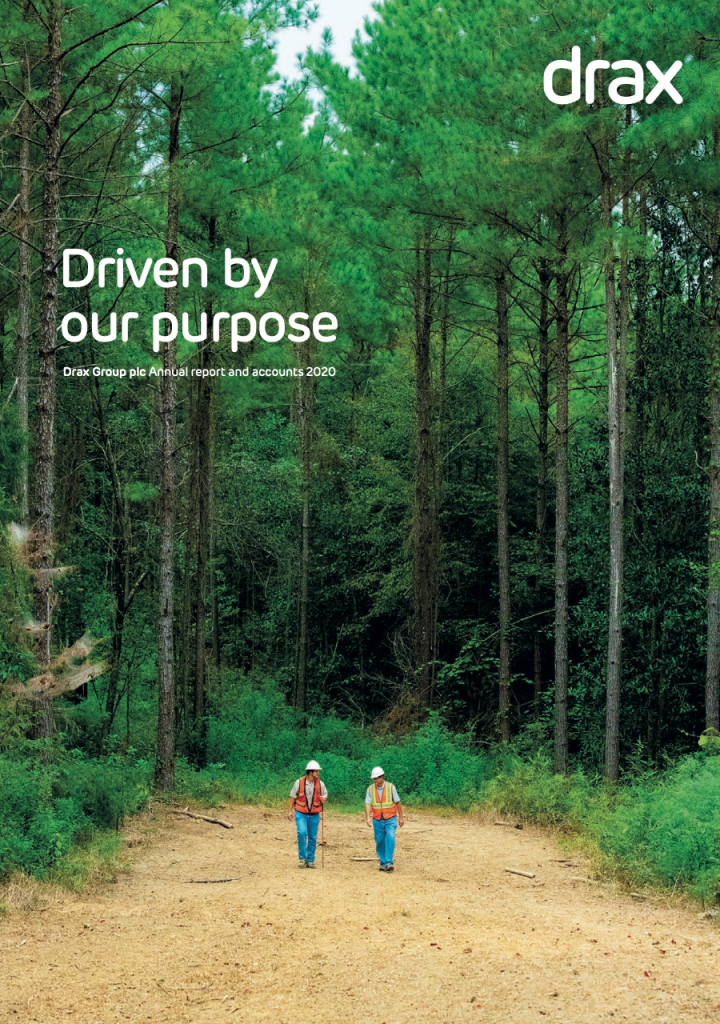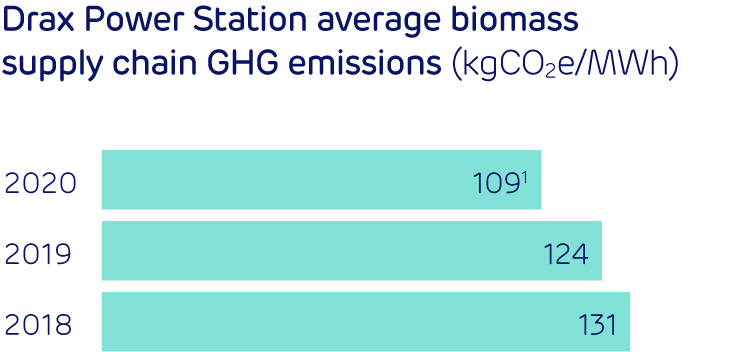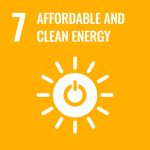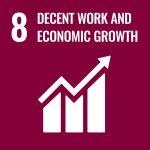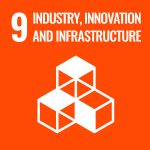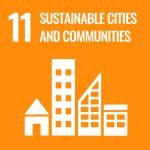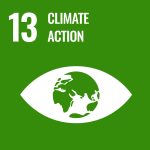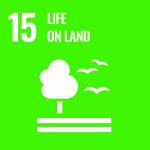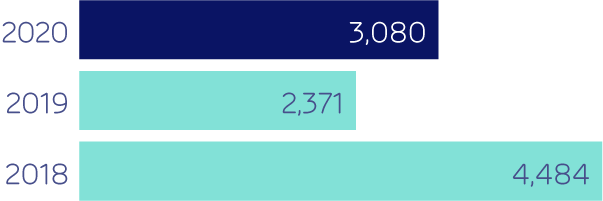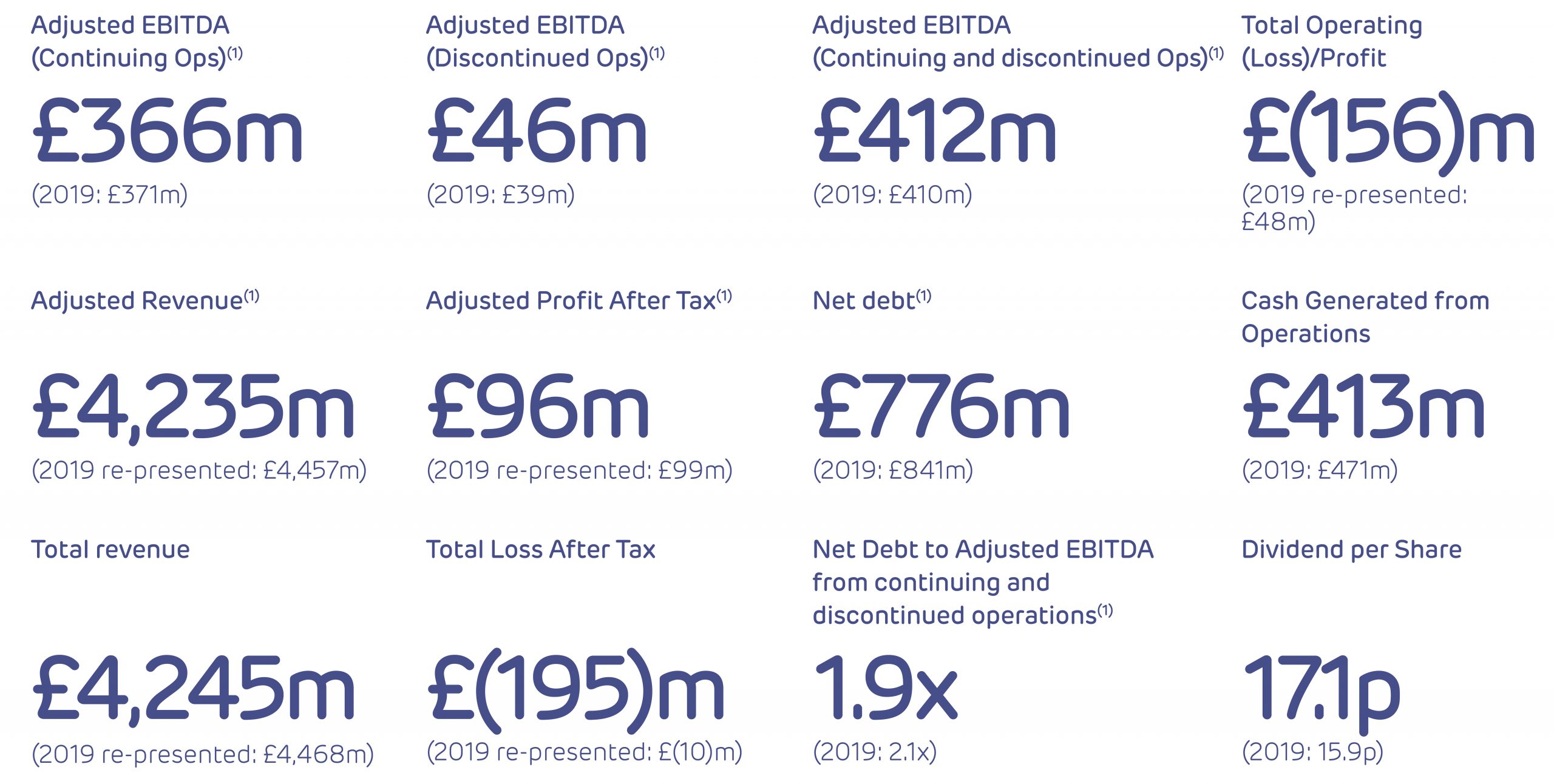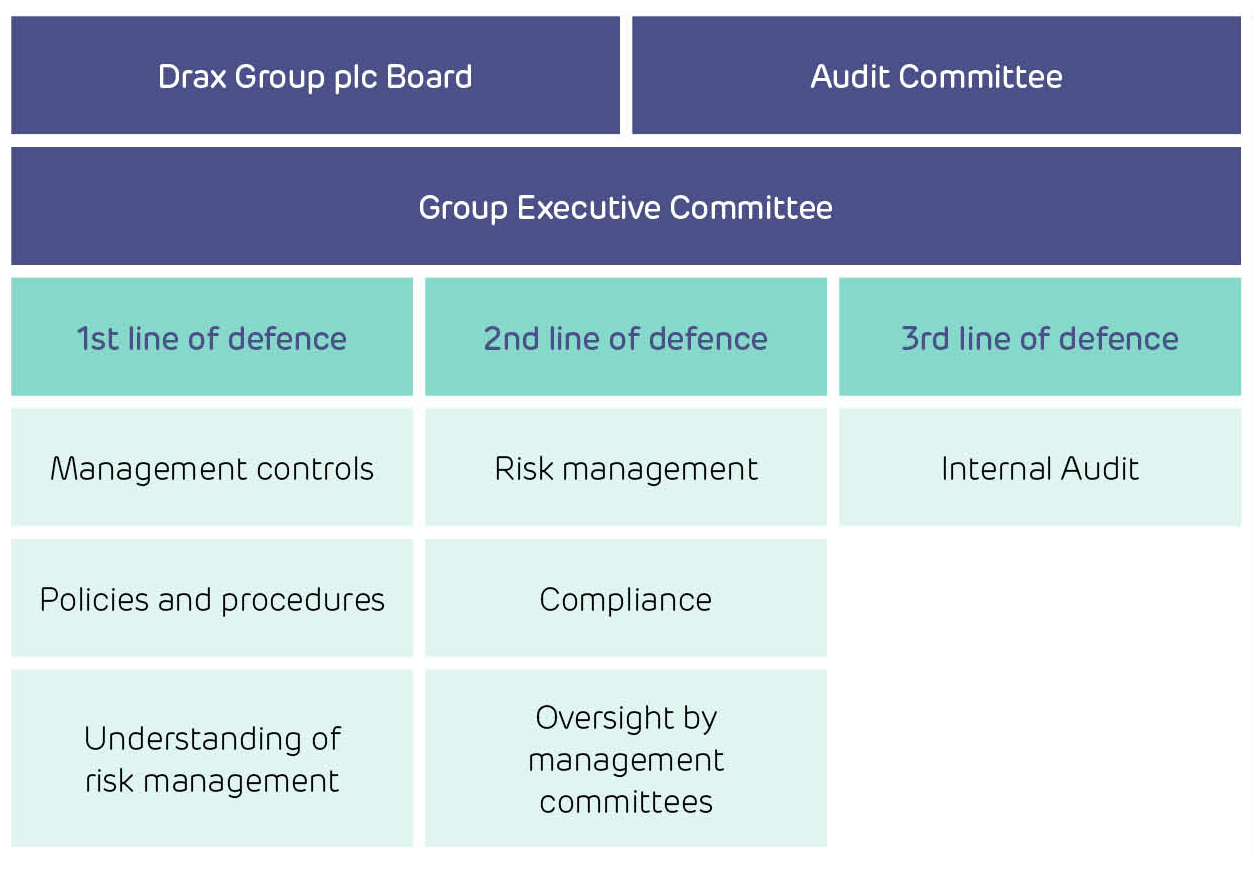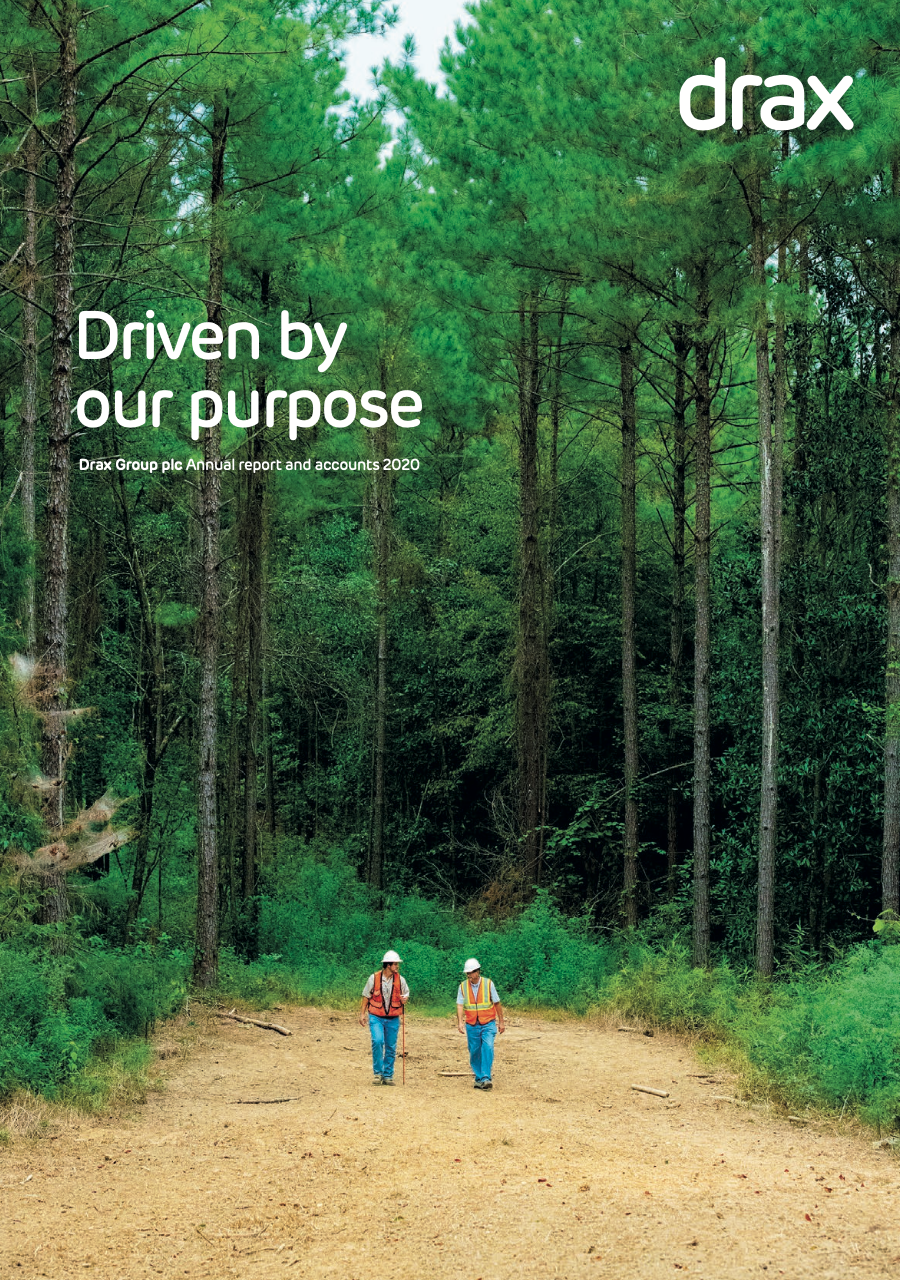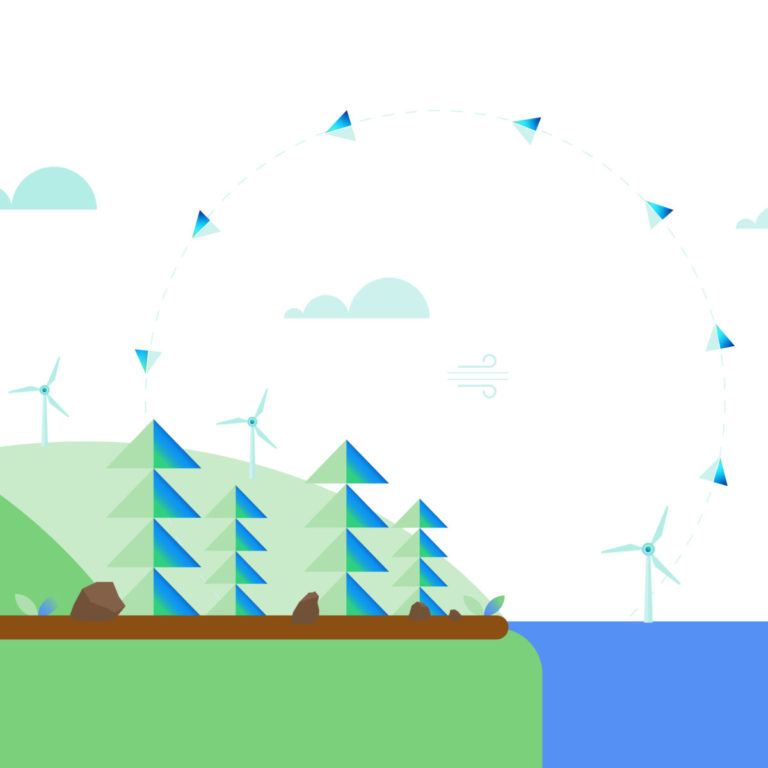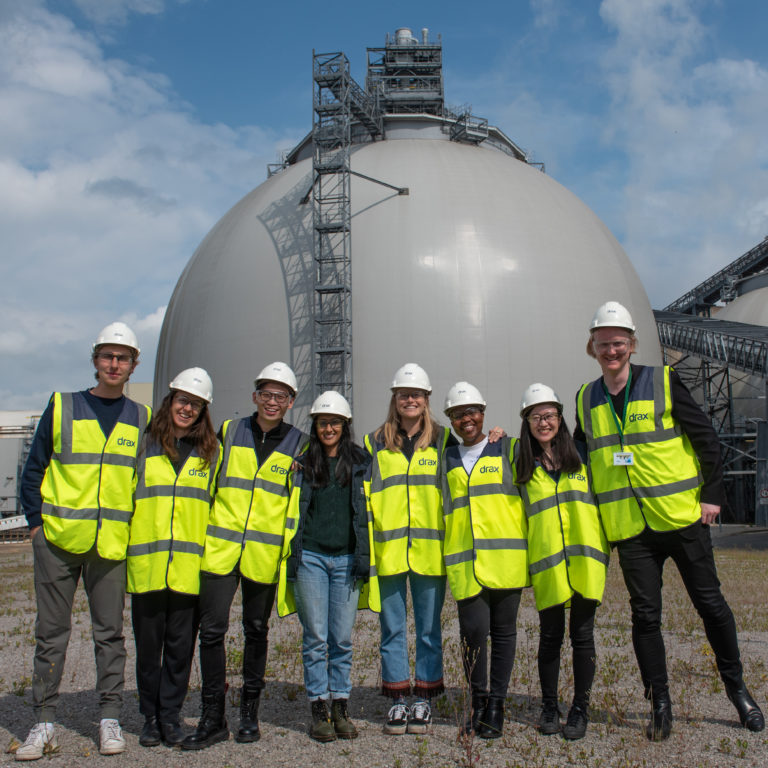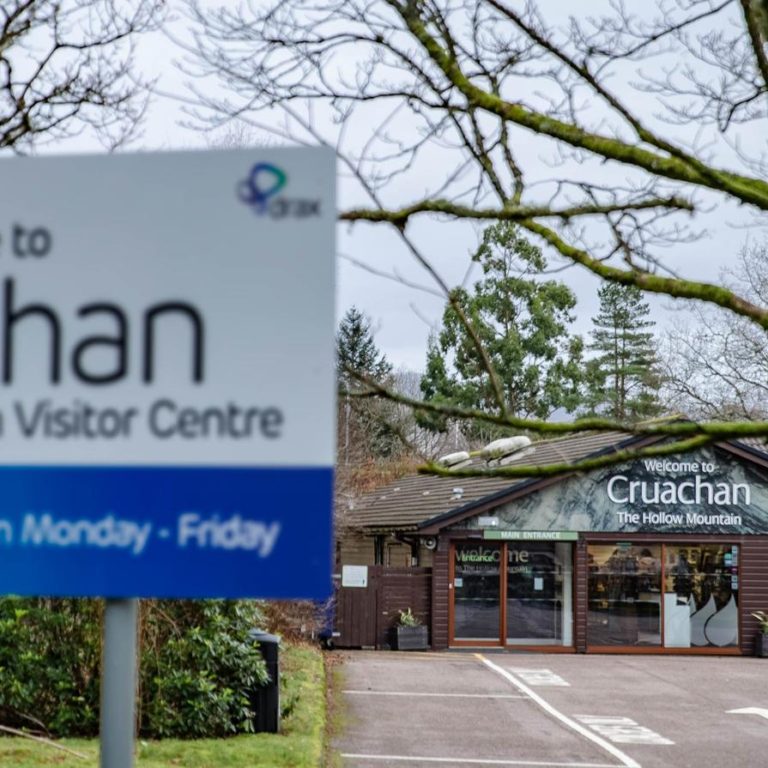Driven by our purpose
Chapter 1:
Welcome, 2020 highlights and market context
Welcome to Drax Group
Our purpose is to enable a zero carbon, lower cost energy future.
Our ambition is to become carbon negative by 2030. Being carbon negative means that we will be removing more carbon dioxide from the atmosphere than we produce throughout our direct business operations globally – creating a carbon negative company
Our strategic aims:
-
To build a long-term future for sustainable biomass
By expanding our sustainable bioenergy supply chain and reducing costs we are developing options for long-term biomass operations – renewable generation, negative carbon emissions, system support services and third party supply of biomass to international markets.
-
To be the leading provider of power system stability
Through a portfolio of flexible and renewable generation, and large industrial and commercial customer supply business, we will provide system support services to allow the power system to utilise intermittent renewable energy accelerating the UK’s decarbonisation en route to 2050.
-
To give our customers control of their energy
We provide our customers with renewable energy, and the opportunity to control and optimise energy use and cost, helping us support the energy system.
This webpage presents the Strategic Report section. View the full Drax Group plc Annual Report and Accounts PDF.
2020 highlights
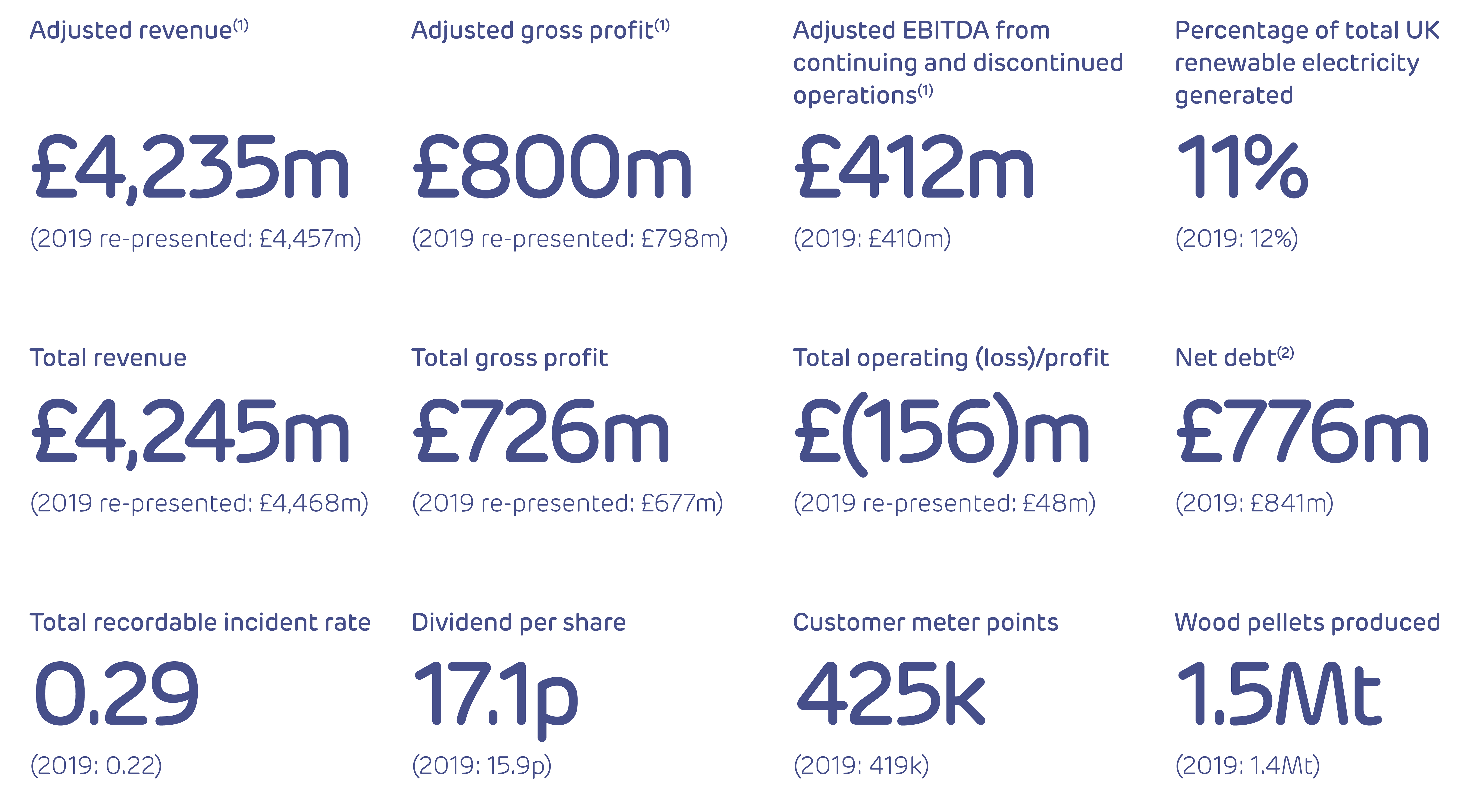
(1) We calculate Adjusted financial performance measures, which are specific to Drax and exclude income statement volatility arising from derivative financial instruments and the impact of items we consider to be exceptional, to provide additional information about the Group’s performance. Adjusted financial performance measures are described more fully on page 153, with a reconciliation to their statutory equivalents in note 2.7 to the consolidated financial statements on page 170. Throughout this document we distinguish between Adjusted financial performance measures and Total financial performance measures, which are calculated in accordance with International Financial Reporting Standards (IFRS). On 15 December 2020, the Group announced the sale of its portfolio of CCGT assets to VPI Holdings in a deal worth up to £193 million (see page 21), which subsequently completed on 31 January 2021. As a result of this transaction, the results of the CCGT portfolio for 2019 and 2020 have been classified as discontinued operations in the consolidated financial statements. References to financial performance measures throughout this annual report refer to continuing operations, unless otherwise stated. Further details, and a full reconciliation of continuing, discontinued and total financial performance measures is included in note 5.5 to the consolidated financial statements.
(2) We define net debt as borrowings less cash and cash equivalents. A reconciliation of net debt is provided on page 184. Borrowings is defined as per the Group’s balance sheet on page 156 and does not include lease liabilities, pension obligations or other financial liabilities.
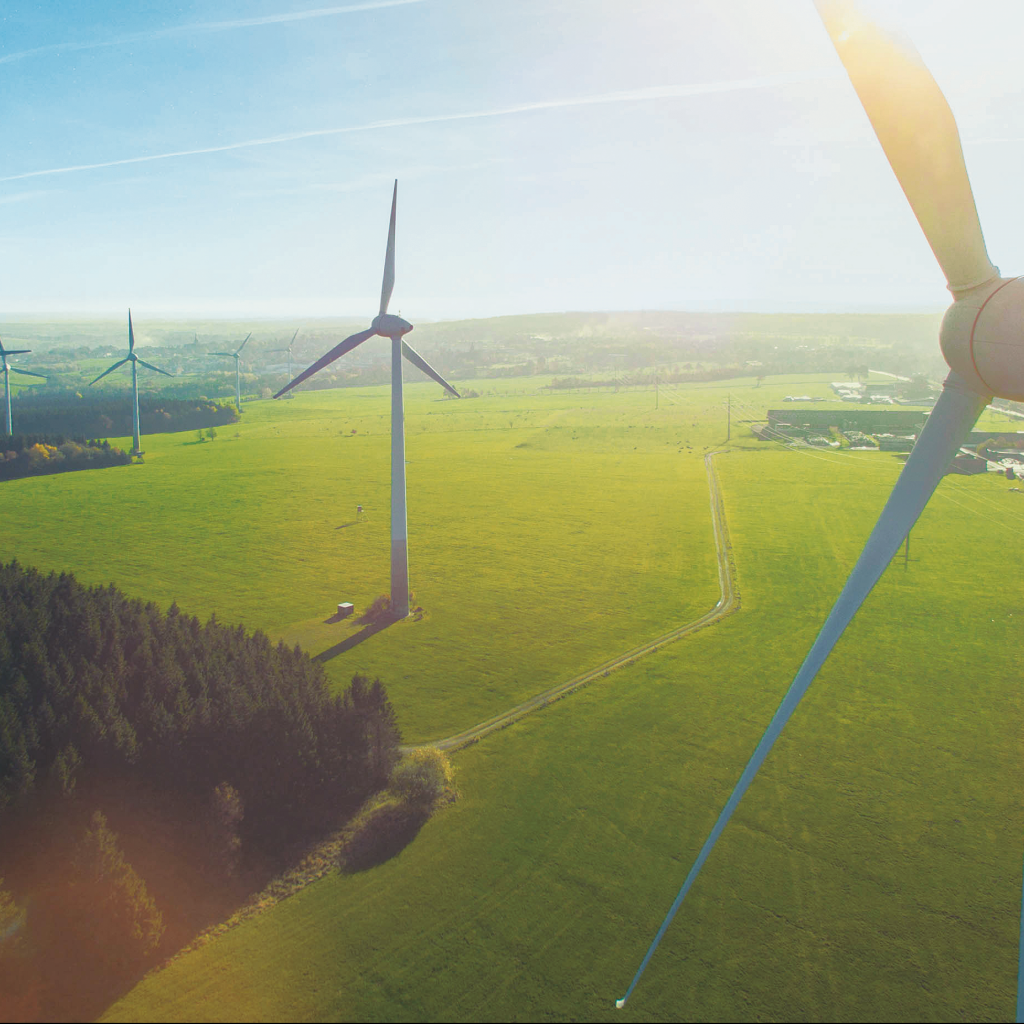
Market context
Why is Drax important in the market?
Supporting the nation’s energy needs, tackling climate change and promoting the UK’s socio-economic growth and global leadership ambition through negative emissions
Decarbonisation, electrification, the role of negative carbon emissions and a green recovery from Covid-19
2020 was widely expected to be a transformative year: the UK would leave – and seek a new relationship with – the European Union; the re-elected UK Government under Boris Johnson would implement a new vision and manifesto, including the levelling up agenda and COP26; and US elections in November would offer two very different domestic and international visions. But very few predicted why 2020 would become such a watershed year. The worldwide pandemic (Covid-19) fundamentally changed the world, with short- and long-term socio-economic consequences and global impact on health.
One issue didn’t change, however. Climate change, and the focus on a green economy and renewable power. Rather than the global crisis pushing the green agenda into the long grass, the general public reconnected with the environment during lockdowns, and governments saw the economic benefits of pushing a green recovery with moreaffordable green technology.
Net zero
UK and Globally
The UK continued to position itself as a world leader in decarbonisation.
The Prime Minister’s 10-point plan and Energy White Paper included low- carbon technologies such as offshore wind and carbon capture and storage.
Despite COP26 being postponed by a year, several major economies announced, reaffirmed or accelerated their net zero commitments. The EU set a new 2030 target for emission reduction to complement its target of carbon neutrality by 2050. South Africa, Japan and South Korea announced net zero emissions by 2050. China announced a carbon emission peak before 2030, with carbonneutrality by 2060. Joe Biden pledged to re-join the Paris Climate Agreement, proposing to make US electricity production carbon-free by 2035 and meet net zero by 2050.
Bioenergy carbon capture and storage (BECCS)
The UK’s Climate Change Committee highlighted in December 2020 that 53 MtCO2 of BECCS would be needed to meet net zero. National Grid set out in its 2020 Future EnergyScenarios (FES) report that BECCS was needed in the power industry in every scenario to achieve net zero in 2050 and could help the UK achieve a carbon negative power system as early as 2030.
The UK Government reaffirmed its commitment to Carbon Capture Usage and Storage, safeguarding and building on its £800 million budget commitment in a minimum of two clusters. In that context, it announced a call for evidence on the role of Greenhouse Gas Removal technologies (GGRs) including BECCS. This will inform key strategic decisions around the development, deliverability and cost of different GGRs, as well as the Government’s role in addressing marketbarriers, supporting policies and frameworks.
Flexibility and Stability
Intermittent renewable technologies such as solar and wind grew in 2020, helping decarbonise the power sector. However, this growth increased challenges for the stability of the UK’s electricity grid, caused by generation outages and low wind levels. National Grid twice issued an “Electricity Margin Notice” – a warning that the margin between electricity supply and demand on the system had tightened to critical levels – for the first time since 2016. This underscored the need to increase flexible generation and technologies, such as Drax’s pumped storage and biomass, to keep the system stable and balanced.
Electrification
According to National Grid’s FES report, electricity demand could double between now and 2050. One of the key components of net zero will be the substantialincrease in the electrification of various sectors of the economy, such as heat and transportation. With wind and solar technologies likely to supply the bulk of this generation, flexible technologies will play a role in managing their integration and constraints. The FES report estimates that up to 20 GW of hydrogen power and up to40 GW of storage (such as that provided by pumped storage hydro) could be required to balance the grid in 2050.
Drax Impact
Drax already plays an active role in decarbonising the energy system and providing stability and flexibility. Our strategic focus for a net zero future remains increasing pumped storage and sustainable biomass self-supply, whilst progressing BECCS to be carbon negative by 2030. We are also continuing to focus on giving our customers control of their energy.
Covid-19 and the Green Bounce Back
Energy
Covid-19’s global economic impact also affected the UK power market. In 2020 alone, the average wholesale power price fell 44%, with average electricity demand down by 13%. the costs of balancing the system rose 51% to £293 million whilst the share of renewables increased from 28% to 38.4%, with biomass increasing 8.4%and fossil fuel decreasing by 17.4%.
Green Economic Recovery
It has become increasingly clear that a Covid-19 socio-economic recovery in the UK will focus on green technologies and industries, using private finance to fund immediate and future priorities such as green infrastructure. This could create tens of thousands of jobs around the country, such as offshore wind, carbon capture and storage, and hydrogen.
Drax Impact
Drax can be at the heart of the green economic recovery in the North. Scaling up BECCS at Drax could support thousands of jobs during construction at its peak and contribute significantly to the local economy, according to a report from Vivid Economics, commissioned by Drax. Delivering the Zero Carbon Humber project could create and support tens of thousandsof jobs locally and throughout the supply chain, according to the report.
Many businesses will be remembered for their actions during the Covid-19 pandemic. At Drax, we generated good returns for shareholders, with a sustainable and growing dividend and increased share price, whilst “keeping the lights on”, avoiding furloughing employees and supporting our employees, customers and communities.
Global situation
COP26
COP26 in Glasgow was postponed to 2021 but offers potential to be a major success for the UK both domestically and internationally. The UK Government will want to showcase innovative decarbonisation technologies ahead
of COP26. This will be an opportunity for Drax to continue to explain how it can be part of a diverse green energy mix to meet net zero with innovative advancements technologically (through BECCS, CCS and hydrogen) and financially through new green finance models.
Biomass Acceptability
In the US, EU and in the UK, policy makers have continued to regulate biomass in the context of global and domestic efforts to meet net zero.
In the EU, the European Commission’s Green New Deal proposed a new biodiversity strategy and re-opening key legislation such as the REDII and EU ETS. In the UK, the Government announced it would begin work on a new bioenergy strategy – to be published in 2022. In the US, the EPA has been actively considering the carbon credentials of biomass.
The UK Government’s BEIS attitudes survey shows that public support for biomass continues to rise.
EU Carbon Targets
With the EU’s increased net zero ambition and timetable, biomass is likely to play a key role in helping the EU to meet its ambitious targets. This increased ambition will have implications for carbon pricing and could result in higher carbon prices in the UKeven after Brexit. The
UK announced a UK Emissions Trading Scheme (ETS) to replace the EU-ETS from 1 January 2021. The EU is also examining the potential to introduce a carbon borderadjustment where non-EU countries will be required to account for an implied carbon price to import goods into the EU.
Drax Impact
Despite Covid-19 challenges, Drax’s global supply chain for pellets has remained resilient. As in 2020, Drax will continue to engage with UK, EU and US policymakers on the role of biomass, through the BEIS biomass strategy, revision of REDII and new US administration.
In 2021, Drax is positioning itself as one of the business leaders for COP26 and will look to support the UK Government in its efforts to make this a success.
Chapter 2:
Business Model
Climate change is the biggest challenge of our time. Drax’s purpose – to enable a zero carbon, lower cost energy future – puts us at the heart of addressing this global challenge.
Click to view/download graphic here.
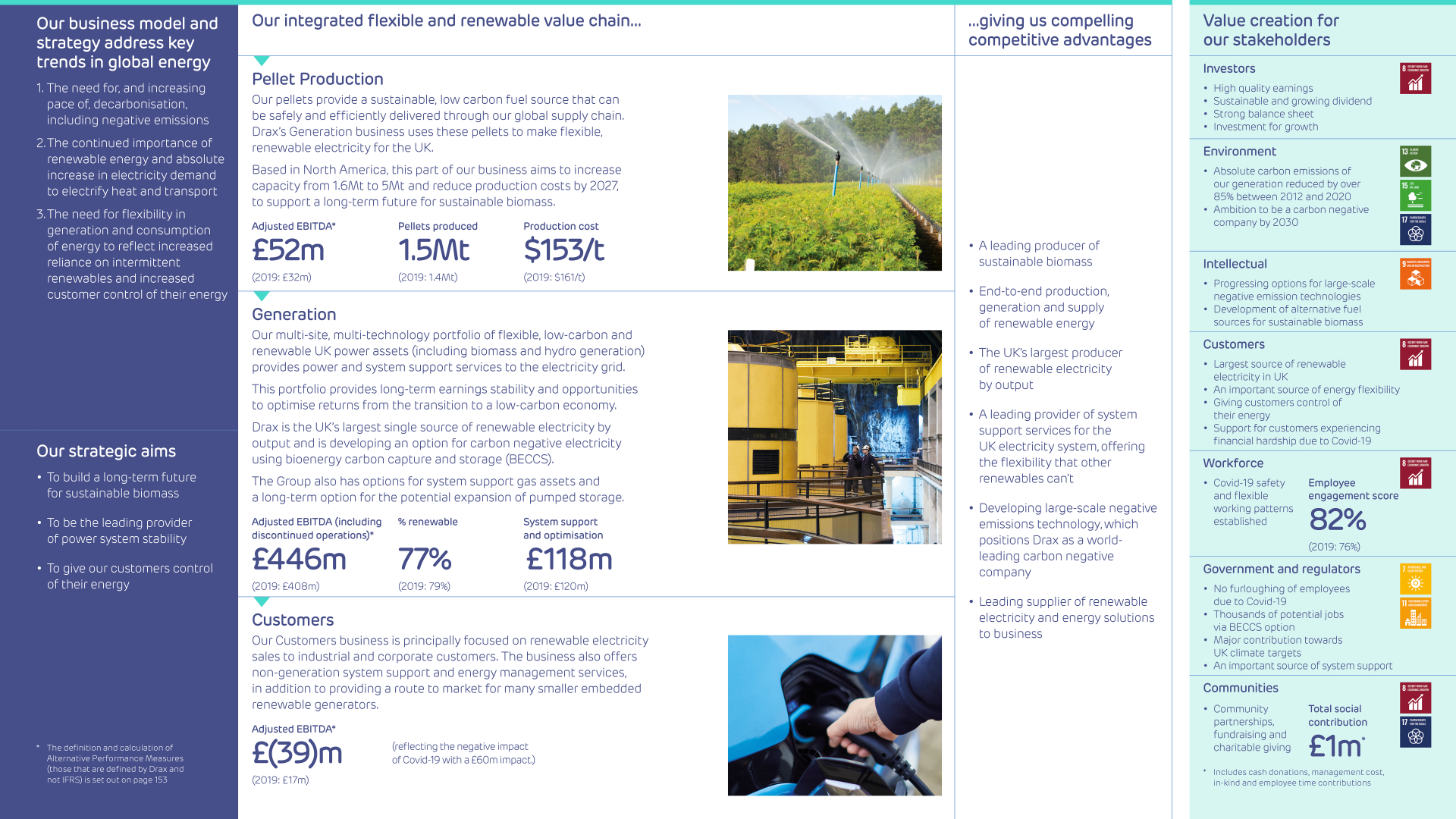
Chapter 3:
ESG highlights
At Drax, we believe that achieving a positive economic, social and environmental impact is key to delivering long-term value creation.
Environment
Since 2012, Drax has reduced its absolute scope 1 and 2 carbon emissions by more than 85%. Our ambition is to become a carbon negative company by 2030.
Renewable generation (%)
UK’s largest source of renewable electricity
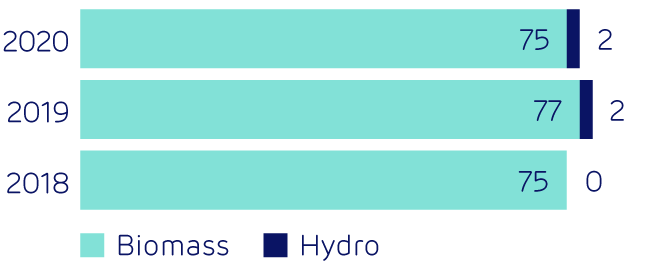
Power generation mix in 2020
(% total output)
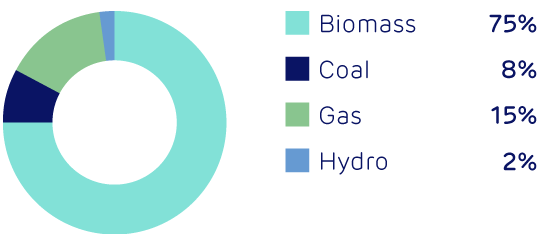
Electricity supplied to customers from renewable sources (%)
UK’s largest supplier to business

Group carbon intensity
(tCO2e/GWh)

Group carbon emissions, scope 1 & 2
(ktCO2e)
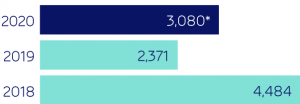
Social
Creating a safe, fair and inclusive place to work, and making a positive contribution in the communities where we operate.
Total Recordable Incident Rate
(TRIR)

Gender diversity, total workforce
(%)
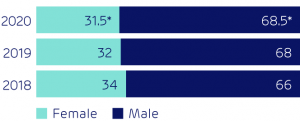
Governance
Clarity of purpose, a positive culture and strong governance enable us to deliver for our stakeholders. Remuneration is based on long-term performance and linked to Environmental, Social and Governance (ESG) metrics, including our performance in the CDP.
Board composition
Executive Directors/Non-Executive Directors (%)
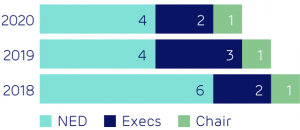
Gender diversity (%)
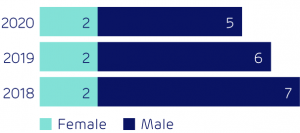
* Limited external assurance using the assurance standard ISAE 3000 for 2020 data as indicated.
For assurance statement and basis of reporting see www.drax.com/uk/sustainability
Biomass Sourcing
Sustainably sourced biomass is CO2 neutral under scientific principles established by the UN Intergovernmental Panel on Climate Change.
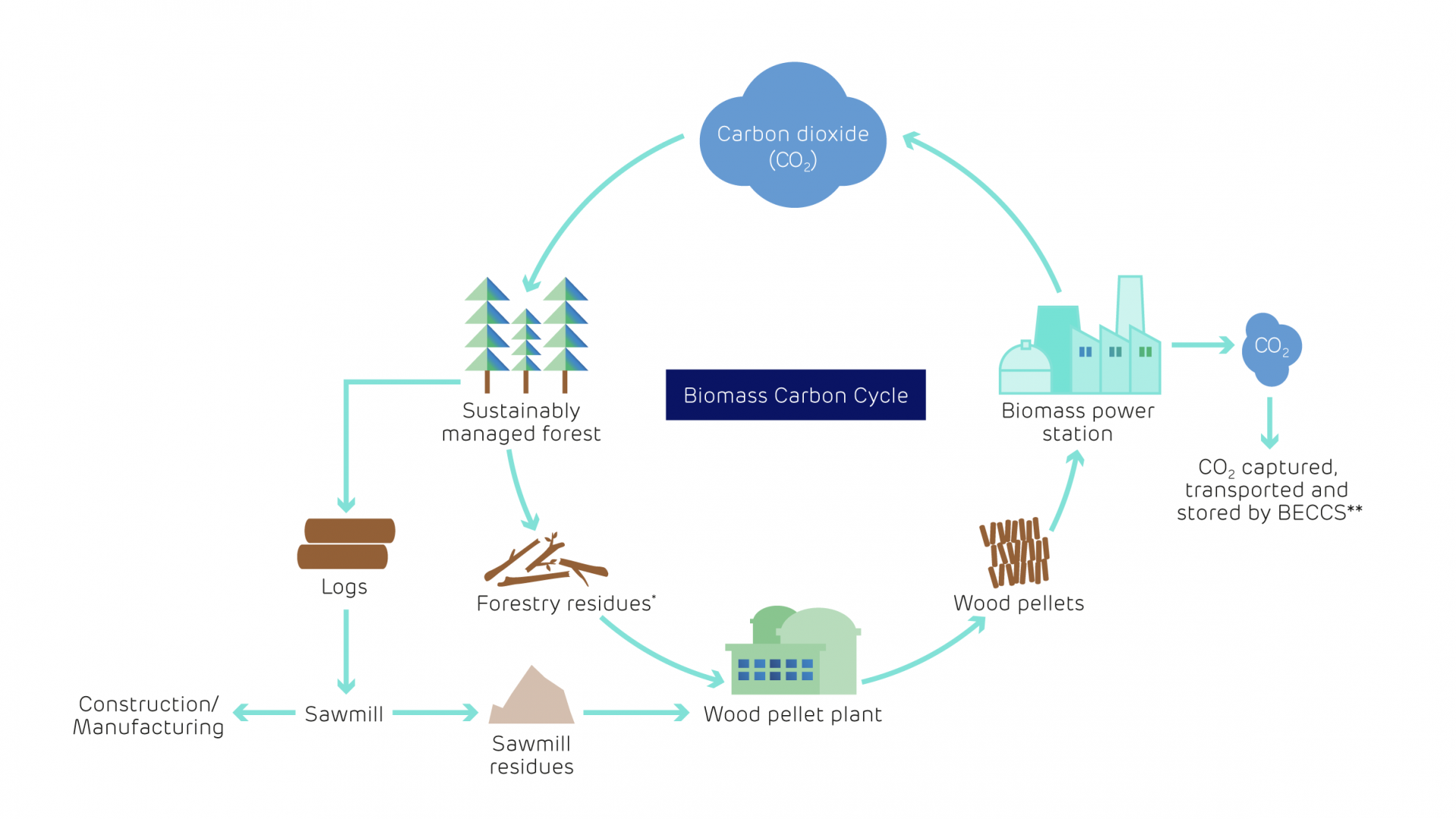
* Forestry residues includes branch tops and bark, thinnings and low-grade roundwood. For more information, see Sourcing Sustainable Biomass on page 53
** BECCS is bioenergy with carbon capture and storage, enabling the capture of CO2 resulting from generation, which is stored in an aquifer under the North Sea
100% sustainably sourced
• Wood pellets sourced from sustainably managed working forests and residues from forest industries
• Sustainability Policy and Responsible Sourcing Policy outline our requirements and commitments
• Supplier compliance evidenced by Sustainable Biomass Program (SBP) certification or third party audits
99% Woody biomass sourced by Drax in 2020 that was SBP compliant
(1) Limited external assurance by Bureau Veritas using the assurance standard ISAE 3000. For assurance statement see www.drax.com/uk/sustainability
ESG rating performance

UN Sustainable Development Goals (SDGs)
We believe we can have the most impact in these areas:
Chapter 4:
Chair's Statement and Group CEO's review

Chair’s Statement
 Managing Covid-19 impact Keeping colleagues safe remained paramount throughout the pandemic:
Managing Covid-19 impact Keeping colleagues safe remained paramount throughout the pandemic:
-
Focused on the health, safety and wellbeing of colleagues and those we work with
-
Continued to pay our sustainable and growing dividend
-
Supported customers, including help with debt and the freezing of payments
-
Supported our communities
-
No Covid-19 financial support from the Government, and no furloughing of employees
![]() Find out more on page 34 of the full report PDF.
Find out more on page 34 of the full report PDF.
How are we planning to become carbon negative by 2030?
With the right negative emissions framework from the UK Government, we aim to become a carbon negative company by 2030. We believe BECCS technology could have global application in the delivery of negative carbon emissions
Introduction
Drax Group’s purpose is to enable a zero carbon, lower cost energy future.
This informs our strategy of building a long-term future for sustainable biomass, becoming the leading provider of electricity system stability in the UK, and giving customerscontrol of their energy.
Since 2012, we have reduced Drax’s carbon emissions by over 85%, principally reflecting our long-term investment in sustainable biomass. During the year we made further progress, announcing in February 2020 an end to commercial coal generation effective in March 2021. In January 2021, we completed the sale of our gas generation portfolio, further reducing our carbon emissions. More recently, on 8 February 2021, we announced the proposed acquisition of Pinnacle Renewable Energy Inc., which is expected to position Drax as the world’s leading biomass generation and supply business, alongside the continued development of Drax’s ambition to become carbon negative by 2030.
The proposed acquisition is subject to shareholder approval and certain court and regulatory approvals.
There remains more we can do to reduce carbon emissions. With the right negative emissions framework from the UK Government, we aim to achieve our ambition to become a carbon negative company by 2030 using BECCS technology. We believe this technology could have global application in the delivery of negative carbon emissions.
Through these activities, we expect to play a major role in delivering the UK’s legally binding objective to achieve net zero carbon emissions by 2050 and support global efforts to reduce carbon emissions.
Operations, Covid-19 and supporting stakeholders
2020 witnessed the outbreak of Covid-19 with unprecedented global impact. For Drax, the safety and wellbeing of colleagues remained paramount. The Board held additional meetings, overseeing the Group’s response, understanding the impacton colleagues, customers, communities andother stakeholders.
As a strategic part of the UK’s critical national infrastructure, we recognise our responsibility to support the country’s response to Covid-19 and our stakeholders.We maintained high levels of power generation throughout 2020, and we did not seek any Covid-19 financial support from the UK Government, nor did we furlough any employees.
We provided extra support to our customers, particularly the small and medium-size enterprises (SMEs) that were adversely affected. We froze energy payments from care homes in communities local to Drax and offered debt support to customers. We supported our communities in the UK and US with charitable donations and provided over 850 free laptops to enable home learning for students in our communities.
Throughout the pandemic, we have continued to engage with shareholders to explain our expectations of the impact of Covid-19 on the Group and the Board has considered their feedback.
Operationally, our generation portfolio performed well. In 2020, the Group was the largest source of renewable electricity by output in the UK, providing 11% of the total from its biomass and hydro generation assets. We also provided the system support services and operational flexibility required to help maintain grid stability during the Covid-19 induced changes to power demand. Additionally, we completed two major outages on our gas and biomass assets, with the latter including a turbine upgrade which will help contribute to our strategy to reduce the cost of biomass.
Sustainable biomass has a long-term role to play in the UK and global energy markets, both as a flexible and sustainable source of renewable energy, and as a means of delivering negative carbon emissions. Key to securing this long-term role is reducing the cost of biomass and growing our supply chain. We believe these actions will deliver attractive returns to shareholders and enable a long-term future for sustainable biomass, which could include negative carbon emissions via BECCS.
Our Customers business, which supplies electricity and gas to businesses in the UK, experienced significant challenges associated with the impact of Covid-19. The SME market suffered most from this impact, with lower energy demand and, in some cases, an increase in business failures. Throughout the year, our teams have focused on supporting customers as well as working to deliver improvements. We continue to monitor the situation and assess the options for this part ofthe business.
Results and dividend
Adjusted EBITDA in 2020, including both continuing and discontinued operations, was £412 million (see page 22 for further detail and a reconciliation to relevant IFRS measures). This was a small increase on 2019 (£410 million), despite the impact of Covid-19, which was principally associated with the performance of our Customers business. We believe this was a strong performance within the context of a challenging environment.
At the 2020 half year results, we confirmed an interim dividend of £27 million (6.8 pence per share). The Board proposes to pay a final dividend in respect of 2020 of £41 million, equivalent to 10.3 pence per share, making the full year 2020 dividend £68 million (17.1 pence per share) (2019: £63 million, 15.9 pence per share). This represents a 7.5% increase on 2019 and is consistent with our policy to pay a dividend which is sustainable and expected to grow as the strategy delivers stable earnings, strong cashflows and opportunities for growth.
In determining the continued appropriateness of the dividend, the Board considered a range of factors. These included trading performance, current liquidity, the outlook for the year in the context of Covid-19, as well as the steps being taken to support all stakeholders. The Board believes payment of the final dividend remains consistent with the Group’s commitment to all stakeholders.
The Group has a clear capital allocation policy which it applied throughout 2020. In determining the rate of growth in dividends from one year to the next, the Board will take account of cash flows, the less predictable cash flows from the Group’s commodity-linked revenue streams and future investment opportunities. The latter includes our stated intent to invest to expand the Group’s biomass supply chain andreduce the cost of biomass. If there is a build-up of capital, the Board will consider the most appropriate mechanism to return this to shareholders.
“During 2020 we supported stakeholders in response to Covid-19, and maintained high levels of power generation throughout the year”
Philip Cox, CBE Chair
People and values
The Board is committed to building a supportive, diverse and inclusive working environment where all colleagues feel they belong. To underpin this, in September we launched a new Diversity and Inclusion Policy and approach.
Listening to employees and ensuring a two-way dialogue is vital to understanding where we are doing well and where we can improve. In 2020, we asked employees for feedback on our values and their experience of working at Drax – which informed the evolution of our values – an important part of engagement as Drax continues to develop and change. Will Gardiner, our CEO, and I met regularly with the chairs of our workforce engagement forums. These meetings provided valuable ongoing insights and feedback for the Board in a period of significant change. This helped us to support the business in managing the transition to remote working and ensuring the safety and wellbeing of our workforce. On behalf of the Board, I would like to thank Will and the executive team for their leadership during this extraordinary year and all of our employees who have responded so well to the challenges presented in 2020.
Safety is a long-held and central commitment of our operational philosophy. While the number of incidents is low, we need to remain vigilant and work to reduce them. We are committed to the highest standards and have continued our efforts to strengthen our approach across the Group.
Sustainability is at the heart of what we do and we believe that achieving a positive economic, social and environmental impact helps us create long-term value. We remain committed to promoting the UN Global Compact principles on respect for human rights, labour rights, the environment and anti-corruption.
Board changes
In April 2020, Andy Koss stepped down from the Board after four years as an Executive Director and 15 years with the Group. I would like to thank Andy for his valuable contribution to the Group in this period.
Conclusion
In 2020 we delivered a strong financial and operational performance in the context of the very challenging environment caused by Covid-19, supported our stakeholders and continued to pay a sustainable and growing dividend in line with our policy.
At the same time, we continued to make progress with our strategic objectives. Our biomass strategy is clear; we believe it can deliver sustainable long-term value to our stakeholders as we realise our purpose of enabling a zero carbon, lower cost energy future and we remain focused on this objective.
Philip Cox CBE
Chair
Group CEO’s Review

How has Drax performed in 2020?
We have delivered a robust performance, supporting our employees, communities and customers and made good progress in delivering on our strategy
2020 highlights
-
Adjusted EBITDA of £412 million from continuing and discontinued operations(1)
-
Strong balance sheet and liquidity
-
Sustainable and growing dividend
-
Increase in biomass self-supply and reduction in cost
-
Strong system support performance
-
Sale of gas generation portfolio completed in January 2021 and expected end of commercial coal generation in March 2021
-
Proposed acquisition of Pinnacle Renewable Energy Inc.
(1) See page 22 for further detail and a reconciliation to relevant IFRS measures.
Drax Group’s purpose is to enable a zero carbon, lower cost energy future. To deliver that purpose, our strategy is to build a long-term future for sustainable biomass, become the leading provider of system stability in the UK and give customers control of their energy.
Our purpose also drives our commitment to the battle against climate change. Since 2012 we have reduced the Group’s carbon emissions by over 85%, we are the UK’s largest renewable energy generator by output and have an ambition to become a carbon negative company by 2030.
Operationally, 2020 was a successful year, as we delivered increases in pellet production and increased availability across our generation fleet, in spite of the challenges we faced due to the Covid-19 pandemic. Our colleagues have responded tremendously to those challenges, with operational staff on site at power stations and pellet plants working in a safemanner, while the rest of our colleagues have had to work from home. As a result, we have had a limited number of Covid-19 cases although, sadly, one colleague in the US died with the virus.
Strategically, 2020 was a pivotal year for the Group. In February 2020 we announced an end to commercial coal generation, effective in March 2021. In January 2021 we completed the sale of our gas generation portfolio, which was announced in December 2020. Following these actions we believe our carbon emissions will be amongst the lowest of any European energy company.
As we work towards our purpose we continue to develop our options for BECCS, which we believe can become a world leading, UK-ledand exportable solution for large-scale carbon negative power generation. Subject to the right negative emissions framework from the UK Government, we expect to be in a position to make further investment in the development of this option in 2021 and to advance our ambition to become acarbon negative company by 2030.
In February 2021, we were pleased to announce the proposed acquisition of Pinnacle Renewable Energy Inc. (Pinnacle) which we believe will position Drax as the world’s leading biomass generation and supply business, delivering against our strategy to increase our self-supply capability, reduce our biomass production cost and create a long-term future for sustainable biomass. Completion of the proposed acquisition is subject to shareholder consents and the satisfactionof certain conditions precedent.
As we advance our strategy, we expect to deliver higher quality earnings, reduce commodity exposure and create opportunities for growth aligned with the UK’s legally binding objective to become carbon neutral by 2050. This underpins our continued commitmentto a sustainable and growing dividend.
Summary of 2020
Adjusted EBITDA, a key financial KPI, of £412 million from continuing and discontinued operations represents a small increase on 2019 (£410 million), inclusive of an estimated £60 million impact associated with Covid-19, principally on our Customers business. We believe that this was a strong underlying performance which reflects increased pellet production, biomass cost reduction and renewable power generation,offsetting the impact of Covid-19 on the Customers business. The Total Operating loss for the year was £156 million, predominantly reflecting asset obsolescence charges and provisions for other costs following the announcement of the closure of coal generation at Drax Power Station.
Our balance sheet is strong with cash and total committed facilities of £682 million at 31 December 2020 and net debt of £776 million giving a ratio of 1.9x net debt to Adjusted EBITDA from continuing and discontinued operations for the full year, in line with our long-term target.
During the year we completed a series of financing activities that extend the maturity of our debt to 2030 and reduce the cost of our debt whilst retaining the link between carbon emissions and the level of interest paid via a new ESG-linked revolving credit facility (RCF).
In further recognition of the progress we have made on ESG performance, in December 2020 the CDP awarded Drax an A- rating for our CDP climate response (2019: C). Separately, we are now a TCFD Supporter and we reflect that framework in this report.
Safety remains a primary focus. Since March 2020 our operational colleagues, working at power stations or pellet plants, have had to work in new ways to protect against outbreaks of Covid-19 on site, while maintaining our contribution to the integrity of the UK power system. I am very pleased with everyone’s efforts in this area and that we did not have any outbreaks of Covid-19 at our sites in 2020.
In this context, the Total Recordable Incident Rate (TRIR), a key scorecard measure of safety, was 0.29 (2019: 0.22). This was not the level we expect. Although there were no major incidents, the number of minor reportable injuries did increase. We take any increase in the number of reportable incidents seriously and have implemented processes to improve risk assessment, alongside a campaign to raise awareness of good practice, ensuring the correct personal protective equipment is used.
Operational performance
In the US southeast, our Pellet Production operations reported Adjusted EBITDA of £52 million up 63% (2019: £32 million). This was a strong performance, reflecting increased levels of production, improved pellet quality and a continued focus on cost reduction.
Pellet production was 1.5 million tonnes (Mt), an increase of 7% (2019: 1.4Mt), which reflects a strong operational performance and good fibre availability compared to 2019 when heavy rainfall restricted commercial forestry activity.
Pellet quality, as measured by the level of fines (larger particle-sized dust) in each cargo improved in 2020. Lower levels of fines result in biomass that is easier and safer to handle throughout the supply chain. As such there are safety, operational and cost benefits in reducing the level of fines and we continue to work hard to deliver these improvements.
We remain focused on opportunities to deliver savings, across the supply chain, as part of our target to reduce the cost of biomass to £50/MWh on 5Mt by 2027.
As a part of this long-term goal we previously identified an intermediate programme of supply chain improvements, efficiencies and investments. We believe this will reduce the cost of biomass by $35/tonne (£13/ MWh) on our existing portfolio by 2022 compared to 2018 (programme commenced in 2019). In 2020 this programme, alongside increased output and other incremental operational improvements, resulted in an average production cost of $153/tonne (2019: $161/tonne), a 5% saving year-on-year.
We expect to deliver further savings, as a part of this programme, by expanding our existing sites (LaSalle, Morehouse and Amite) by 0.4Mt. At the end of 2020 we completed the first phase of these – 0.1Mt at Morehouse – with the remaining capacity of 0.3Mt expected to come on stream by 2022. Realising these programmes will expand total capacity to 1.9Mt, providing economies of scale and allowing greater utilisation of low-cost residues.
“In January 2020 we announced an end to commercial coal generation in March 2021 and in January 2021 we completed the sale of our gas generation portfolio. This will further reduce the Group’s carbon emissions and we will use the proceeds to continue developing our biomass supply chain strategy.”
Will Gardiner, CEO
In February 2020 we announced plans to further expand our existing infrastructure with the development of three new 40,000 tonne satellite plants. These sites will use lower cost sawmill residues and leverage our existing infrastructure in the US southeast to produce biomass at around 20% below the current cost of production. We believe this model could provide 0.5Mt per annum of additional lower-cost biomass and that these projects advance the Group’s plans to create a long-term future for sustainable biomass, offer returns significantly ahead of the Group’s cost of capital and attractive payback periods.
In Generation, the portfolio has performed strongly, with Adjusted EBITDA of £446 million from continuing and discontinued operations, an increase of 9% compared to 2019 (£408 million). The portfolio produced 6% of the UK’s electricity between October 2019 and September 2020 (the most recent period for which data is available) and 11% of the UK’s renewable electricity, making Drax the largest renewable generator by output in 2020.
This level of renewable generation is only possible thanks to a combination of portfolio availability and a resilient supply chain.
Portfolio availability (calculated based on the availability of each generation asset weighted by EBITDA contribution) was 91% (2019: 88%). Underlying this performance is a robust maintenance regime. During the year we completed major planned outages at Damhead Creek and Drax Power Station. The latter included the second in a series of high-pressure turbine upgrades across three biomass units which will deliver incremental thermal efficiency improvements and lower maintenance costs, reducing the cost of our biomass power generation. The final outage on the unit which operates under the contracts for difference (CfD) scheme is scheduled to take place in 2021.
The logistical challenges of these major works, in a Covid-19 operating environment, are significant. We delivered the outages with minimum delay thanks to the diligence, skill and hard work of our teams and contractors.
Our biomass supply chain performed well and to date there has been no material impact from Covid-19 or Brexit on our supply chain or those of our key suppliers.
Our Scottish hydro operations – Cruachan Pumped Storage Power Station (Cruachan), and the Lanark and Galloway hydro schemes – have performed well. These assets provide renewable electricity, system support services, peak power generation and Capacity Market income. Taken together with the Daldowie energy from waste plant, Adjusted EBITDA was £73 million (2019: £71 million).
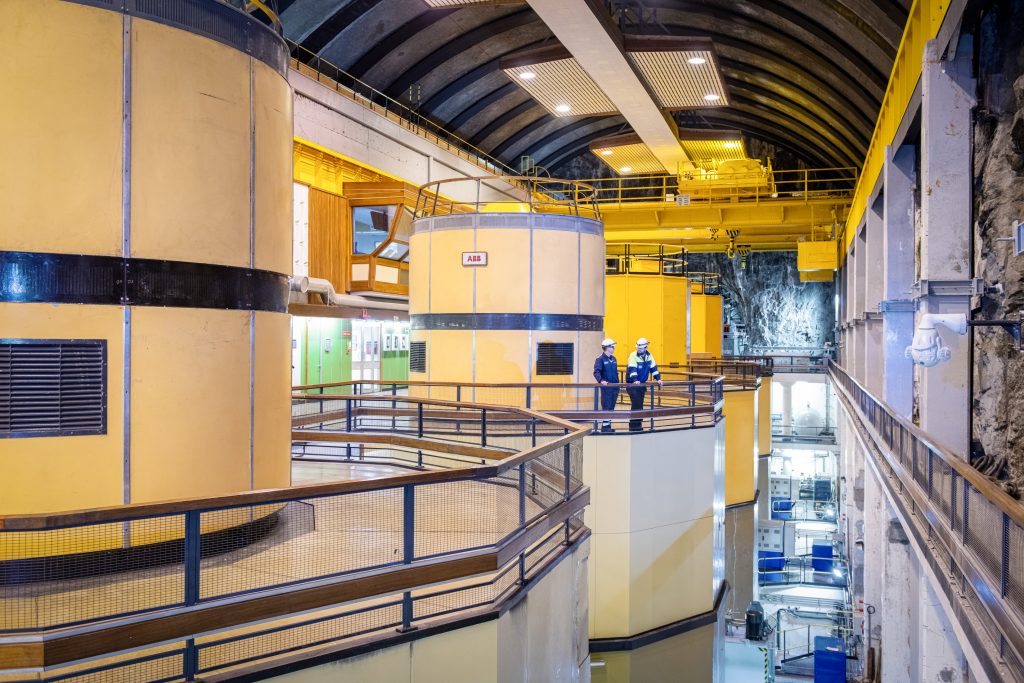
Engineers look out from beside a turbine within Cruachan Power Station in Scotland
System support services (Balancing Market, ancillary services and portfolio optimisation) are an important part of the Group’s strategy. They are also critical to the safe and reliable operation of the power system. Historically, baseload thermal power plants provided both electricity and a full range of system support services. As the UK power system decarbonises, intermittent renewable generation has progressively displaced these assets, creating new challenges in balancing the system.
Throughout 2020 our portfolio supported the system operator in managing the impact of Covid-19 on power demand. In the first half of 2020, a reduction in demand for electricity required flexible generators, like Drax, to turn-down and stabilise the system. In the second half of 2020, a combination of cold weather, lower wind speed and asset availability issues led to periods of increased demand. At these times, our flexible assets were able to increase output to help balance the system.
System Support Services and Optimisation – our measure of performance in the provision of these services was gross profit of £118 million, a small reduction on 2019 (£120 million), which included income from specific constraint contracts which were not expected to recur in 2020.
Cruachan, an important source of system support, was successful in a tender process to procure specific non-generation services – inertia and reactive power. The contract, which commenced in July 2020, is worth up to £5 million per year and is over a six-year period. This was the first tender of its kind and we expect the system operator to conduct further tenders over the coming years.
Merchant power prices remain an important part of the Group’s earnings, but by focusing on flexible and renewable generation, the importance of merchant power prices has reduced. We have a strong forward power sales position in place until 2022. Beyond this date, whilst an exposure exists, it is largely associated with the three biomass units which operate under the Renewable Obligation Certificate (ROC) scheme.
In January 2021, following the UK’s exit from the European Union, the UK introduced a new carbon emissions trading scheme to replace the existing European scheme to which the UK no longer has access. We believe that robust carbon pricing is essential for decarbonisation and an important component of long-term power prices. With a growing level of interconnection between the UK and continental Europe as well as growing ambition in terms of EU energy policy we believe that in the long-term UK carbon and power prices could trend towards European prices. We also believe that with greater demand for system support services, near-term power prices could become more volatile – driven by system support service requirements rather than commodity market fundamentals.
The end of commercial coal operations in March 2021, and final closure of the generating units in September 2022, is expected to result in annual cost savings of £30-35 million once complete. We believe that this will help to support the financial model for long-term biomass generation at Drax Power Station when the current renewable subsidy schemes end in March 2027. An employee consultation process was completed in 2020. Implementing the changes will result in the reduction of 206 roles and one-off costs of £34 million.
Our Customers business reported a loss at the Adjusted EBITDA level of £39 million (2019: £17 million profit). This reflects the significant reduction in demand caused by Covid-19, the cost associated with exiting hedged positions as market prices have fallen and the increased risk of business failure and bad debt – principally in the SME market, around 30% of monthly billing. Looking beyond the impact of Covid-19 we will continue to monitor the wider Customer portfolio to ensure alignment with the Group’s strategy.
Performance in Industrial and Commercial markets was stronger with the addition to the portfolio of long-dated power sales contracts to water utilities, providing revenue visibility over the next five years. Just as the Generation business provides system support services, so too can our Industrial and Commercial customer portfolio. Over time, we expect that this part of the Group, through efficiency and demand-side response, can contribute increasingly to the Group’s system support services alongside generation. We continue to believe this approach will support long-term growth.
The Customers business has a differentiated market position – selling purely renewable power while helping over 2,000 independent renewable generators access the market.
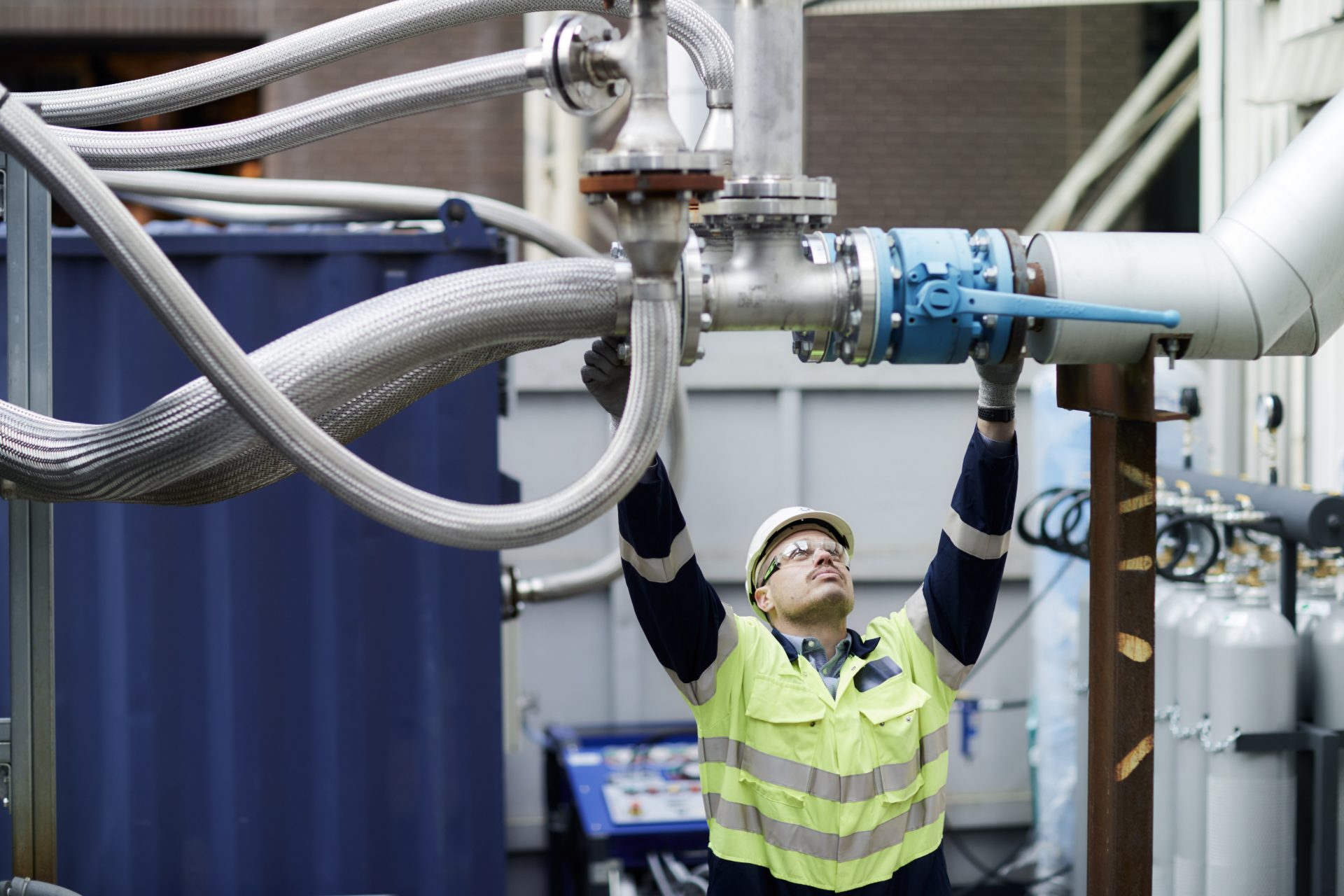
Innovation engineer inspecting CCUS incubation area BECCS pilot plant at Drax Power Station, 2019
“We believe our carbon emissions will be amongst the lowest of any European energy company”
Will Gardiner, CEO
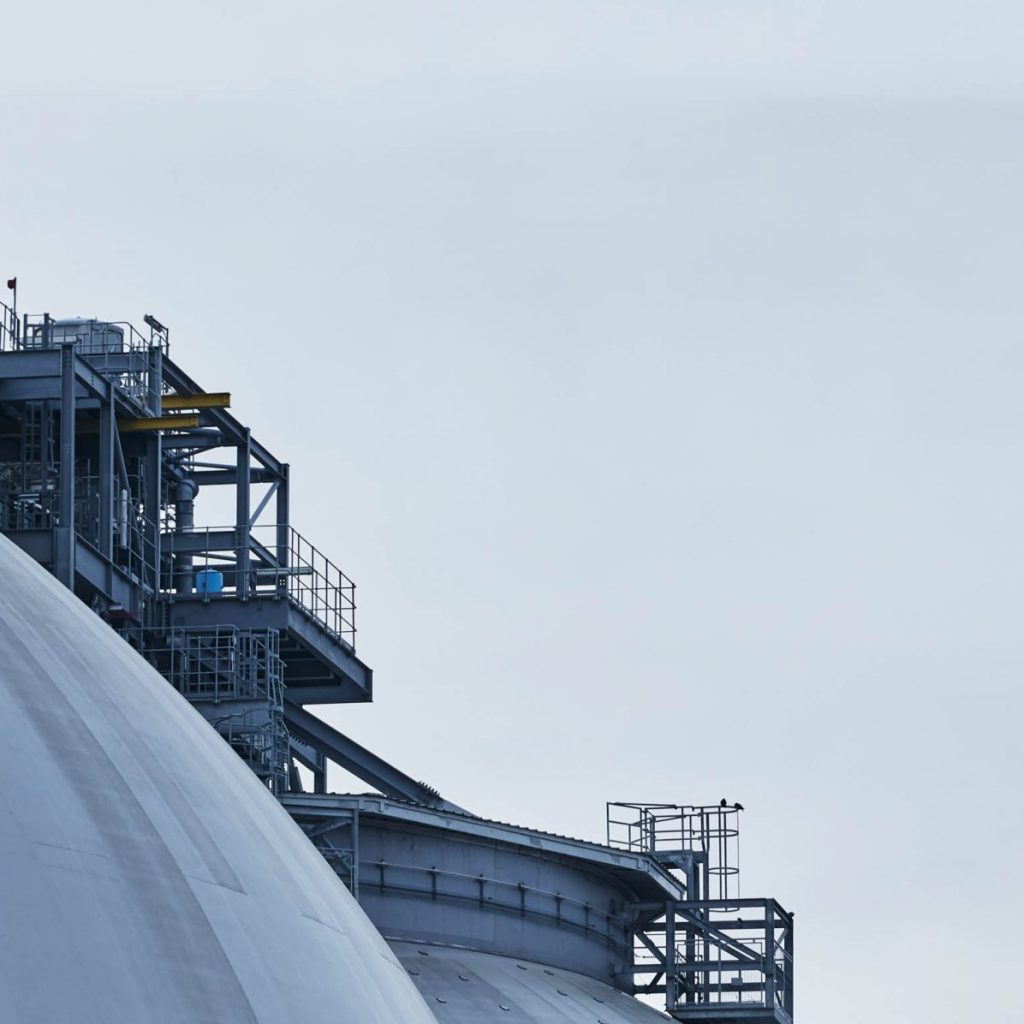
Biomass domes at Drax Power Station
Biomass strategy
Biomass has an important role to play in global energy markets as a flexible and sustainable source of renewable energy, as well as offering the potential to deliver negative emissions via BECCS. We believe that the key to securing this long-term role is to reduce the unit cost of biomass and develop greater direct control of the supply chain.
The Group is targeting control of 5Mt of self-supply capacity by 2027 (currently 1.6Mt, plus 0.4Mt in development) and reduce the cost of biomass to £50/MWh by 2027. Through the delivery of these strategic objectives Drax aims to create a long-term future for sustainable biomass, including third-party supply, BECCS and merchant biomass generation
The proposed acquisition of Pinnacle accelerates the Group’s strategic objectives by adding 2.9Mt of biomass production capacity from 2022, being a combination of capacity available to Drax for self-supply and long-term third-party supply contacts to counterparties in Asia and Europe. In 2019, Pinnacle’s production costs were around 20% lower than our own.
We intend to deliver further savings through the optimisation of existing biomass operations, greater utilisation of forestry residues, such as sawmill residues and the use of other lower cost renewable feedstocks.
The UK’s Climate Change Committee (CCC) has set out what is required for the country to achieve its legally binding objective of being net zero by 2050. This includes an important role for BECCS to remove carbon from the atmosphere, creating negative emissions. BECCS is the only large-scale solution for negative emissions with renewable electricity and system support capabilities. Through combining BECCS with its existing biomass generation units at Drax Power Station, we believe we could remove millions of tonnes of carbon each year from 2027. In doing so Drax aims to become a carbon negative company by 2030.
The technology to deliver post-combustion BECCS exists and is proven at scale. In September 2020, Drax commenced a trial of one such technology provided by Mitsubishi Heavy Industries. In addition, we are developing innovative technology options, including C-Capture, a partnership with Leeds University, IP Group and BP, which has developed an organic solvent which could be used for BECCS.
Drax Power Station is in the Humber region, an area with the highest absolute level of carbon emissions in the UK, owing to the industry and manufacturing located there. This makes the region a natural site for large-scale carbon capture and storage for energy and industry. We continue to work in partnership with Equinor, National Grid and others as part of the Zero Carbon Humber campaign, which we believe can bring new investment, new jobs and world-leading and exportable negative emissions technologies to the UK.
We expect further clarity on the regulation and support for BECCS and the Humber cluster over the next two years and stand ready to develop this technology which is necessary in allowing the UK to deliver its target of a net zero economy by 2050.
We expect global demand for wood pellets to increase in the current decade, as other countries develop decarbonisation programmes that recognise the benefits of sustainable biomass for generation, opening up new sustainable markets. Whilst there is an abundance of unprocessed sustainable biomass material globally, there remains limited capacity to convert these materials into energy dense pellets, which have a low-carbon footprint and lower cost associated with transportation. The proposed acquisition of Pinnacle supports our biomass self-supply strategy which can be used as part of our options for merchant generator or BECCS, but equally it provides an immediate capability to serve the global market for biomass, underpinned by long-term off-take agreements.
Biomass sustainability
When sustainably sourced, biomass is renewable – and sustainably sourced biomass is an important part of UK and European renewable energy policy.
The legal framework and science which underpins this assessment is clear. Carbon emitted in the generation of renewable electricity is absorbed by and accounted for in the growth of forest stock. This is based on well-established principles set out by the Intergovernmental Panel on Climate Change, a UN body, which reconfirmed its long-standing position on sustainably sourced biomass in 2019. This interpretation is reflected in the European Union’s second Renewable Energy Directive (RED II) and Taxonomy rules, which mirror RED II.
The Group provides full disclosure of the carbon emissions associated with our generation activities as part of our annual reporting. We also report the carbon emissions associated with our biomass supply chain, providing a greater level of disclosure than other forms of electricity generation that also have carbon emissions associated with their supply chains.
The Group’s biomass life cycle carbon emissions in 2020 were 109kg CO2e/MWh of electricity (2019: 124 kg CO2e/MWh), almost half the UK Government’s 200kg CO2e/MWh of electricity limit for biomass.
We maintain a rigorous and robust approach to biomass sustainability, ensuring the wood fibre used and pellets produced are fully compliant with the UK’s mandatory standards as well as those of the EU. We use low-cost sawmill residues and forest residues, which are a by-product of commercial forestry processes, and thinnings from growing forests, which help improve forest stocks and forest health. The carbon emissions from using sustainably sourced biomass to produce electricity are balanced by the absorption of carbon from growing forests.
In the US southeast, the source for most of our biomass, increased demand for wood fibre has directly contributed to increased growth and protection of forests. Inventories have increased by over 90% since 1950 as more carbon is stored year after year, despite harvests also increasing.
Our forestry commitments are based on the latest available science from Forest Research, the UK’s principal organisation for forest science. Our Responsible Sourcing Policy for Woody Biomass aims to ensure we only source biomass that makes a net positive contribution to climate change, protects and enhances biodiversity and has a positive social impact on local communities.
Our Policy goes beyond compliance, and our Independent Advisory Board on Sustainable Biomass (IAB), chaired by Sir John Beddington, provides guidance and independent oversight on the sourcing choices we make. The advice and scrutiny from the IAB means stakeholders can be assured that Drax will keep our policies under review and that the biomass we use follows the latest scientific research and best practice.
Other developments
In our Hydro business we are continuing to develop a long-term option for the expansion of Cruachan. Its location, ability to generate and absorb power from the grid, and full range of system support services makes it strategically important to the management of the UK power system and aligned with its future needs.
We are continuing to develop options for new gas generation, including four small open cycle gas turbine units at sites in Wales and eastern England. These flexible assets are intended to help meet peak demand and provide non-generation system support services. Any development remains subject to the Group’s decarbonisation plans and the right price in a future Capacity Market auction.
We have taken the decision not to pursue the option to develop a new combined cycle gas power station at Drax Power Station, and continue to assess options for the site.
People and values
Sustainability is at the heart of the Group and its culture. We believe that achieving a positive economic, social and environmental impact is key to delivering long-term value creation. Drax is a signatory to the UN Global Compact (UNGC) and we are committed to promoting the UNGC principles on respect for human rights, labour rights, the environment and anti-corruption.
The Board is committed to building a supportive, diverse and inclusive working environment where all colleagues feel they belong. This is underpinned by a new Diversity and Inclusion Policy and approach. We value the views of our employees and have incorporated their feedback in the development of our values. 2020 saw a significant improvement in the level of engagement which we measure as a KPI on the Group’s corporate scorecard – used for our 2020 cash bonus plan and determination of vesting under our 2018 LTIP due to vest in 2021.
The strong performance and positive response to Covid-19 across the Group is testament to the hard work, diligence and spirit of our employees. I am proud to have them as colleagues and I thank them for their efforts in this most challenging of years.
Outlook
Looking forward, our focus is on progressing our strategy: to build a long-term future for sustainable biomass; to be the leading provider of system stability in the UK and to give customers control of their energy. Through achieving these strategic objectives, we expect to deliver tangible financial benefits – long-term earnings growth, strong cash generation and attractive returns for our shareholders.
Our principal focus remains the expansion of our biomass supply chain and the reduction of cost to provide a long-term future for sustainable biomass. This includes our ambition to become a carbon negative company by 2030 underpinned by the development of BECCS, using technology already proven at scale to deliver negative carbon emissions. Through our expertise in biomass we are leading the way in developing this world class technology and response to climate change.
We are making good progress with the delivery of our strategy and will build on this as we continue to play an important role in our markets as well as realising our purpose of enabling a zero carbon, lower cost energy future for the UK.
Will Gardiner
CEO
Chapter 5:
Biomass Sustainability & Cost Reduction
There is widespread recognition among leading science-based organisations, such as the UN’s Intergovernmental Panel on Climate Change (IPCC) that sustainable biomass has an important role to play in meeting international climate targets
Sustainable biomass has three big benefits: it generates renewable electricity, supports forest growth and provides a route to negative emissions.
Biomass Sustainability
Sustainably sourced biomass for use in the generation of renewable electricity is an important and well-established part of UK and European renewable energy policy. In 2019 bioenergy was the leading form of renewable energy in Europe, providing twice the amount of energy of wind and solar combined. The status of biomass as a renewable material when sustainably sourced is based on well-established scientific principles reflected in the European Union’s second renewable energy directive and Taxonomy rules.
Sustainable biomass sourcing practices are at the heart of Drax’s activities and have underpinned our transformation from the UK’s largest coal-fired power station, to its fourth largest power generator operating a portfolio of flexible, renewable and low-carbon assets, with an ambition to become carbon negative by 2030. In addition, based on its utilisation of sustainably sourced biomass, Drax Power Station is also the UK’s largest source of renewable electricity by output.
We believe that sustainable practices are important to the activities of the Group in the UK and North America, are integral to good corporate governance and critical to the long-term sustainability of our business model.
Drax sources biomass from established, responsibly managed working forests primarily in the US, Canada and Europe. Commercial forests are generally managed for sawlogs, which are sold into the construction and manufacturing markets. Sawlogs command a financial premium which make them uneconomic for use in making renewable electricity from sustainably sourced biomass. However, the associated material and residues, such as sawmill residues and forest thinnings are of use in other lower cost markets such as biomass and fibre board. This process is fully compliant with UK and European legislation.
Drax is leading standards on biomass sustainability and we are committed to continuing to raise those standards, so that our sourcing policies evolve as the science develops. Our Responsible Sourcing Policy for Woody Biomass is in line with the recommended sourcing practices set out by Forest Research – the UK’s principal organisation for forestry and tree-related science. We have also set up an Independent Advisory Board (IAB) led by the UK government’s former Chief Scientific Adviser Sir John Beddington.
The IAB provides independent advice to Drax in all areas of its biomass sourcing. In 2020 the IAB reviewed our Responsible Sourcing Policy and confirmed that it reflects the recommendations made by Forest Research. We apply these standards to our own activities and those of our third-party suppliers.
We are committed to full transparency and provide an overview of our sourcing practices and publish reports for each area we source biomass material from. At the same time, we are taking action to reduce emissions across our supply chain, for example through investment in rail infrastructure and by partnering with organisations like the Smart Green Shipping Alliance.
Carbon accounting
Carbon accounting and reporting of sustainable biomass is an important area of disclosure. Sustainably sourced biomass is considered carbon neutral under UK and European legislation, underpinned by well-established principles set out by the Intergovernmental Panel on Climate Change, as carbon emitted in the generation of renewable electricity is consumed and accounted for in the growth of new forest stock.
Drax provides full disclosure of the biogenic carbon emissions associated with its generation activities. We also report the carbon emissions associated with our supply chain, providing a greater level of disclosure than any other form of electricity generation – wind, solar, gas, nuclear, which also have carbon emissions associated with their supply chains.
Forest growth
We are seeing the positive effects that sustainable sourcing practices are having on the carbon stored. For example, in the US southeast, where we source most of our biomass, increased demand for wood fibre has directly led to increased growth and protection of forests. Inventories have increased by over 90% since 1950 as more carbon is stored in these forests year after year, despite harvests also increasing.
Negative emissions
Our confidence in the contribution that sustainably sourced biomass can play in the UK’s transition to net zero is echoed by the UK’s Climate Change Committee (CCC). The CCC sees a critical role for BECCs in enabling the delivery of the UK’s net zero carbon by 2050.
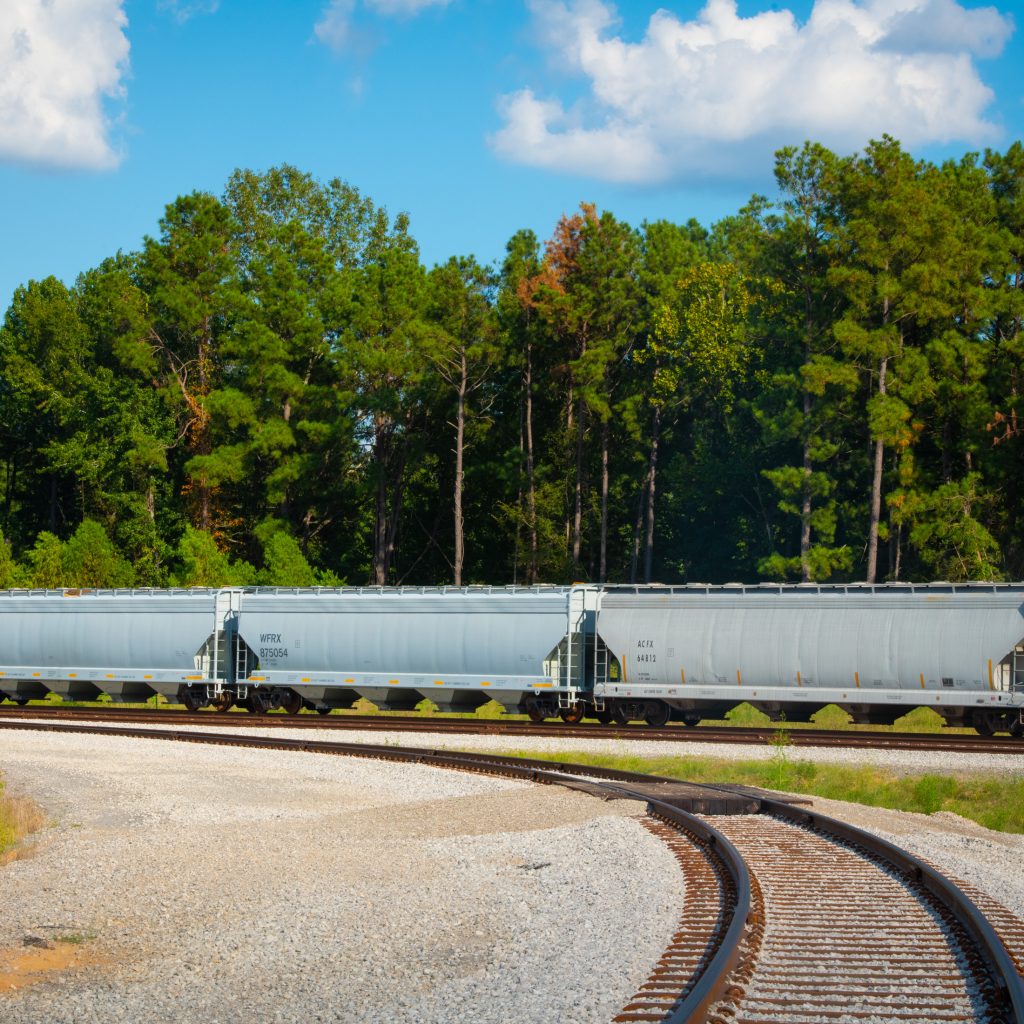
Biomass cost reduction
Building a long-term future for sustainable biomass is a key strategic objective for Drax
The Group has identified three models through which it believes it can deliver a long-term future for sustainable biomass, all of which are underpinned by the delivery of its supply chain expansion and cost reduction plans.
Drax aims to expand its supply chain to 5Mt of self-supply capacity by 2027 (from 1.6Mt today, plus 0.4Mt in development) and reduce the cost of biomass to £50/MWh (from around £75/MWh in 2019). We expect to deliver these savings through the optimisation of existing biomass operations, greater utilisation of low-cost wood residues and an expansion of the types of sustainable low-cost biomass sourced across the Group’s expanded supply chain.
Drax believes that the additional capital and operating cost investment required to deliver this supply chain expansion is in the region of £600 million, which the Group expects to invest ahead of 2027.
This expansion and cost reduction plan gives rise to the three options (see page 17) which are not mutually exclusive. The delivery of one or more of these models by 2027 is expected to enable Drax to continue its biomass activities when the current UK renewable schemes for biomass generation end in 2027.
Expansion and optimisation of existing capacity
Drax currently uses around 7Mt of biomass for generation at Drax Power Station, 1.5Mt of which is self-supplied by our existing pellet production operations in the US Gulf.
We have also identified plans to expand our three existing production sites – LaSalle, Morehouse and Amite – by 0.4Mt over the next two years – an investment of £50 million, the first 0.1Mt of which has now been completed. This will expand total capacity to around 1.9Mt, provide economies of scale and allow even greater utilisation of lower cost residues, such as wood chips and sawmill residues.
Other projects include the co-location of a third-party sawmill at the LaSalle Plant to provide access to sawmill residues, lower transport costs and improved efficiency; a new rail spur connecting LaSalle to the local rail network, improving economies of scale in transport and fewer road miles; and a new chambering yard at the Port of Baton Rouge allowing greater rail throughput. These larger projects are accompanied by small projects to improve operational efficiency such as greater efficiency in the loading of road haulage.
In 2020, these initiatives and others contributed to a 5% year-on-year reduction in cost per tonne. The delivery of these projects, amongst other incremental improvements is expected to deliver $35 per tonne of savings on 1.9Mt by 2022.
In addition to improvements in the US, we have also invested to improve thermal efficiency at Drax Power Station. In 2020 we completed the second of three turbine upgrades which has improved thermal efficiency and alongside other improvements results in a reduction in fuel cost in the region of £1/MWh. The third outage is scheduled to take place in 2021.
Further expansion of self-supply capacity
In 2020 Drax approved the construction of three new 40,000 tonne satellite plants sited alongside existing sawmills in the US southeast at a cost of $40 million. These small sites are designed to utilise low-cost sawmill residues and leverage the Group’s existing infrastructure in the region. Drax believes that this approach could represent up to 0.5Mt of capacity and expects these plants to significantly reduce the cost of pellet production versus the 2018 benchmark and will be operational by 2022.
We will continue to assess opportunities to build or buy capacity to support this ambition – both in North America and other regions where we can demonstrate the right combination of sustainability, fibre availability, cost and infrastructure.
Exploring alternative fuels
Biomass residues from commercial forestry processes represent the majority of biomass used by Drax for generation. Over the last decade, as part of our work on biomass, we have screened hundreds of different types of materials, and we are now using this knowledge of chemistries and operational characteristics to inform the exploration of alternative fuels.
Examples of these materials include sugar cane residues (bagasse), nuts and agricultural residues. Drax believes that in time such materials could represent a significant volume of sustainable biomass material.
Trading and optimisation
An integral part of our strategy is to develop a biomass trading capability. This is an optimisation and risk management activity to support our aim to deliver lower-cost pellets, and non-proprietary trading, through which we aim to optimise internal and external supply and develop opportunities in other markets.

Drax has identified three opportunities for the long‑term use of sustainable biomass
![]()
Merchant biomass generation at Drax Power Station
Biomass has an important role to play in the UK as a flexible and reliable source of renewable energy, complementing increased utilisation of intermittent and inflexible generation across the UK power grid.
In March 2027, when the current renewable schemes end, Drax believes that through a combination of peak power generation, system support services, Capacity Market income and a low-cost operating model for Drax Power Station (including low-cost biomass), this site can continue to operate as a merchant renewable power station
 Bioenergy carbon capture and storage (BECCS)
Bioenergy carbon capture and storage (BECCS)
The CCC has set out what is required for the country to achieve its legally binding objective of being net zero by 2050. This includes a significant role for BECCS to remove carbon from the atmosphere, creating negative emissions. BECCS is the only large-scale solution for negative emissions that also generates renewable electricity and can provide system support services. Through combining BECCS with our existing biomass generation units at Drax Power Station, we believe we could remove millions of tonnes of carbon each year from 2027. In doing so Drax aims to become a carbon negative company by 2030.
The technology to deliver post-combustion BECCS exists and is proven at scale. In September 2020, Drax commenced a trial of one such technology provided by Mitsubishi Heavy Industries. In addition, Drax is developing innovative technology options, including C-Capture, a partnership between Leeds University, Drax, IP Group and BP, which has developed an organic solvent which could be used for BECCS.
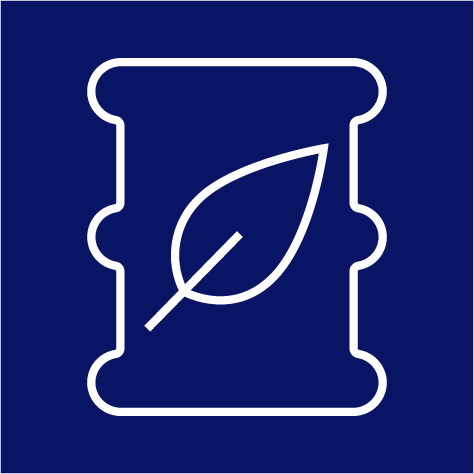 Third party biomass supply
Third party biomass supply
Drax expects global demand for sustainable wood pellets to increase in the current decade, as other countries develop decarbonisation programmes which incorporate the benefits of sustainable biomass for generation. Whilst there is an abundance of unprocessed sustainable biomass material globally, there remains limited capacity to convert these fibres to energy dense pellets, which have a low-carbon footprint and lower cost associated with transportation. As a result, Drax expects the global market for biomass to remain under supplied.
Drax is therefore exploring options to service biomass demand in other markets – such as Europe, North America and Asia alongside the UK. Establishing a presence in these markets could offer the potential for long-term offtake agreements, providing diversified revenues from other biomass markets.
Key performance indicators
Finance
Group adjusted EBITDA from continuing and discontinued operations(1) (£m)*
Why we measure this
This is our principal financial performance metric, combining the underlying earnings performance of each business to give a Group outcome
£412m

Average net debt(1) (£m)*
Why we measure this
This is a key measure of our liquidity (borrowings less cash) and our ability to manage our current obligations. Our long-term target is net debt to EBITDA of around 2x
£849m

Adjusted Earnings Per Share(2) (EPS)*
Why we measure this
This is an important measure of our profitability – showing our adjusted earnings (adjusted net profit from continuing and discontinued operations after tax) on a per-share basis
29.6p

Dividend
Why we measure this
This is a primary measure of our value creation for shareholders. We aim to pay a sustainable and growing dividend
17.1p

*The definition and calculation of Alternative Performance Measures (those that are defined by Drax and not IFRS) is set out on page 153 of the report PDF
Sustainability
Group carbon emissions, scope 1 & 2 (ktCO2e)
Why we measure this
We are focused on reducing carbon emissions – as measured by scope 1 and 2 – which enables us to track progress towards our carbon negative ambition
3,080 ktCO2e
Power generation mix (% total output)
Why we measure this
This is a measure of the different generation sources we use, allowing us to track our progress as we seek to enable a zero carbon energy future
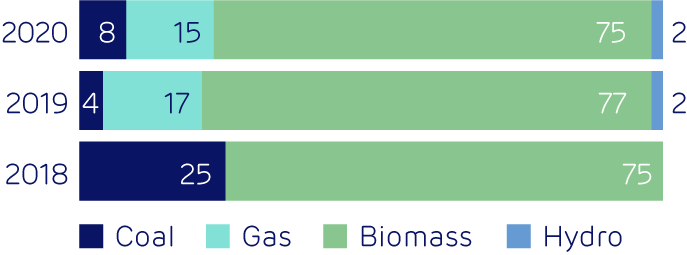
CDP Climate score (1)
Why we measure this
This is an internationally recognised disclosure system and a benchmark for our environmental performance

(1) These measures are contained in the Group Scorecard. and form the basis for the calculation of outcomes for annual bonus and 50% of PSP awards. For more information see pages 125 and 126.
(2) EPS forms the basis for the calculation of outcomes for 50% of LTIP awards. For more information see page 115 of the report PDF.
Safety
Total Recordable Incident Rate(1) (TRIR)
Why we measure this
Good safety management is a core principle and is critical to safe and efficient operations. TRIR is an industry standard measure of the number of incident over hours worked
0.29

Pellet Production
Pellets produced (Mt)
Why we measure this
This measures a key part of our strategy – to increase our pellet production capacity and output
1.5Mt

Cost of production(1) (GJ)
Why we measure this
This measures a key part of our strategy – to reduce the cost of biomass produced
$8.61/GJ

Power generation
Value from system support (£m)
Why we measure this
This measures our generation performance in the provision of non-generation system support services – balancing mechanism, ancillary services and portfolio optimisation
£118m

Commercial availability (%)
Why we measure this
This is an important measure of the amount of time our assets are available to operate, either to generate electricity or provide system support services
91%

Customers
Gross margin(1) (£m)
Why we measure this
This is a key measure of the financial performance of our Customers business – average margin earned
£84m

Chapter 6:
Financial review
How did Drax’s financial performance respond to the challenges of 2020?
Performance has been robust throughout the year, and despite the challenges of Covid-19, Adjusted EBITDA from continuing and discontinued operations was £412 million

2020 highlights
- Robust financial performance – delivering Adjusted EBITDA from continuing and discontinued operations of £412 million, ahead of 2019 despite impact of Covid-19
- Sale of CCGT assets concluded on 31 January 2021 for total consideration, before customary adjustments, of up to £193 million
- Ratio of Net debt to Adjusted EBITDA from continuing and discontinued operations of 1.9x at 31 December 2020
- Asset obsolescence charges of £239 million includes coal closure (£226 million) and decision not to proceed with Drax CCGT (£13 million)
- Provision for one-off coal closure costs of £34 million
- Total operating loss of £156 million includes asset obsolescence charges, one-off coal closure costs plus net derivative remeasurements
- Cash generated from operations of £413 million, compared to £471 million in 2019
- Strong liquidity – with total cash and committed facilities of £682 million at 31 December 2020
- 7.5% increase in dividend to £68 million
The sale of Drax Generation Enterprise Ltd (which contained the Group’s CCGT portfolio) to VPI Generation Limited was announced on 15 December 2020 and completed on 31 January 2021 (see page 27 for further details). The income, expenditure and cash flows of the disposed operations for both the current and previous year have been presented as discontinued operations, and the assets and liabilities of the disposed operations as at 31 December 2020 have been presented as held for sale in the Group’s consolidated financial statements. Amounts presented in this financial review are for continuing operations unless otherwise stated. Reconciliations between continuing, discontinued and total amounts for each period are shown in note 5.5 to the consolidated financial statements on page 195. Comparatives for 2019 have been re-presented to reflect the income and expenditure for the disposed operations as discontinued. Tables in this financial review may not add down/across due to rounding.
Introduction
The Group’s financial performance in 2020 has been robust, delivering Adjusted EBITDA from continuing and discontinued operations of £412 million, which represents a small increase compared to the previous year despite an estimated impact of approximately £60 million as a result of the Covid-19 pandemic, most notably affecting our Customers business (2019 Adjusted EBITDA from continuing and discontinued operations: £410 million).
Strong availability and output from our biomass generation units at Drax Power Station underpinned this result. In addition, we saw value from system support services captured across our flexible generation portfolio and the continuing delivery of our cost reduction targets for biomass pellet production.
We estimate the total financial impact of Covid-19 to be approximately £60 million. In our Customers business, we witnessed a reduction in demand and an increased risk of business failure affecting our customers. This is reflected in costs incurred to exit our previously hedged positions and an increase in the provision for bad debt. In the Generation business, we saw a reduction in ROC recycle values and incurred increased outage costs, but largely offset this by delivering improved returns from flexible generation. We were also able to capture benefits from our substantial derivatives portfolio during a volatile period in markets.
(1) Alternative performance measures (income statement values described as “Adjusted”, plus net debt and net debt to Adjusted EBITDA calculations) are used throughout this financial review. All alternative performance measures are described in full on page 153 and reconciled to corresponding IFRS values on page 170.
Following the Board’s decision to close our remaining coal-fired generation operations, which was announced in February 2020, we recognised asset obsolescence charges in respect of the associated fixed assets of £226 million during the year. In addition, following an employee consultation process, we have booked provisions in respect of redundancy, pension costs, and other closure costs totalling £34 million. Other closure costs include a provision for work to ensure the safety of the site following the closure of the coal units and a small inventory write down for coal we no longer expect to burn prior to closure. All costs associated with the closure of the coal units have been treated as exceptional items in the income statement.
The Total operating loss for the year – which includes depreciation, amortisation and the effect of exceptional items and certain derivative remeasurements – was £156 million (2019 re-presented: profit of £48 million). The year-on-year reduction principally reflects £239 million of asset obsolescence charges plus the £34 million of coal closure costs described above, The asset obsolescence charges are comprised of £226 million related to the coal units and a further £13 million in respect of the option to develop a new combined cycle gas turbine at Drax Power Station, which is no longer expected to proceed. These one-off costs, the majority of which are non-cash, have been partially offset by a reduction in losses arising on the remeasurement of derivative contracts, from £121 million in 2019 to £70 million in 2020, as a result of sterling strengthening during the year.
On 15 December 2020, we announced the sale of our CCGT portfolio to VPI Generation Limited for a cash consideration of up to £193 million, subject to customary working capital adjustments. This included £29 million of contingent consideration associated with the option to develop a new CCGT at Damhead Creek. The transaction subsequently completed on 31 January 2021. The CCGTs have performed well since being acquired in December 2018, delivering £46 million of Adjusted EBITDA in 2020 (2019: £39 million). However, they do not form part of the Group’s core flexible and renewable generation strategy. The results of the CCGTs have been classified as discontinued operations in the consolidated financial statements.
We continued to strengthen our balance sheet and capital structure during 2020. In August we agreed a new infrastructure term loan facility agreement with committed funds in both sterling (£45 million) and euro (€126.5 million), with an option to increase by up to a further £75 million. In November €31.5 million was drawn under this agreement and a further £53 million was committed under the option which was subsequently drawn in December. These commitments have competitive effective interest rates inside the Group’s current average cost of debt. Also in November we issued a new €250 million euro-denominated bond at 2.625% which achieved a rate of 3.24% when swapped back to sterling, a record low cost for a Drax public market issuance. At the same time, we redeemed the existing £350 million sterling bond and the £125 million ESG facility, resulting in an improved maturity profile and lower all-in cost of our debt portfolio. We also refinanced our Revolving Credit Facility, extending its final maturity date from 2022 out to 2025 and converted it into a £300 million facility with ESG credentials. This delivers further enhancements to liquidity. Overall, net cash payments in respect of debt reduced our borrowings by £176 million (2019: increased borrowings by £636 million, linked to acquisitions).
We continue to generate strong net operating cash inflows. Net cash from operating activities was £306 million in 2020 (2019: £413 million). The reduction when compared to the prior year principally reflects a net cash outflow from rebased derivative contracts of £27 million, as the benefit of cash accelerated from such activity unwound over the course of the year (2019: net cash inflow of £104 million). In addition, 2020 saw the introduction of the new tax payment regime for large companies, accelerating tax payments in the year of transition. Cash capital expenditure in the year was £174 million (2019: £171 million).
The Group’s liquidity position remains strong and provides a solid platform from which we can continue to execute our strategy. At 31 December 2020, we held cash of £290 million (2019: £404 million) and total cash and total committed facilities of £682 million (2019: £615 million).
We remain fully committed to payment of a sustainable and growing dividend. The Board will recommend at the forthcoming Annual General Meeting a final dividend that takes total dividends for the financial year to £68 million, or 17.1 pence per share, an increase of £5 million or 1.2 pence per share when compared to 2019.
Financial Performance
Adjusted EBITDA
Group Adjusted EBITDA from continuing and discontinued operations of £412 million was slightly ahead of the prior year (2019: £410 million) despite the impact of Covid-19. This represents a robust performance in what has been a challenging year. Excluding the contribution from the CCGT portfolio classified as discontinued in the consolidated financial statements, Adjusted EBITDA from continuing operations was £366 million (2019: £371 million).
Our Generation business contributed Adjusted EBITDA from continuing and discontinued operations of £446 million (2019: £408 million), an increase of 9% or £38 million compared to the previous year. This result was underpinned by a 5% increase in total output from biomass in 2020, to 14.1TWh compared to 13.4TWh in 2019. This was supported by availability of 91% (2019: 88%). Our strong generation hedge book also provided protection against volatility in commodity markets resulting from Covid-19.
Despite this performance, Generation has been affected by the pandemic. ROC recycle values fell during 2020 and the cost of performing outage work at our sites increased as a result of implementing social distancing measures to enable this work to be carried out safely. These factors were offset by strong performance in the short-term and balancing markets plus some value captured from within the derivatives portfolio attributable to market volatility during the Covid-19 pandemic.
Our pumped storage and hydro assets in Scotland continued to perform well. Cruachan pumped storage power station contributed significantly to overall gross margin from system support activity of £118 million. This reduced slightly from £120 million in 2019, due to specific constraint contract income and benefits associated with closing out positions as our coal generation forecasts reduced, neither of which were expected to recur in 2020. This reflects the benefit of generating plant that is flexible and can turn up and down at short notice to meet demand.
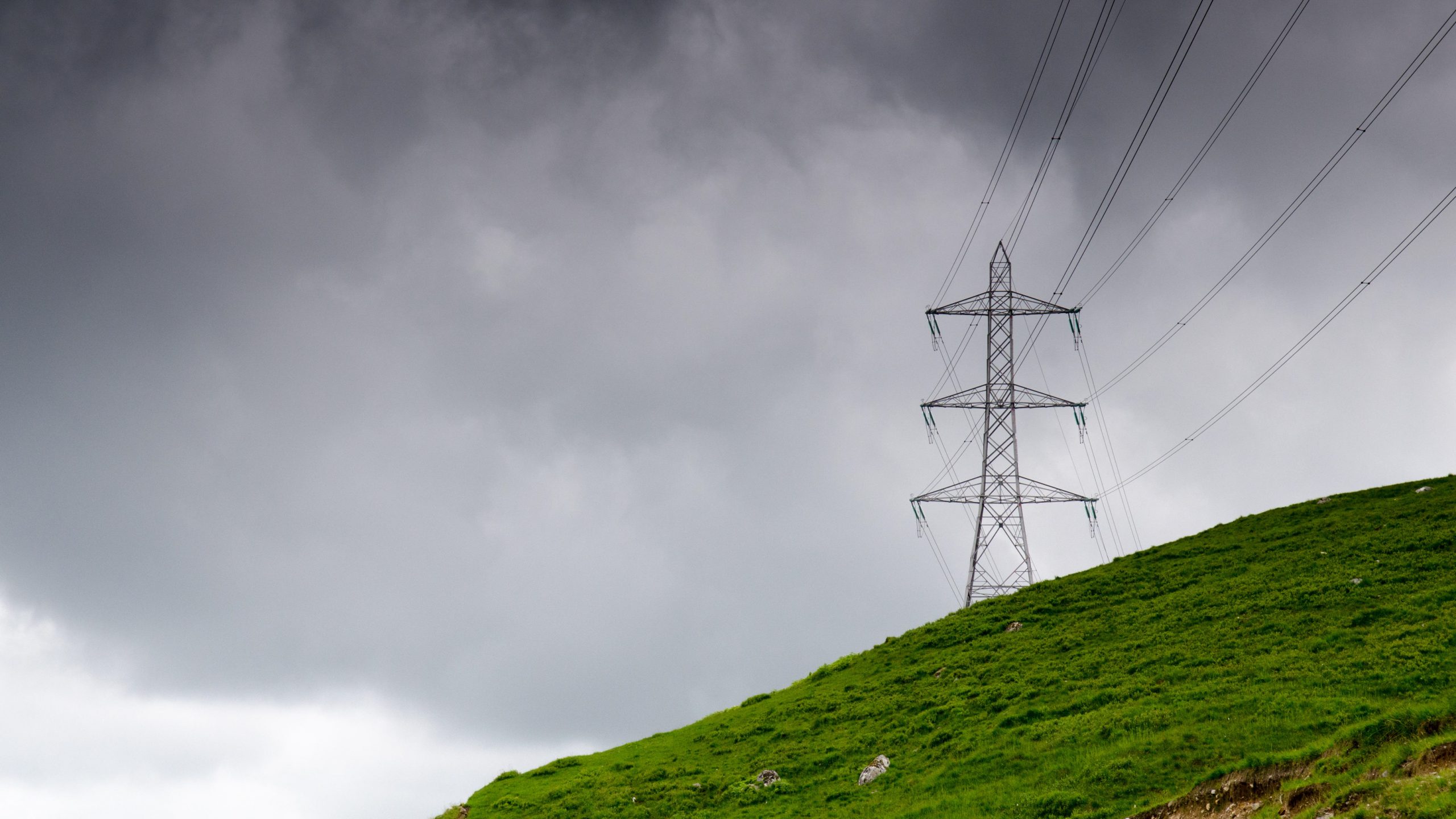
Reconciliation of Adjusted EBITDA to Total Operating Loss
| £m | |
|---|---|
| Adjusted EBITDA from continuing and discontinued operations | 412 |
| Remove EBITDA contribution from CCGT portfolio sold on 31 January 2021 | -46 |
| Adjusted EBITDA from continuing operations | 366 |
| Depreciation, amortisation and losses on disposal of fixed assets | -177 |
| Adjusted Operating profit | 189 |
| Asset obsolescence charges due to coal closure | -226 |
| Asset obsolescence charges due to decision not to develop CCGT at Drax Power Station | -13 |
| Provision for coal closure costs | -34 |
| Acquisition and restructuring costs | -1 |
| Derivative remeasurements | -70 |
| Total Operating Loss | -156 |
The CCGT portfolio performed strongly, particularly in the final quarter of the year as cold weather and low wind led to opportunities in the balancing market. Total output from the CCGTs was 2.8TWh (2019: 2.9TWh) with an EBITDA contribution of £46 million (2019: £39 million). On 15 December 2020, we announced the sale of the CCGT portfolio to VPI Generation Limited for total cash consideration of up to £193 million, including £29 million of consideration contingent on the development of a new CCGT at the Damhead Creek site. The sale subsequently completed on 31 January 2021. Initial cash consideration received on 1 February was £188 million, including £24 million in respect of adjustments for working capital.
Coal contributed approximately 8%, or 1.6TWh, of our total generation volume in 2020 (2019: 3%) and a small loss, as the economics as the economics remain very challenging. Following the decision to close the remaining coal units, made in February 2020, total closure costs of £34 million have been provided for and treated as exceptional items and excluded from Adjusted EBITDA – a reconciliation of these amounts is provided in note 5.1 to the financial statements. The trading performance of the coal units continues to form part of our Adjusted results, and will do so until closure. The units will cease commercial generation in March 2021 and close entirely following the completion of Capacity Market obligations in September 2022, at which point we expect to see cost savings in excess of £30 million per annum. Some of this benefit will begin to materialise during 2021.
The Generation business acquires biomass pellets predominantly in US dollars, Canadian dollars and euros, which we actively hedge over a rolling five-year period, to manage our foreign currency exposure to a weaker pound. The renewable support (CfD and ROCs) received in respect of biomass generation is subject to UK inflation indices, while some of our biomass pellet contracts are subject to US inflation indices. This exposure is managed as part of our active long-term financial derivatives hedging programme.
We hold a large portfolio of forward and option contracts for various commodities and financial products, the nature, value and purpose of which is described in note 7.2 to the consolidated financial statements. These contracts are held to de-risk the business, by protecting the sterling value of future cash flows in relation to the sale of power or purchase of key commodities. We manage our exposures in accordance with our trading and risk management policies.
From time to time, for example where market conditions or our trading expectations change, action may be needed in accordance with these policies to rebalance our portfolio. During 2020, this included restructuring in-the-money foreign currency exchange and inflation contracts, to balance short and long positions across the duration of the hedge. The value of such activity increased in 2020, due to market volatility during the Covid-19 pandemic. The financial impact of these activities – which is driven by market prices at the point of execution – is included within the cost of sales of our Generation business and therefore is reflected in our Adjusted Gross profit and Adjusted EBITDA. This reflects the fact that the principal purpose of holding these contracts is to manage and de-risk the cost of purchasing fuel.
Performance in our Pellet Production business has been strong, in terms of both quality and quantity of pellets. Adjusted EBITDA of £52 million (2019: £32 million) increased by 63% and reflects a record year for output with 1,5Mt of pellets produced (2019: 1,4Mt) and 1.5Mt shipped (2019: 1.3Mt). In addition to increasing output and lowering the overall cost per tonne, we improved pellet quality during the year, with a reduction in fines (larger particle-sized dust) when measured at disport from 7.9% in 2019 to 5.0% in 2020, a 37% reduction in the year.
This performance comes against a backdrop of Covid-19 and Hurricane Laura, the latter of which significantly affected the areas where we operate in August 2020. Our teams successfully operated our plants throughout these challenges to deliver a strong performance, with total pellets produced 6% ahead of the previous year – a testament to their hard work, focus and shared commitment to the business and one another.
We continued to make good progress with our biomass cost savings initiatives, with the overall cost per tonne of pellets produced in the year standing at $153 per tonne (2019: $161 per tonne), a reduction of approximately 5%. In addition to the increase in tonnage year-on-year contributing to the lower cost per tonne, we commissioned a dry shavings facility at the La Salle plant, enabling us to process less expensive residual fibre products.
As set out in the biomass cost reduction section on pages 16 and 17, there are three potential business models for post-2027 operations. We believe that the strategy to expand self-supply and reduce biomass costs supports all three of these models.
Our Customers business made an Adjusted EBITDA loss of £39 million in 2020 (2019: Adjusted EBITDA profit of £17 million). We believe the reduction of £56 million can be primarily attributed to the impact of the Covid-19 pandemic. Excluding this impact, the result for the year would have been more in line with that in 2019.
The majority of this impact was taken in the first half of the year and, despite a further national lockdown during November 2020, the second half of the year has out-turned broadly in line with the expectations we set out at our interim results in July.
We have experienced reduced demand in the Customers business as a consequence of lockdown and social distancing measures in the UK, although this effect saw some recovery in the second half of the year. Combined electricity and gas volumes sold in 2020 of 17.5TWh were approximately 7% lower than prior year (2019: 18.9TWh). As a result, revenues have reduced, and we incurred costs to exit previously hedged positions as demand estimates reduced and market prices fell. Overall, gross profit in the Customers business reduced by £50 million, from £134 million in 2019 to £84 million in 2020. This reduction was primarily attributable to the effects of the pandemic. This impact was partially mitigated by delivering operating cost savings across the Group during the year with consolidated Adjusted operating and administrative expenses from continuing and discontinued operations £16 million lower in 2020 than the prior year.
Covid-19 has also increased our expectation of business failures and bad debt charges, particularly in the SME segment and among customers in higher-risk industries. This is reflected in the charge for impairment losses on trade receivables for the year of £43 million, which has increased by £25 million compared to the prior year (2019: £18 million). The bad debt charge for the year represents 2% of total Customers revenue, including revenues derived from lower-risk segments and larger Industrial and Commercial customers, up from less than 1% in 2019.
The overall provision for trade receivables at the end of 2020 of £60 million (2019: £47 million) is based on a consistent methodology with that used at the end of prior periods, updated to reflect our experience of cash collections and potential customer business failures in the period since the first lockdown came into effect in March 2020, and using that experience to inform our assumptions about future performance. In addition, we have credit insurance coverage to help further mitigate some of this risk.
We will continue to monitor the wider Customers portfolio to ensure alignment with the Group’s strategy. Whilst we remain cautious about the trajectory for Covid-19 recovery in our forecasts, we anticipate a return to profitability at EBITDA level for this business.
Central and other costs, which reflect our core services functions, including our innovation teams, were £50 million in 2020 (2019: £46 million). The increase from the previous year reflects additional investment of £8 million in innovation activities in support of our strategy, including the development of BECCS and the zero-carbon Humber project, and an increase in insurance costs. Other central operating costs reduced – in 2019 we incurred one-off costs associated with implementing a new operating structure and a higher level of costs associated with working capital management initiatives which have not recurred in 2020. In 2021 we expect the overall trend of investment in innovation to continue.
We continued to strengthen our balance sheet and capital structure during 2020, and delivered a net debt to Adjusted EBITDA ratio of 1.9x”
Andy Skelton, CFO
Total Operating (Loss)/Profit
The Total operating loss for 2020 of £156 million (2019: re-presented profit of £48 million) includes the effect of exceptional items and remeasurement gains and losses on derivative contracts that are excluded from Adjusted results. Our policy and approach to calculating Adjusted results is set out on page 153.
In February 2020, we announced the decision to cease commercial coal generation at Drax Power Station by March 2021, with the units closing fully once existing Capacity Market obligations are concluded in September 2022. Following this decision, we recognised asset obsolescence charges in respect of associated fixed assets of £226 million. We have also provided for total closure costs of £34 million in respect of employee termination benefits and necessary site reorganisation costs, within the £25-35 million range previously estimated. A breakdown of these costs, and the location of the provisions in our consolidated balance sheet, is provided in note 5.1 to the consolidated financial statements. All costs associated with the closure of coal have been treated as exceptional items and excluded from Adjusted results. See notes 2.7 and 5.1 to the consolidated financial statements for more information.
Net fair value remeasurement losses on derivative contracts included in operating profit were £70 million (2019 re-presented: losses of £121 million) reflecting movements in the mark-to-market position on our portfolio of commodity and financial derivative contracts, to the extent they do not qualify for hedge accounting. A further £22 million of net fair value remeasurement gains on power, gas and carbon trades related to the CCGT portfolio (2019: £12 million loss) is included in the result arising on discontinued operations.
The net losses in 2020 are predominantly the result of the strengthening of sterling in the period, which drives the unwind of previously built-up gains resulting from the value of our extensive portfolio of foreign currency exchange contracts. These exchange contracts provide protection against changes in exchange rates for fuel purchases denominated in foreign currencies over a five-year period.
Depreciation and amortisation in the year, including losses on disposal of assets, totalled £177 million (2019 re-presented: £194 million) a decrease of £17 million compared to the previous year. Following the decision taken in February 2020 to close coal generation, associated assets were fully written down and no longer attract any depreciation charges. A further £19 million (2019: £16 million) of depreciation relates to the CCGT portfolio and is presented in the result from discontinued operations.
Profit After Tax and Earnings per Share
Adjusted profit after tax from continuing and discontinued operations of £118 million (2019: £118 million) results in Adjusted earnings per share (EPS) of 29.6 pence (2019: 29.9 pence).
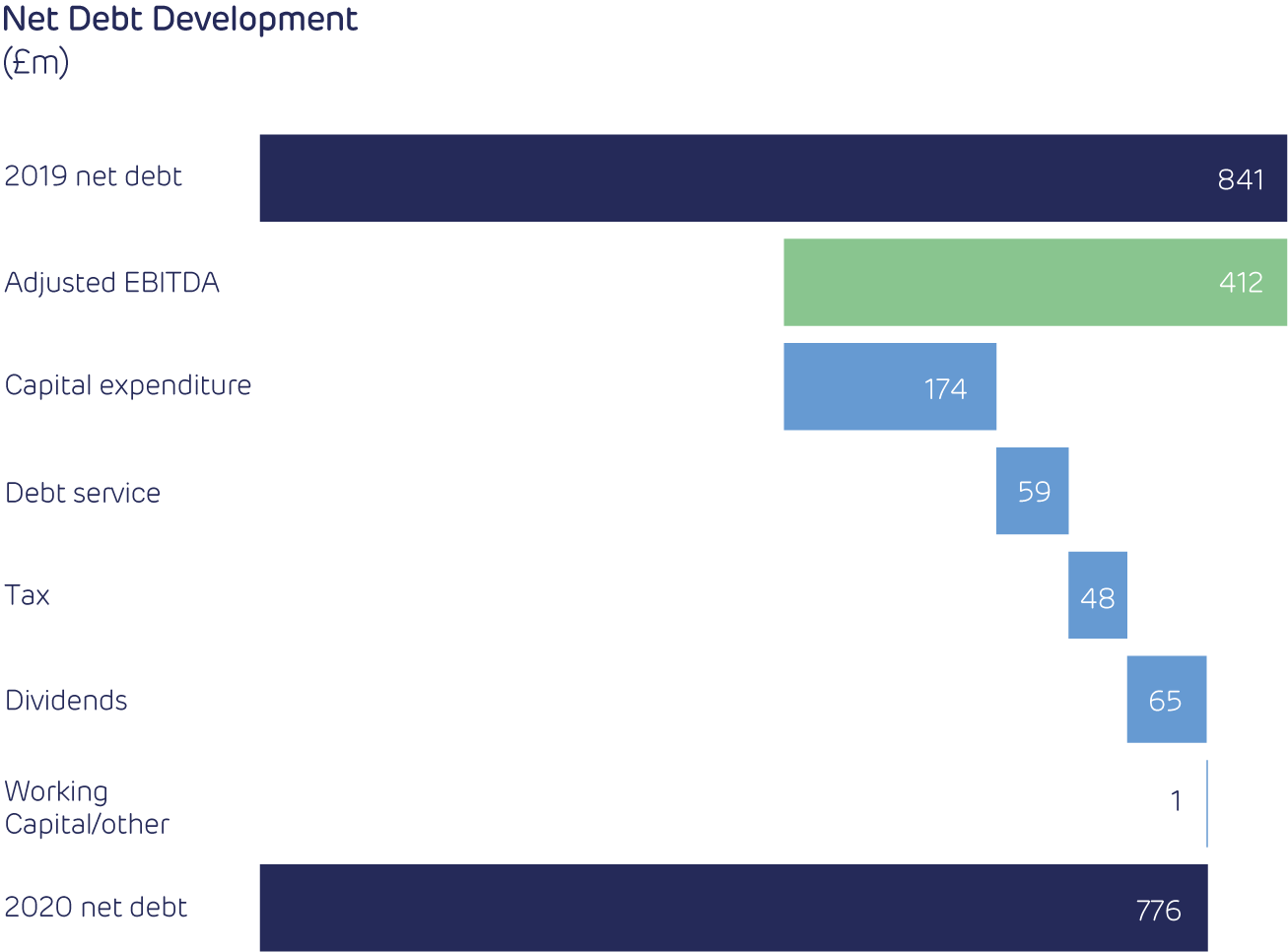
Adjusted profit after tax and EPS from continuing and discontinued operations have remained broadly consistent year-on-year, largely reflecting a combination of the factors described above, offset by an £8 million increase in Adjusted net interest charges and a £4 million increase in the Adjusted tax charge.
The Total loss after tax from continuing and discontinued operations of £158 million is significantly reduced from the equivalent profit of £1 million for the prior year, with a corresponding reduction in Total EPS from nil pence in 2019 to a loss per share of 39.8 pence in 2020. Total loss after tax reflects exceptional items and certain remeasurements, including the derivative remeasurements, coal asset obsolescence charges and coal closure costs described above. In addition, it includes £8 million of charges related to refinancing activity (2019: included £5 million of costs associated with the acquisition bridge facility) described in further detail below.
The Adjusted tax charge for continuing and discontinued operations of £28 million (2019: £24 million) reflects an effective tax rate of 19%, in line with the standard rate of corporation tax in the UK. This reflects the benefit of patent box tax credits in respect of the biomass unit conversions. Total patent box credits included for 2020 are £8 million (2019: £8 million). This was offset by the negative impact of revaluing deferred tax liabilities following the UK Government’s decision to reverse the previously announced reduction in future corporation tax rates in the first half of the year. The total impact of this change was £18 million, with £4 million relating to deferred tax balances associated with the written down coal assets treated as an exceptional item. The remaining £14 million charge, which reduces Adjusted EPS by 3.5 pence, is included in Adjusted Results.
The Group continued to benefit from Research and Development Expenditure Credits (RDEC) in 2020, with claims totalling £6 million recognised as a reduction in cost of sales and operating expenses (2019: £3 million).
The Total tax credit for continuing and discontinued operations of £32 million includes the tax attributable to exceptional items and derivative remeasurements. A full reconciliation of the Group’s tax credit for the year is provided in note 2.6 to the consolidated financial statements.
Cash taxes paid during the year were £48 million (2019: £10 million). In 2020, the Group fell into the new arrangements in respect of corporation tax payments for very large companies in the UK for the first time. As a result, the Group must now make tax payments earlier than under the previous regime and the increase compared to the prior year is a one-off impact on transition.
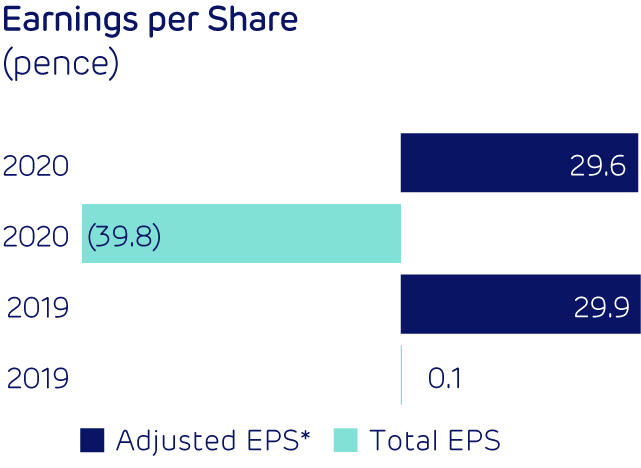
* EPS based on profit/(loss) for the year including continuing and discontinued operations
Capital Expenditure
We maintain a disciplined approach to capital expenditure, with all significant projects subject to appraisal and prioritisation by a Capital Committee prior to approval. This committee ensures overall adherence to our capital allocation policy and maintenance of an appropriate net leverage profile.
In 2020, total capital expenditure of £200 million, excluding additions to decommissioning assets of £29 million (see note 5.4), compares with £172 million in the previous year. This was lower than previous expectations as a result of the deferral of some projects due to Covid-19. This includes non-essential works at Drax Power Station, and delayed timing of some investments in our biomass supply chain.
The increase compared to 2019 principally reflects execution of our strategy, with significant investments made in the expansion of our US pellet production facilities, alongside smaller projects within our generation portfolio to enhance efficiency. Notably the expansion at our pellet production facility in Morehouse commissioned in November 2020. The extensions at La Salle and Amite are expected to come online by 2022.
Capital investment in our Customers business has been limited to £7 million (2019: £20 million). The past capitalised spend associated with a new billing system of £19 million was stopped in 2019 and the Group is engaged in active discussion with the supplier reflecting the supplier’s failure to perform under this contract. No amounts have been provided against this value as the Group believes that the carrying amount will be recovered in full, supported by legal advice.
Cash and Net Debt
We remain focussed on cash flow discipline and maintaining a robust balance sheet. This is underpinned by prudent risk management which provides protection in times of economic uncertainty and a strong platform from which to execute our strategy.
The Group continued to generate strong cash from operations in 2020, with a total inflow of £413 million (2019: £471 million) before interest and tax payments. This reflects our focus on cash flow discipline and continued management of working capital. Cash received in respect of 2019 Capacity Market income in January 2020 (£72 million) and a net cash inflow resulting from increased generation and a corresponding reduction in coal inventories was offset by a net outflow from rebasing of derivative contracts and an increase in net purchases of ROC assets.
Net cash generated from operating activities in the year was £306 million (2019: £413 million). In 2020, the Group experienced the impact of the new arrangements in respect of corporation tax payments for very large companies in the UK, as described above, which increased cash tax payments by £38 million compared to the prior year.
Our liquidity position remains strong, reflected by all three of our ratings agencies evaluating our liquidity assessment as Strong. At 31 December 2020 we held cash of £290 million (31 December 2019: £404 million), total borrowings were £1,066 million (31 December 2019: £1,245 million) and as a result net debt was £776 million (31 December 2019: £841 million). During the first half of 2020, the Group was assigned its first equivalent to investment grade from DBRS. This affirmed the strength of our balance sheet, strong near-term contracted earnings, plus the depth and breadth of our available sources of liquidity.
Our net debt to Adjusted EBITDA ratio, based on Adjusted EBITDA for continuing and discontinued operations, was 1.9x at 31 December 2020 (2019: 2.1x). After adjusting for timing differences related to Capacity Market income and cash across the current and previous period, the net debt to EBITDA ratio was 1.9x at both 31 December 2020 and 31 December 2019. On a proforma basis, taking into account the initial proceeds on sale of the CCGT portfolio (£188 million – see below) and removing the associated EBITDA contribution (£46 million), net debt to Adjusted EBITDA at 31 December 2020 was 1.6x.
During the year, the Group continued to enhance its access to capital and strengthen the balance sheet. In August, we announced the agreement of a new Infrastructure term loan agreement with committed funds in both sterling (£45 million) and euro (€126.5 million), with a range of maturities between 2024 and 2030. €31.5 million was drawn under the agreement at 31 December 2020. The agreement also included an option to increase the facility by up to a further £75 million of which £53 million was agreed in November and drawn in December. The remaining commitments were subsequently drawn on 18 February 2021.
In November 2020, the Group issued €250 million of euro-denominated senior secured notes which mature in 2025. The 2.625% issuance achieved Drax’s lowest ever priced public offering which, once swapped back to sterling, reflected an interest rate of 3.24% per annum. The proceeds of this issuance were, along with existing cash flows, used to redeem the Group’s £350 million 2022 sterling bond and the £125 million ESG term loan facility. Total costs in respect of the redeemed facilities, including the non-cash impact of deferred finance costs, of £8 million have been treated as an exceptional item in the income statement, in line with previous practice.
A significant proportion, almost 90%, of the Group’s debt now falls due in 2025 or later.
Following the issue of the euro-denominated notes in 2020, £610 million or 57% of the Group’s closing borrowings balance is denominated in foreign currencies (2019: £374 million, 30%). The carrying amount of our foreign currency borrowings and, consequently, the value of reported net debt is subject to FX volatility as a result of translating balances at rates prevailing at the balance sheet date under IFRS.
We use derivatives, including cross-currency swaps to hedge the sterling cost of the interest payments and future principal repayments in respect of these facilities. In note 4.1 to the consolidated financial statements, in addition to net debt per the IFRS balance sheet (as defined on page 153). we set out a reconciliation of net debt that incorporates the impact of relevant financial derivatives to fix the value of sterling principal repayments. At 31 December 2020, this resulted in net debt adjusted for hedging of £819 million.
Adjusted Results from Continuing and Discontinued Operations 2020
| £m | Continuing Operations | Discontinued Operations | Cumulative |
|---|---|---|---|
| Revenue | 4235 | 206 | 4441 |
| Cost of Sales | -3435 | -127 | -3562 |
| Adjusted Gross Profit | 800 | 79 | 879 |
| Operating Expenses | -391 | -33 | -424 |
| Impairment losses on Trade Receivables | -43 | – | -43 |
| Adjusted EBITDA | 366 | 46 | 412 |
| Depreciation & Amortisation | -178 | -19 | -197 |
| Net finance charges | -69 | -1 | -70 |
| Adjusted Profit before tax | 119 | 26 | 145 |
| Taxation | -23 | -5 | -28 |
| Adjusted Profit after Tax | 96 | 21 | 118 |
| Impact of exceptional items and certain remeasurements (see note 2.7) | -291 | 16 | -275 |
| Total (Loss)/Profit after Tax | -195 | 37 | -158 |
In November 2020, we also concluded the refinancing of the revolving credit facility (RCF). The new RCF matures in 2025, with an option to extend by one year, and replaces the previous facility. This £300 million facility provides increased liquidity, enabling the full facility to be drawn as cash (previously restricted to £165 million). The RCF has a customary margin grid referenced over LIBOR and represents a small reduction in cost compared to the previous facility. It includes an embedded ESG component that adjusts the margin based on the Group’s carbon intensity measured against an annual benchmark.
The RCF is available to manage low points in the cash cycle and was undrawn at 31 December 2020. Committed facilities of £45 million and €95 million under our new Infrastructure term loan agreement also remained undrawn at 31 December 2020. Available cash on hand and committed, undrawn facilities provide substantial headroom over our short-term liquidity requirements.
Net cash released from working capital in 2020 was £37 million (2019: cash absorbed by working capital of £51 million). We actively optimise our working capital position by managing payables, receivables and inventories to make sure the working capital committed is closely aligned with operational requirements. As in previous periods, we have maintained our strong cash flow focus and continued to deliver working capital benefits from making sales and purchases of ROC assets and utilisation of payment facilities, however the overall utilisation of these facilities has decreased compared to 2019.
Historically, cash from ROCs has typically been realised several months after the ROC was earned, usually at the end of the ROC compliance period; however, the Group is able to limit the overall impact of ROCs on working capital by making separate sales and purchases in the compliance period. During 2020, such transactions generated a net cash outflow of £74.0 million due to more purchases than sales in the period. The overall working capital inflow from ROCs of £23.1 million reflects an overall reduction in ROC assets held on the balance sheet due to decreased generation in the year. The Group also has access to facilities enabling it to sell ROC trade receivables on a non-recourse basis. Utilisation of these facilities at 31 December 2020 was £nil (31 December 2019: £nil). In the first half of 2020, the Group rebased several foreign currency contracts, which resulted in a working capital benefit, with total cash released from rebased trades still outstanding at 31 December 2020 of £24 million (in the prior year, total cash released from rebased trades still outstanding at 31 December 2019 was £84 million). A similar exercise for cross-currency swaps resulted in cash released from outstanding trades at 31 December 2020 of £56 million (31 December 2019: £23 million). The overall net outflow associated with rebasing activity in 2020 was therefore £27 million (2019: a net inflow of £104 million).
The Group holds a large portfolio of forward and option contracts for various commodities and financial products. These contracts are held to de-risk the business, by protecting the sterling value of future cash flows in relation to the sale or purchase of key commodities. We manage our exposures in accordance with our trading and risk management policies. These policies provide flexibility to optimise our trading position, working capital and liquidity when market conditions allow, whilst ensuring downside protection and prudent risk management are maintained.
In addition, the Group has access to a £200 million receivables monetisation facility, which accelerates associated cash flows and mitigates exposure to credit risk. The Group also has access to a number of payment facilities to leverage scale and efficiencies in transaction processing and also facilitates a supply chain financing scheme, which enables certain suppliers to accelerate their payment and which supports the wider working capital efficiency of the Group. There are no changes to the Group’s payment terms under this arrangement, nor would there be if the arrangement were to fall away. The balances outstanding at 31 December 2020 and the change in utilisation in respect of each of these facilities is set out in note 4.4 to the consolidated financial statements. The overall net cash outflow for the period was £114 million (2019: net inflow of £122 million), after cash payments for capital expenditure of £174 million (2019: £171 million), dividend payments of £65 million (2019: £59 million), net repayments of borrowings of £176 million (2019: net proceeds from new borrowings of £636 million) and payments in respect of acquisitions of £nil (2019: £692 million).
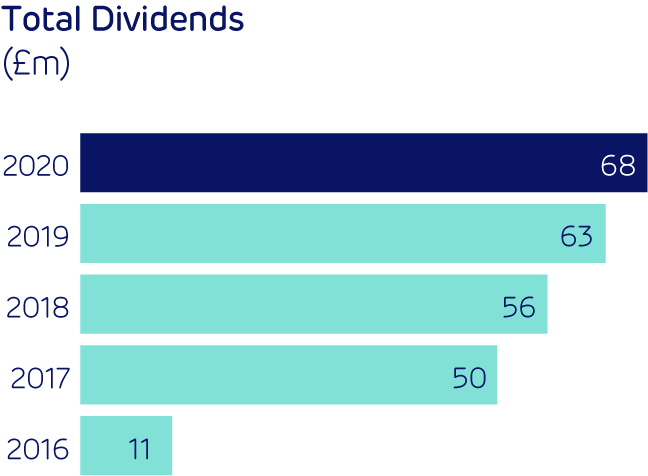
Distributions
We have a long-standing capital allocation policy. This policy sets out our commitments to robust financial metrics that underpin our strong credit rating, to invest in our core business, to pay a sustainable and growing dividend and finally to return surplus capital to shareholders as appropriate.
At the Annual General Meeting on 22 April 2020, shareholders approved payment of a final dividend for the year ended 31 December 2019 of 9.5 pence per share (£38 million). The final dividend was paid on 15 May 2020. On 28 July 2020, the Board resolved to pay an interim dividend for the six months ended 30 June 2020 of 6.8 pence per share (£27 million), representing 40% of the expected full year dividend. The interim dividend was paid on 2 October 2020.
At the forthcoming Annual General Meeting, on 21 April 2021, the Board will recommend to shareholders that a resolution is passed to approve payment of a final dividend for the year ended 31 December 2020 of 10.3 pence per share (£41 million), payable on or before 14 May 2021. Shares will be marked ex-dividend on 22 April 2021. This brings the total dividend payable for 2020 to £68 million and delivers 7.5% growth on 2019.
Other Information
Covid-19, Brexit and Going Concern
We continue to monitor and assess developments and the potential future impact of the Covid-19 pandemic on our operations and financial performance. As described above, our financial performance in 2020 was robust despite an estimated £60 million impact on Adjusted EBITDA, and we have maintained a strong balance sheet with a net debt to Adjusted EBITDA from continuing and discontinued operations ratio of 1.9x at 31 December 2020.
Looking forward, our business plan for 2021 and beyond reflects our central assumptions regarding the likely duration of the pandemic, and the nature of the associated restrictions such as social distancing. These factors, alongside wider macroeconomic considerations, can affect the demand for, and price of, power. We continue to expect a detrimental impact, when compared to pre-Covid expectations, in our Customers business due to the reduction in demand and increase in bad debt risk described above. Our forecasts for 2021 assume a gradual easing of lockdown in the UK will commence as the roll-out of Covid-19 vaccinations progresses.
We are monitoring developments following the end of the Brexit transition period. Our consideration of risk impacts in respect on Brexit is set out on page 68.
In addition to the routine scenario planning incorporated into our business plan process, we have modelled a series of scenarios based on our principal risks, a reasonable worst case and more extreme scenarios. These scenarios have helped us to test the Group’s financial resilience over both the next 12 months and a longer period for the purpose of viability reporting (see page 64). In particular, we have considered the impact of extended generation outages across our portfolio, taking into account risks associated with plant operations and supply chain, as well as commodity price exposure. To date, such modelling has indicated that, while there would be a financial impact, none of the scenarios modelled would result in an impact to the Group’s liquidity, solvency or covenants that could not be remediated by taking mitigating action. In reaching this conclusion, no additional financing was contemplated beyond existing committed facilities.
Consequently, the Directors have a reasonable expectation that the Group will continue to meet its obligations as they fall due for at least the next twelve months, while operating within the means of its current capital structure. Accordingly, the Directors have adopted the going concern basis when preparing the consolidated financial statements.
Sale of CCGT Portfolio
On 15 December 2020, the Group announced it had reached agreement for the sale of Drax Generation Enterprise Limited, which held the Group’s portfolio of CCGT power stations, to VPI Generation Limited for cash consideration of up to £193 million, subject to customary adjustments. This included £29 million of contingent consideration associated with the option to develop a new CCGT at Damhead Creek.
The sale completed on 31 January 2021. The Group received the initial consideration of £188 million on 1 February 2021 which included £24 million in respect of working capital adjustments. The final consideration is subject to a completion accounts process which is expected to conclude in the first half of 2021. The Group anticipates recording a small premium on sale in its 2021 consolidated financial statements. The sale price represents a return over the Group’s period of ownership significantly ahead of the Group’s weighted average cost of capital.
In the consolidated financial statements for the year ended 31 December 2020, the results of the CCGT portfolio (revenue of £181 million, Adjusted EBITDA of £46 million and profit after tax of £37 million) have been presented as discontinued operations in the consolidated income statement, and the assets and liabilities shown as held for sale in the consolidated balance sheet. Transaction costs of £4 million have been expensed to the income statement as incurred and recognised as an exceptional item within discontinued operations in line with our policy. The consolidated income statement for the year ended 31 December 2019 has been re-presented to show the results for the CCGT portfolio on a consistent basis as discontinued operations. See note 5.5 for further details.
Proposed Acquisition of Pinnacle Renewable Energy
On 8 February 2021, the Group announced the proposed acquisition of 100% of the issued share capital of Pinnacle Renewable Energy Inc. (Pinnacle) at a price of C$11.30 per share. This values the fully diluted equity of Pinnacle at C$385 million, with an implied enterprise value of C$741 million including C$356 million of net debt. The acquisition price will be paid in Canadian dollars and we expect to manage that exposure within our existing foreign exchange risk processes.
The acquisition remains subject to Drax and Pinnacle shareholder approval, court approval, regulatory approvals and the satisfaction of certain other customary conditions. Completion is expected to occur in the second or third quarter of 2021. The acquisition will be funded from cash and existing arrangements and is expected to be cash generative with 2022 EBITDA consensus of C$99 million(1). Net debt to Adjusted EBITDA in 2021 is expected to be above Drax’s long-term target of around 2x immediately following completion of the acquisition but it is expected to return to around this level by the end of 2022.
Andy Skelton
Chief Financial Officer
(1) The figure above was a collation of forecasts, estimates and opinions made by a number of independent research analysts compiled by Bloomberg and appearing on Bloomberg’s website at the time of the announcement of the Pinnacle transaction. The inclusion of this figure may be interpreted as a profit forecast in relation to Pinnacle for the purposes of the Listing Rules. The Directors consider that this figure is no longer valid because:
(i) this figure was representative of Pinnacle as a standalone entity and does not represent Drax’s or the Directors’ views of the expected financial performance of Pinnacle under Drax’s ownership; and
(ii) the acquisition of Pinnacle will result in a number of changes impacting Pinnacle’s EBITDA, including the impact of purchase price allocation and intra-group trading adjustments.
Chapter 7:
System stability, giving customers control of their energy & engaging our stakeholders
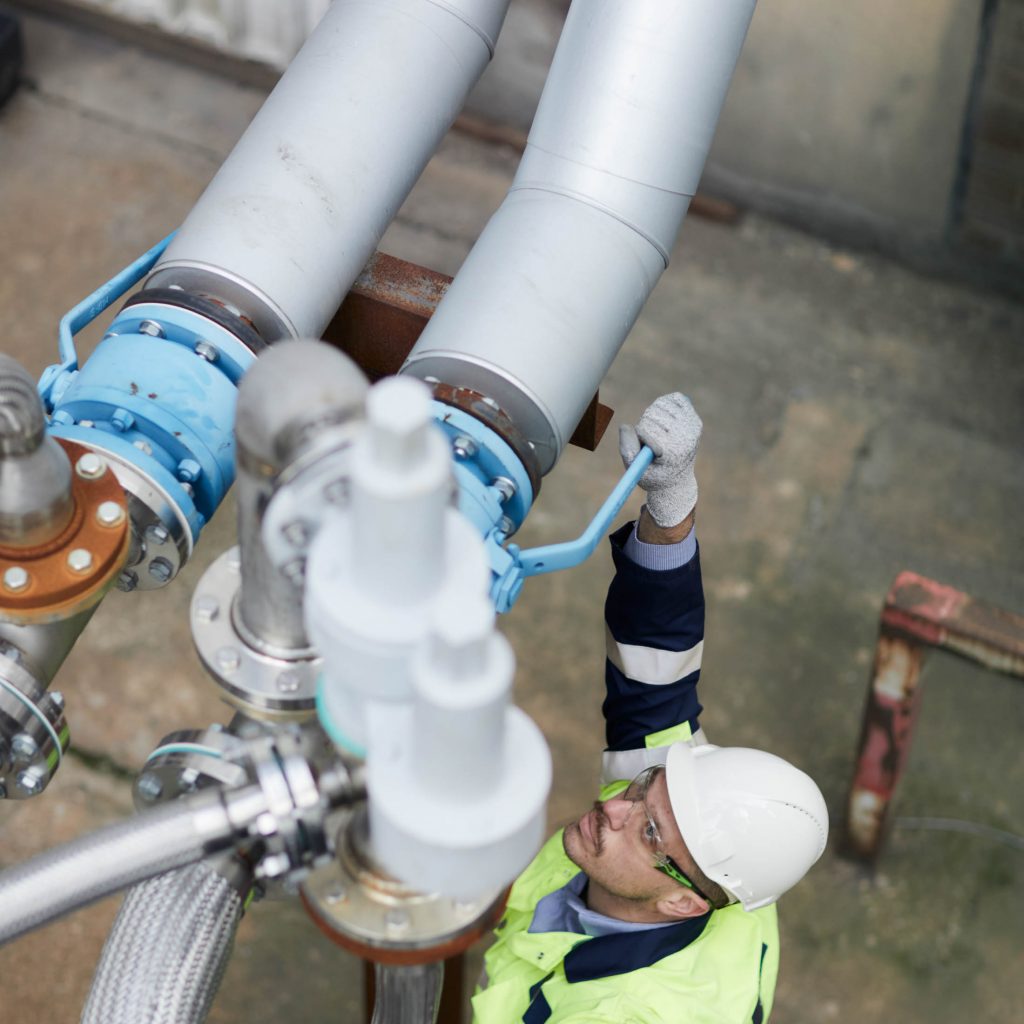
Engineer at BECCS pilot project within Drax Power Station
Helping the UK meet its net zero target
“BECCS (bioenergy with carbon capture and storage) is a key project both for Drax and in helping the UK meet its net zero target. Working together with our technology and engineering partners, we continued to develop the project during 2020, and it is currently approaching the end of the initial engineering design process. Covid-19 has presented some challenges with our partners spread across the globe, but the project team have managed to keep everything on track through hard work, determination, and the desire to deliver this ground- breaking project and help Drax to deliver its purpose. 2021 will continue to be a busy year as we complete our pilot testing, and the project moves into the next stages of development – both technically and via the planning process.”
Carl Clayton
Head of BECCS, Innovation
Keeping our people and plants safe
“Safety is a primary focus at Drax, and at Cruachan we are hugely proud to have had no serious incidents in 2020 and achieved 16 years since our last Lost Time Incident on site. For me, the biggest challenge in 2020 was introducing changes to how we work to ensure we protected colleagues and contractors from Covid-19, whilst continuing to keep our plants running safely and maintaining our focus on potential hazards and our primary safety procedures, to prevent incidents and keep everyone safe. Thankfully, we’ve achieved good safety performance this year at Cruachan, whilst delivering our outages and project work.”
Roddy Davies
HS&E Adviser, Cruachan Power Station

Water outlet into Loch Awe from Cruachan Power Station

Covid-19 impact on executive remuneration
How has Drax taken Covid-19 into consideration when determining executive remuneration outcomes?
A key focus for Drax has been on taking care of the health and wellbeing of employees during thesedifficult times.
The remuneration decisions taken appropriately reflect the performance of the business in 2020, and they are fair and consistent to all employees.
Whilst 2020 was a very challenging year, it was also a year of achievement of which we are rightly proud. Colleagues andmanagement worked hard to deliver our purpose, keep each other safe and continue to deliver our essential services to thecountry. This culminated in strong financial performance and further advancement of our strategic priorities, which are reflected in the remuneration of the Executive Directors, senior management and the wider workforce.
All Drax employees had to adapt to new ways of working in 2020. The health, safety, and wellbeing of employees and contractors has always been of paramount importance, but particularly so in these unprecedented times.
During the year the Committee spent a considerable amount of time reviewing the remuneration and the working practice arrangements of the whole workforce within the context of the challenges of Covid-19. Our priority has been to provide pay stability and security for our workforce, many of whom areclassified as key workers. This included ensuring continuity of pay for those who were unable to work due to illness or caring responsibilities as well as our commitment not to furlough or make redundancies as a result of the impact of Covid-19.
![]() You can find further information on how Drax has supported employees through Covid-19 on page 34.
You can find further information on how Drax has supported employees through Covid-19 on page 34.
In addition to supporting our colleagues, we have also actively supported our customers and communities during this time. For example, we provided free gas and electricity for two months to 162 independent care homes, allowing these vital organisations to divert funds to other priorities. We also providedover 850 laptops with three months of pre-paid internet access to over 50 schools. This has helped to enable students at our partner schools to access lessons from home.
In addition to not utilising any Government support, as explained on page 88, the Board received regular updates on the Group’s liquidityposition, our available cash and other resources which directly informed the decision to maintain both the final dividend in respect of the 2019 financial year which was approved by shareholders at the 2020 Annual General Meeting and paid on 15 May 2020 and the interim dividend which the Board approved in July 2020 and paid on 2 October 2020.
The following table provides a summary of the decisions made by the Committee in 2020 with respect to key components of remuneration. In coming to these conclusions, the Committee considered several factors. These included external advice, theperformance of the Company and the contribution of employees at all levels in delivering the 2020 Group plan and the longer-term strategic priorities. The Committee also considered the extent to which Covid-19 had an impact on financial performance and on ourrange of stakeholders – whether positively or adversely.
Nicola Hodson
Chair of the Remuneration Committee
Committee decision
2021 base salary increases
To increase the level of base salaries for all Directors in line with the average increase made to all employees.
- The Company is supportive of an increase to the salaries of all eligible employees in 2021 which reflects our ability to pay and wider market benchmarking. The increase applied also takes into account our commitment to not furlough or make redundant colleagues due to Covid-19.
2020 annual bonus outcome
To pay the bonus awards in the normal manner, and in line with the Policy, with no adjustment.
- The bonus award is reflective of the Company’s solid performance in a challenging year.
- The Company bonus criteria for Executive Directors are consistent with those for other employees. All eligible employees will receive their bonus.
- Drax maintained its dividend for 2019, paid an interim dividend for 2020 and is proposing a final 2020 dividend for approval at the 2021 AGM, the proposed bonus payments are consistent with the shareholder dividend experience and our capital allocation policy.
- The Company’s balance sheet liquidity and finances are strong.
- We recognise that Covid-19 has brought into sharper focus the responsibilities which we all have to safeguarding our people, our communities and our environment. Within the 2020 scorecard we included targets associated with a combination of safety and engagement with our employees, reputation, as well as ESG measures that included targeting improvement in our CDP rating. Our employee engagement survey achieved 82% score for effective engagement and the Group’s CDP Climate response rating improved from C in 2019 to A- in 2020. More information on the 2020 scorecard can be found on pages 124 and 125. More information on the Group’s wider initiatives on the environment and climate change can be found on page 48.
2021 annual bonus
Continue to use performance metrics and weightings which are consistent with what is stated in the Policy.
- The Company is committed to the operation of a bonus plan for all eligible employees for 2021 and the bonus criteria are consistent for all employees.
- On 8 February 2021, we announced our intention to acquire Pinnacle Renewable Energy Inc., which is subject to Drax and Pinnacle shareholder approval, and court and regulatory approvals. As this transaction would materially impact all metrics in the 2021 Scorecard, it is not possible to set targets at this time for each metric which has been selected for the 2021 Scorecard. The targets will be set as soon as is practicable once there is confirmation of whether the acquisition will or will not proceed. The table on page 132 sets out the metrics which will be included in the 2021 Scorecard.
2018 PSP Vesting
To allow the 2018 PSP award to vest without adjustment in March 2021.
- The Committee is comfortable that the vesting result is appropriate in the context of performance over the three year performance period.
- Drax share price at 31 December 2020 was 39% higher than the start of the performance period (given the averaging periods over which TSR has been calculated this equates to a return of 15% based on the six month averaging period prior to the start and end of the performance period). These returns represent a strong result for our shareholders, particularly in the current environment. Performance is assessed against a broader FTSE 350 comparator group, where the majority of shareholder returns have been negative over the performance period.
- Although Drax’s share price was initially impacted by Covid-19 in early 2020 (as was the case for many companies), it recovered strongly, with a shareholder return of 28% from 1 January 2020 to the end of the year.
- Drax has not benefited from unexpected windfall financial performance as a result of Covid-19, and the Committee is confident that this return represents genuine strong performance and delivery of our strategy in an extremely challenging climate.
2020 LTIP grant
The grant was made on the normal timetable and with the performance conditions and targets agreed with shareholders.
The normal practice of using the three-day average share price immediately prior to the date of grant to determine the number of shares awarded was followed.
- The LTIP performance is measured over a three-year period and therefore the targets remain appropriate.
- The Committee will assess the value of the 2020 LTIP award at vesting and will ensure that the final outturn reflects all relevant factors, including consideration of any windfall gains. In making their assessment the Committee will take into account appropriate advice (e.g. the Company’s auditors, the Committee’s advisers and the Audit Committee), also giving due consideration to the shareholder experience and to what extent the outcome incorporates any windfall gain, which warrants adjustment.
![]() We have provided further information on decisions made by the Committee with respect to Covid-19 in the Annual Statement to Shareholders on pages 109 to 110.
We have provided further information on decisions made by the Committee with respect to Covid-19 in the Annual Statement to Shareholders on pages 109 to 110.
Taskforce on Climate-related Financial Disclosures
Tackling climate change is at the heart of our purpose and Drax is committed to helping the UK and the wider world to achieve its climate targets.
The recommendations of the Taskforce on Climate-related Financial Disclosures (TCFD) provide a framework for consistent disclosure of climate-related information. Drax became a TCFD Supporter in December 2020. Our approach, progress and the next steps of our journey towards meeting the TCFD recommendations in full are summarised below.
In 2020, we responded to the CDP Climate questionnaire, which is aligned to the TCFD recommendations. Drax was awarded a score of A-. We will continue responding to the CDP Climate questionnaire each year.
Governance
Strong governance that embeds climate change in decision-making at all levels of the business
Our approach
Responding to climate change is a core component of our Group governance framework. The CEO reports quarterly to the Board onEnvironment, Social and
Governance (ESG) performance, including climate-related matters. Climate change factors are considered in decisions taken by the Board, reflecting the Board’s duty to consider all stakeholders. Examples
in 2020 include the decision to cease coal generation by March 2021 and the refinancing of the Group’s debt facilities, which link Drax’s carbonemissions to the amount of interest paid on the Group’s debt (see page 26).
Our Climate Policy, approved by the Board, outlines our approach to integrate effective management of climate-related risks and opportunities into everyday decision-making and delivery of our business strategy (available at: www.drax.com/uk/about-us/compliance-and-policies).
Our progress in 2020
In October, the Board reviewed our strategic aims and progress, and re- emphasised Drax’s commitment to our purpose, to enable a zero carbon, lowercost energy future. The Board considered how our strategy aligns with good practice for purpose-driven organisations and committed to explore how this can be further strengthened through 2021.
In 2020, engagement with the Executive Committee and the Board focused on furthering understanding and embedding climate-related matters. Engagement in 2020 included:
- Climate Policy considered and approved by the Executive Committee and the
- 2020 CDP Climate submission signed off by the CEO and
- At the Group’s interim and full year, the Executive Committee and the Board examined the Climate Change principal risk, considering key evolvingchallenges and potential
- The Executive Committee and the Board considered management’s response and future plans for addressing the TCFD requirements, approved initiatives to meet these proposals, and approved Drax becoming a TCFD
Remuneration
Our 2020 Group scorecard included a target to improve our CDP Climate score, linking remuneration to our performance and quality of disclosure on climate change.
Our actions for 2021
- Continue schedule of engagement with Executive Committee and the Board on climate-related
![]() See Corporate Governance Report page 80
See Corporate Governance Report page 80
![]() See Remuneration Report page 108
See Remuneration Report page 108
Strategy
A purpose, strategy, and ambition that places climate change at the heart of what we do
Our approach and progress in 2020
Our purpose – to enable a zero carbon, lower cost energy future – is aligned with the UK Government target to achieve net zero carbon emissions by 2050. Our purpose informs the three pillars of our strategy, outlined below. Our energy market model uses a range of ‘net zero carbon by 2050’ scenarios and the resulting set of planning assumptions enable us to identify actions and the associated capital allocation that we will take across our strategic horizons.
1. To build a long-term future for sustainable biomass: By expanding our sustainable bioenergy supply chain and reducing costs we are developing options for long-term biomass operations – renewable generation, negative carbon emissions, system support services and third party supply of biomass to international markets.
We are investing in the expansion of our pellet production facilities as part of our biomass strategy, targeting to achieve 5 million tonnes of self-supply by 2027 and to reduce production costs. We believe this will give rise to a long-term future for sustainable biomass, which includes the potential for BECCS and negative emissions. This is supported by a robust supply chain that is subject to externally-set regulations and regular audits, to ensure the required standards are met. We are progressing the BECCS business case and technology selection so that we can effectively implement and scale a cost-effective carbon removal technology.
2. To be the leading provider of power system stability: Through a portfolio of flexible and renewable generation, and large industrial and commercial customer supply business, we will provide system support services to allow the power system to utilise intermittent renewable energy accelerating the UK’s decarbonisation en route to 2050.
We believe that as the UK power system decarbonises, demand will increasingly be met by low marginal cost intermittent wind generation.
Historically, the operation of reliable baseload thermal power plants provided both electricity and a full range of non-generation system support services. These services are important to the safe and reliable operation of the system. Given its inherent intermittency, wind power has limited capability to provide these other services, making the system more challenging to manage. Throughout 2020, we provided these services to the power system via our flexible asset portfolio.
3. To give our customers control of their energy: We provide our customers with renewable energy, and the opportunity to control and optimise energy use and cost, helping us support the energy system.
To support the zero carbon and sustainability ambitions of our customers, we are considering and developing the services they need. Our Drax Electric Vehicles (EV) service enables customers to transition to EVs or optimise their existing EV solution. We also provide an Electric Assets service, that helps our customers to optimise the energy usage of their assets and reduce costs.
ESG finance
In 2020, we completed a £300 million Revolving Credit Facility. This includes an embedded ESG mechanism that adjusts the margin of interest paid based on Drax’s carbon emissions per GWh of electricity generated, measured against an annual benchmark. This is consistent with our continued strategic focus on reducing our carbon emissions.
Scenario analysis
We have considered the potential impact of climate scenarios on our business, including robust modelling as part of our capital projects work. Comprehensive modelling was undertaken to assess the current flood risk and the potential future flood risk associated with the redevelopment of Drax Power Station. The assessment considered potential changes in sea level, changes in rainfall and peak river flows based on guidance issued by the Environment Agency (EA).
The EA projections considered data from the UK Climate Projections 2009 (UKCP09), which categorise the range of possibilities from lower impact to upper impact. In compliance with planning requests, the assessment considered the impacts of the central climate projection through to the upper impact projection over a medium time phase, covering the expected life of the asset.
The project identified a risk of flooding in the community and, as a result, a flood relief channel has been included in the plans.
Our actions for 2021
- Undertake scenario analysis exercise.
![]() See Principal Risks and Uncertainties page 66
See Principal Risks and Uncertainties page 66
Risk management
Integration of climate-related risks into our Group-wide risk management approach
Our approach
The assessment and management of climate-related risks is integrated into our Group-wide approach to risk management, as defined by the Group Risk Management Policy. Climate change is a principal risk category assessed within this approach. The climate change principal risk is owned by a member of the Executive Committee and subject to a deep-dive review by the Executive Committee each year. An analysis of all principal risk categories, including climate change, is made and presented to the Executive Committee and Board twice a year.
Our progress in 2020
In 2020, we focused on the development of our climate change principal risk assessment process. We strengthened the assessment of business division specific risks, expanded the detail of our assessment, and identified risk areas for targeted analysis in 2021. A summary of the physical and transition risks identified is provided in Principal Risks and Uncertainties.
In 2020, the Executive Committee examined the climate change risks, challenging the assumptions, mitigations and controls which had been identified.
Our actions for 2021
- Undertake targeted analysis of the risk areas identified for further exploration in 2021.
![]() See Principal Risks and Uncertainties page 66
See Principal Risks and Uncertainties page 66
Metrics and targets
Our ambition is to become carbon negative by 2030
Our approach
Our ambition is to become carbon negative by 2030. This applies across our direct business operations globally (scope 1 and 2 emissions).
We are committed to the Science Based Targets initiative, publicly stating our intent to externally validate that our target is aligned with climate science.
Our progress in 2020
We disclose our scope 1, 2 and 3 greenhouse gas emissions, alongside other key environmental metrics, in the sustainable business section (see page 48).
In 2020, we undertook work to better understand the detail of our scope 3 emissions. We are developing a scope 3 target that enables us to align to the Science Based Targets initiative.
Our actions for 2021
- Set and publish a scope 3 target.
![]() See Carbon Emissions page 49
See Carbon Emissions page 49

Our Covid-19 response
How has Drax managed the impact of Covid-19?
Keeping our people safe, whilst providing energy and critical services.
Throughout the pandemic we have successfully maintained effective day-to-day activities, and supported our people, communities and customers. We continue to maintain our sustainability standards and meet the needs of stakeholders as we progress our long-term objectives and invest for growth.
Organising our response
When Covid-19 was declared a pandemic in March 2020, we had already implemented our crisis management structure to manage information and our response, and to better understand emerging risks. Management and leaders from the business units met regularly to define and communicate the Drax response. Our leadership’s priority was, and will remain, the health and safety of our colleagues.
Delivering our purpose
As a strategic part of the UK’s critical national infrastructure, we continued to supply flexible and renewable electricity, delivering strong strategic, operational and financial performance for our shareholders and various stakeholders. This allowed us to continue to invest for growth, whilst paying a sustainable and growing dividend. Throughout the pandemic, no employees have been furloughed and we have not sought any financial help from the Government.
Supporting our people
We quickly deployed home working for the majority of our non-operational colleagues.
Following school closures in the UK, we introduced two weeks’ emergency paid leave for childcare support. As information on the virus and Government advice developed, we continued to adjust our response accordingly. We introduced a Covid-19 absence policy, extending our emergency arrangements, entitling colleagues that are unable to work due to Covid-19 to full pay.
Health and safety as our top priority
We undertook Covid-19 risk assessments at each of our sites, to identify mitigations to reduce the risks of workplace transmission of the virus. Throughout the year, our operational workforce was able to continue to deliver our business priorities, without a significant impact or transmission of the virus in the workplace. Our Generation business, which has continued to operate as normal, safely delivered several major outages, with large numbers of contractors on our production sites during the summer.
We deployed home working assessments and provided colleagues with suitable equipment to make sure they could work from home safely. We continue to focus on maintaining social distancing, hand hygiene and reduced occupancy of our workplaces. As further waves of virus transmission occur across the country, we are planning to ensure continued provision of adequate support for the health and wellbeing of all our colleagues.
Wellbeing
We surveyed colleagues to understand how they were coping and to identify areas for focus. This was to make sure colleagues continued to feel connected and supported through the challenges presented by Covid-19. To further support our colleagues’ physical and mental wellbeing, we expanded our virtual wellbeing tools and resources offering.
![]() Read more on Wellbeing in our Sustainable Business section, page 58 of the full report PDF.
Read more on Wellbeing in our Sustainable Business section, page 58 of the full report PDF.
Charitable and community engagement
We continued to provide colleagues with ways to engage in community and charity activities. We held national fundraising days, promoted Give As You Earn and shared virtual volunteering opportunities to support local charities and communities facing the impact of the pandemic.
“Our employees’ health and wellbeing are vital, and we work hard to ensure we are supporting them with both their physical and mental health, whether working at home or at one of our sites.”
Will Gardiner, CEO
Supporting our communities
We have sought to help our communities during the Covid-19 pandemic.
Laptops for Learners
Our Laptops for Learners initiative provided 853 laptops, each with three months of pre-paid internet access, to over 50 schools and colleges local to our sites across the UK. The initiative has enabled students at our partner schools in England and Scotland to continue to access lessons from home.
Online educational resources
We launched an online offering to make sure students were able to continue learning. This included creating virtual tours of our assets and educational content, delivering webinars to university students, and providing a virtual experience of work in partnership with Oak National Academy.
“This donation of laptops from Drax is going to make a huge difference to the lives of pupils currently without access to online educational resources – as well as our whole school community after the Coronavirus lockdown is over.”
Ian Clennan, Head Teacher of Selby Community Primary School
Supporting our customers
Throughout the year, we continued the vital supply of power to around 300,000 UK businesses, including organisations most affected by the pandemic, such as care homes, hospitals, schools, and retailers.
Debt support
We focused on providing extra help for our customers facing financial hardship due to Covid-19. We retrained call centre colleagues to equip them with the skills needed to help prevent debt and to connect businesses with the support they might need, including access to Government-backed loans and expert financial help.
We created options for smaller businesses and organisations struggling at this time. For those unable to keep their accounts in balance or pay in full, we created deferred payment plans. We also extended current energy prices for three months to 4,000 customers coming to the end of their contracts, giving those businesses an opportunity to focus on more pressing concerns related to Covid-19.
We donated £150,000 to the specialist debt charity Business Debtline. The funds are being used to set up and run a dedicated webpage and phoneline for our SME referrals over the next two years. This will help businesses recover from the crisis and aims to support their long-term security.
Care homes
We provided free gas and electricity for two months to 162 independent care homes local to Drax’s operations across the UK. This payment freeze allowed these vital organisations to divert funds to other priorities, such as PPE, food and carers’ accommodation.
“Not having to pay our energy bills for two months means we can redistribute our funds to buy essential items, like PPE, to ensure our employees are supported to give our residents the level of care they deserve.”
Mike Smith, Chief Operating Officer of Shaw Healthcare
System stability
Why is there a growing importance for system support services?
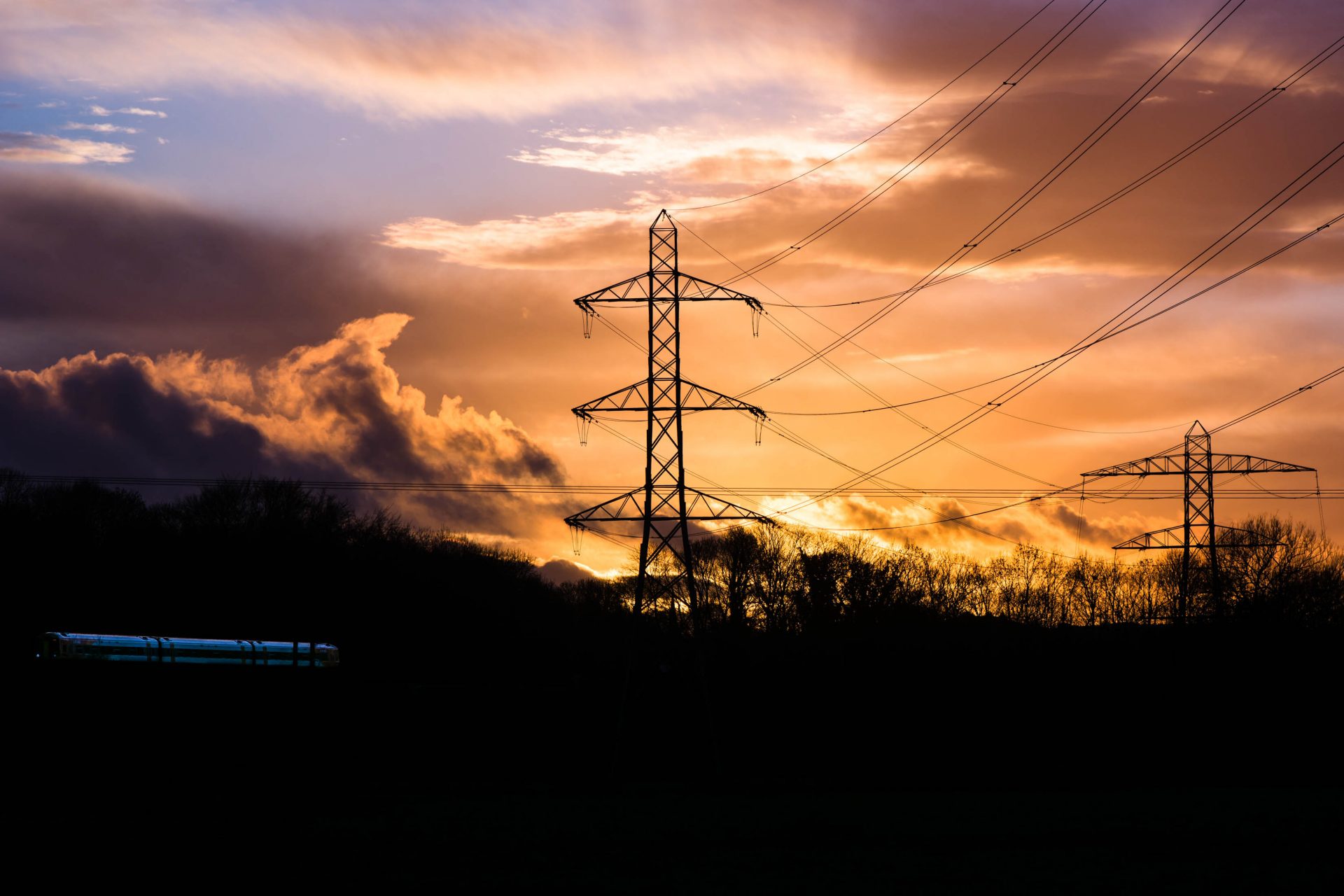
Keeping the lights on requires not just electricity generation, but also a range of non-generation activities which help provide stability, flexibility and reliability, to ensure that electricity supply meets demand, second-by-second.
Electricity must be transported the length of the country, and levels of generation must be managed so they are exactly equal to levels being used (i.e. balanced), and properties like voltage and frequency must be minutely regulated across the whole network.
Ensuring all this happens smoothly relies on the system operator – National Grid – working with power generators like Drax to provide services in addition to power generation that keep the power system in operation, stable and balanced. We call these system support services.
Examples of system support services:
Historically, coal and gas-fired power stations were able to deliver these services as an inherent by-product of producing reliable baseload electricity. Now, coal and older gas plants are being closed down in the UK and being replaced by intermittent renewable energy sources, principally wind. This reduces carbon emissions but makes the provision of these system support services more challenging.
Wind, by its nature, is intermittent and, for the most part, unable to provide system support services. Whilst solar generation may be more predictable than wind, it does not provide any system support services. As demand for system support services increases, there are fewer assets, such as large power stations, able to provide them (see Table 1 below). This is increasing the cost of operating the system and is a growing source of value for generators like Drax which can provide these services.
Frequency response – The automatic change in generation output, or in demand, to maintain a system frequency of 50Hz. Frequency response is required every second of the day.
Voltage control/Reactive Power (MVars) – Reactive power is used to manage power flows around the transmission system and helps to support voltage in the event of a system fault.
Inertia – The stored energy in synchronous generators (i.e. large spinning mass such as a biomass or pumped storage turbine) which slow down the rate of changes in system frequency.
Black Start – The ability of a generation unit to start up without external electricity supplies following a total or partial loss of power from the transmission system.
Reserve – The system operator must be able to ensure a balance between demand and generation at all times to prevent power cuts. This increased and decreased generation is sometimes referred to as headroom and footroom. Managing demand can also be used to the same effect. As we become more dependent on intermittent renewables, we believe that the system operator will require more dispatchable plant like biomass and pumped storage, which can turn up when wind speed drops and, crucially, turn down when wind speeds are high.
Pumped storage is particularly useful as, in addition to providing a full range of generation and non-generation services to the system operator, it allows large-scale wind generation to be stored as hydro-electricity at times of excess electricity production (by using energy from excess wind generation to pump the water to storage), before releasing it back into the electricity grid when required. By way of comparison Cruachan Power Station is four times as big as the world’s largest battery and can run at full load for fifteen hours.
| Generation type | Biomass | Pumped storage | Gas | Hydro | Nuclear | Solar | Wind | Inter connector | Batteries |
|---|---|---|---|---|---|---|---|---|---|
| Power generation | Yes | Yes | Yes | Yes | Yes | Yes | Yes | No | No |
| Frequency response | Yes | Yes | Yes | Yes | Partial | No | Partial | Yes | Yes |
| Reactive power | Yes | Yes | Yes | Partial | Yes | No | Partial | Yes | Yes |
| Voltage management | Yes | Yes | Yes | Partial | Yes | No | Partial | Yes | Yes |
| Inertia | Yes | Yes | Yes | Yes | Yes | No | No | No | No |
| Black start | Yes | Yes | Yes | No | No | No | No | No | No |
| Reserve power | Yes | Yes | Yes | No | No | No | Partial | Yes | Partial |

Cruachan Power Station, Scotland
System support services and Drax:
Drax operates a portfolio of flexible, renewable and low-carbon generation, which is able to provide all of these services. As demand for these services increases, Drax is able to contract with the system operator National Grid to provide a range of non-generation services, such as a six-year contract worth up to £5 million per year awarded to Cruachan for the provision of inertia in western Scotland. The contract does not require Cruachan to produce electricity, but to be synchronised with the electricity system.
Drax also makes its assets available in the short-term balancing mechanism to help National Grid balance the system on a minute -by-minute and hour-by-hour basis.
We are remunerated for system support services via the balancing mechanism, specific bilateral contracts for ancillary services with the system operator. We monitor our performance by measuring the gross profit earned from these activities which we describe as System Support Optimisation.
System support services are principally delivered through generation, but we also have a growing opportunity to provide some of these services through our Customers business.
We provide electricity to large and industrial customers, in addition to SMEs. Working with these larger customers to manage their usage throughout the day, we expect to provide demand-side response services to the electricity market – for example, by reducing demand at times of lower supply and vice versa.
The chart below shows the value derived from system support services and optimisation:
Gross profit (£m)

Giving customers control of their energy
How are we supporting our customers?
In addition to providing our customers with renewable energy, we provide them with the opportunity to control and optimise their energy use, cost and source, and this helps us in supporting the energy system.

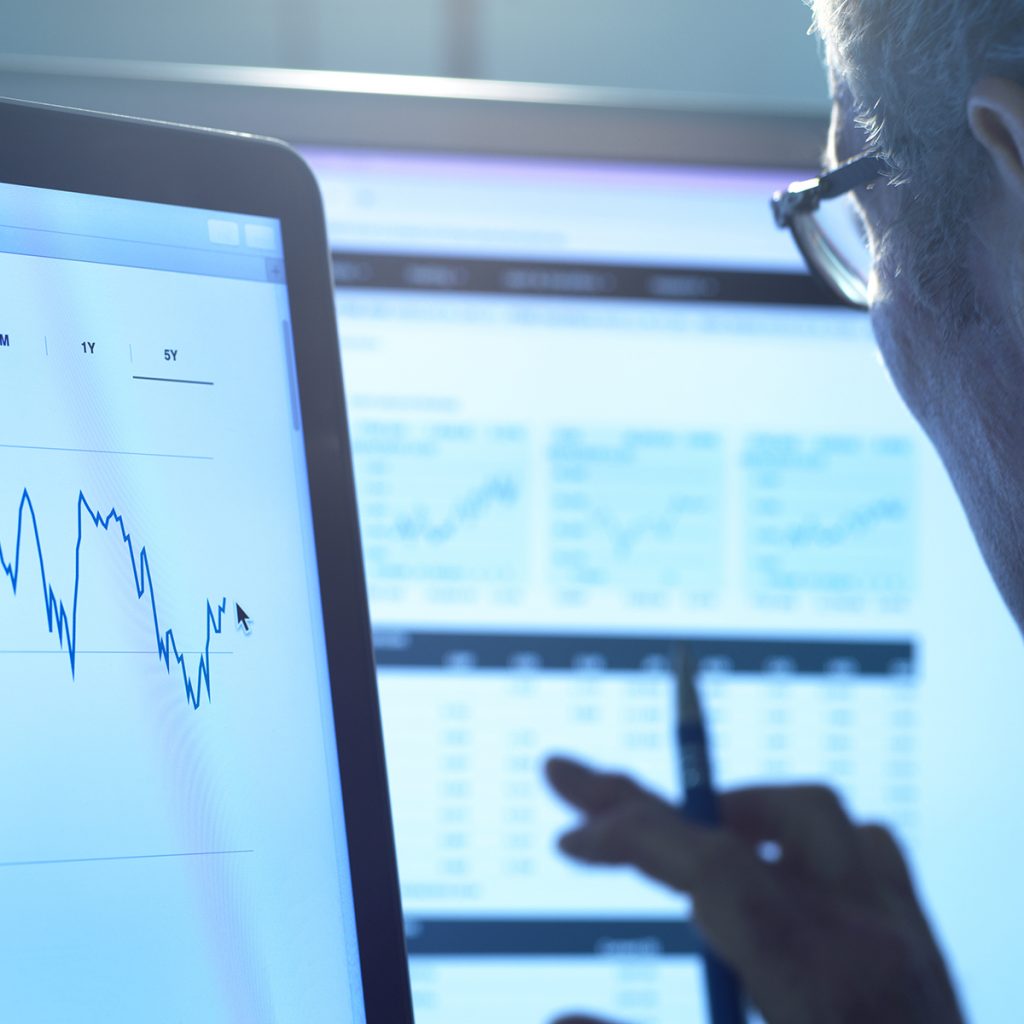
Demand-side response
Drax is a leading provider of renewable energy and services to industrial and commercial customers. Haven Power’s large portfolio of industrial and commercial customers offers opportunities to provide system support services to the energy market and create value for our customers.
In November 2019, United Utilities became the first customer to sign up to Haven Power’s Asset Flex project. Known as Demand Side Response (DSR), customers are provided with financial incentives to turn down, or turn off, non-essential equipment at times of peak demand depending on the customer’s needs.
The latest customer to sign up for this service is Sundown Products, a large industrial site with a range of heavy machinery, providing another new type of asset to control as Haven look to broaden their portfolio and knowledge base across different technologies.
Haven uses technology to turn down or turn off customers’ energy demand in peak times to reduce their costs, and is designed to always work within the constraints set by the customer. For example, we could turn off a water pump within certain limits or time shift a production line. It is simple for the customer: Drax has the opportunity to create value from the asset in the provision of system support services and in exchange, customers get a cheaper unit rate.
Reducing demand, typically at peak times (which are also periods of higher carbon intensity) is another way in which the Group is providing system support services to the UK power system.
Electric vehicles (EVs)
Drax has developed a solution aimed at making it easier for companies, especially those with fleets, to transition to EVs. SES Water was the first partner to take this bespoke package, which includes vehicle suitability assessment, charging infrastructure, operating software, vehicle telematics, maintenance services, and the renewable electricity needed to power the vehicles.
Our energy expertise enables us to approach the challenge of electrification from a different angle, considering on-site energy requirements and deploying smart charging technology that delivers cost and environmental benefits without negatively affecting business-as-usual.
The aim is to deliver EV charging and battery optimisation, which ties into our customer control strategy. By understanding all aspects of EVs from telematics to charge-point hardware and software we are identifying opportunities to create value for customers and the Group.
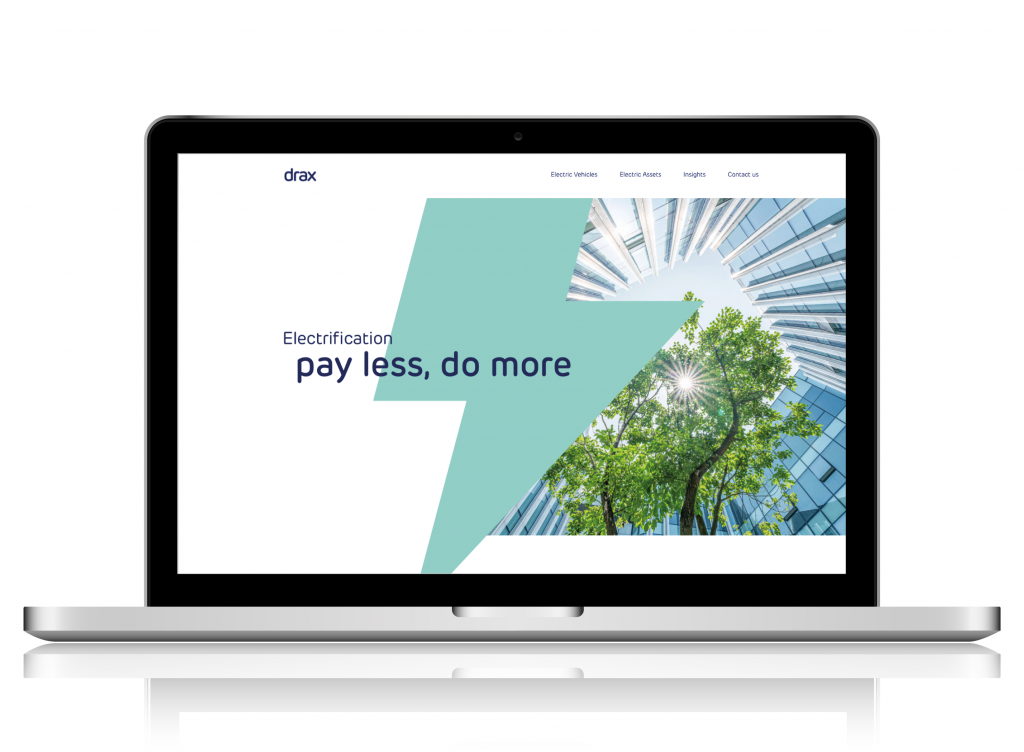
![]() You can read more about this on our electrification for business website www.energy.drax.com
You can read more about this on our electrification for business website www.energy.drax.com

Battery power
Energy storage through batteries is also being tested with customers who already generate renewable energy onsite.
Energy storage is the key to helping customers maximise the benefit of the energy they generate from their own small-scale renewables, providing greater flexibility to the grid and smoothing volatility in the system.
Drax has partnered with energy storage company Eaton, which offers new and second-life batteries, such as used EV batteries, for installations on customer sites. Eaton can quickly scale-up the deployment of small commercial energy storage systems to larger, industrial-scale units, helping to support more customers with energy management solutions.
Engaging our stakeholders
Why is engaging with our stakeholders fundamental to our success?
We recognise that we need to listen to, and work with, a diverse range of interested parties to achieve our purpose: to enable a zero carbon, lower cost energy future
The quality of the Group’s decision making is richer when we actively consider the views of stakeholders.
From our shareholders to our colleagues and from environmental NGOs (eNGOs) to regulators, we recognise that our decisions have an impact far beyond our business. We proactively seek to understand the needs of our stakeholders and act upon them to better deliver our purpose: to enable a zero carbon, lower cost energy future.
Stakeholder relations
The world around us is evolving rapidly, and the expectations on the business are changing too. More than ever before, our role in supporting our stakeholders is central to our strategy. From tackling climate change, to responding to Covid-19 to levelling up the economy, our aim is to be a force for positive change in the communities where we operate and in addressing some of the major global challenges affecting us all.
We recognise that delivering long-term value for our shareholders and customers is closely linked to delivering good outcomes for our climate, environment and communities. These factors continue to drive changes in regulation, policy and public attitudes. Therefore, Drax takes great care to anticipate and respond effectively to the changing world. To that end, the views of all our stakeholders forms a core part of the decision-making process of the Board and the Group.
Drax has a wide range of stakeholders and takes care to ensure that the Group, and the Board, has an effective strategy to identify and engage with them. The Board receives regular reports on stakeholder engagement including from the Corporate Affairs and Investor Relations functions. This ensures that the Board takes into account the views of our stakeholders when making strategic decisions.
Drax’s Communications Strategy contains our stakeholder engagement plan. Presented to the Board at least annually, this sets out and provides oversight of how the Group intends to engage stakeholders. In addition, the Board engages with key communications campaigns to better understand the needs of those stakeholders that our campaigns are targeting. We employ dedicated teams to engage both proactively and reactively with specific stakeholder groups. Our teams include stakeholder relations, strategic communications, investor relations, HR, internal relations, sustainable business, business ethics, media relations and digital engagement.
The methods of engagement we use vary according to the issue and the stakeholder concerned. As Drax changes and grows, we expect the scope and breadth of our engagement with different stakeholders to also evolve.
The following pages 40 to 45 set out the broad stakeholder groups we identified and engaged with in 2020. It also highlights their key concerns, why and how we engaged, and how we responded.
Companies Act, Section 172 Statement
The directors have a duty to promote the success of the Company, having regard to a range of matters and stakeholders. The Board recognises that decisions taken today will shape both the longer-term performance of the business and its impact on our various stakeholders.
The Board is responsible for engagement with a range of stakeholders, and believes that considering the interests of our stakeholders in key business decisions is fundamental to the Group’s ability to deliver sustainable value creation. This consideration enables Drax to have a positive impact on the environment, our communities and wider society over the longer term.
The following pages explain how during 2020 the Board had regard to those matters set out in Section 172 of the Companies Act 2006:
On pages 40 to 45 we set out the Board’s, and more widely the Group’s, comprehensive engagement with stakeholders.
On pages 61 to 63 we describe how we seek to maintain our high standards of business conduct.
On page 88 we describe how the Board responded to the Covid-19 pandemic, including decisions taken to support the workforce and wider community.
On pages 90 and 91 we describe the Board’s leadership of stakeholder engagement, including a focus on Board decision-making and stakeholder and long-term considerations.
On page 92 we describe the Board’s engagement with the workforce.
On pages 32 and 33 we describe the Board’s oversight of TCFD and climate-related risks, and in Sustainable Business on pages 48 to 63 we describe the impact of the Company’s operations on the environment and the community.
Understanding the needs of our stakeholders is essential to our long‑term success
Engagement takes place at many levels of the business and a judgement is made on a case-by-case basis on whether engagement is required by the Board, Executive Committee, senior management or at the operational level. The Group Head of Public Affairs maintains a detailed map of key stakeholders, both internal and external, the concerns they’ve raised and the date of the last meeting. Management keeps under review the relevant stakeholders that may be affected by major decisions.
To ensure clear feedback, the Board receives regular reports from the CEO on key stakeholder relations activity, current issues and the relevant feedback received from stakeholder interaction. These reports are supported by the Group Director of Corporate Affairs, the Corporate Affairs team and the relevant owners of direct stakeholder engagement.
The Board has a duty to promote the success of the Company, as set out in Section 172 of the Companies Act 2006. Supporting this, Board and Executive Committee discussions – and accompanying papers – include information on the stakeholders likely to be affected by items under discussion and the likely impact. This ensures that the interests of all relevant stakeholders, and the need to act fairly between members of the Company, are considered in decision-making.
The most recent detailed review of stakeholder activities was presented to the Executive Committee and the Board in October 2020.
Our stakeholders
![]()
Key concerns
Beyond Coal strategy, diversity and inclusion, response to Covid-19, wellbeing, culture and values, future strategy, trade union relations, learning and development, career progression, Health & Safety, reward and recognition.
Why we engage
To enable employees to be better informed and able to contribute to the delivery of our purpose and strategy, whilst creating a safe and engaging culture and environment where our employees feel valued, respected and listened to. We want all employees to feel they can grow, develop and make a meaningful contribution to our strategy, purpose and communities, whilst building resilience to cope with the context in which we are operating.
How we engage
We maintain regular dialogue with our workforce through our engagement (MyVoice) forums, colleague briefings, weekly updates and Q&A from our CEO and our pulse and annual engagement surveys.
Launched in 2019, the MyVoice forums align to our operating model and forums representing each of the business areas. Each forum comprises sufficient colleague representatives relative to the size of the business, and meet formally each quarter and informally as regularly as each forum feels is appropriate for local needs. Representatives are drawn from across the relevant business unit, and each forum chair has been selected by membership vote. The chairs of each forum come together quarterly to discuss workforce issues across the business, and discuss topics where workforce feedback has been sought by the Board. The chairs then meet with the Chair of the Board of Directors and CEO to discuss the key issues raised, with feedback from these meetings then shared with all forum members.
Matters discussed during 2020 included diversity and inclusion, how effectively our Covid-19 response was communicated, colleague wellbeing in lockdown, and how colleagues would prefer to work in future.
Employees are also able, anonymously, to ask questions of the CEO (“Ask Will”) on any subject. The CEO responds to the latest questions in his weekly email to all colleagues, where he also shares his thoughts and highlights of the week.
How we’ve responded
We’ve listened to and acted on feedback from both the MyVoice forums and other colleague interactions more broadly. This included introducing informal and formal flexible working policies, and a working from home policy and guidance, developing our diversity and inclusion strategy, developing and delivering plans to further support colleague wellbeing including: a dedicated intranet resource; Mental Health Awareness training for managers; building resilience e-learning for all colleagues; raising further awareness of existing wellbeing benefits available and a step challenge to encourage physical fitness and (virtual) social connection, and creating a dedicated intranet resource to clarify the latest guidance and information about Covid-19.
In 2020 employees asked over 1,300 questions in “Ask Will”. Subjects ranged from employees enquiring about the strategy and challenging the CEO so they could gain a deeper understanding of what we do and plan to do, to what Drax is doing to help tackle climate change, what employees can do individually and Will’s own views. Other topics included areas of concern around the business; mental health and wellbeing; pay and benefits around the Group and new or innovative ideas.
Examples of action taken as a result of “Ask Will” questions include increasing our Cyclescheme limit to £2,000, as part of our voluntary benefits offering; our CEO making a statement about Black Lives Matter; and doing more to embed diversity and inclusion through people stories.
Following the coal closure announcement, consultation on all key areas was undertaken with trade unions and employee representatives. Feedback from this process was considered, allowing the Board to assess the process undertaken to date and consider further measures to be implemented, for example resulting in changes and enhancements to the financial and retraining packages.
We also strengthened our Health and Safety function, with the recruitment of a new role of Group HSE Director.
![]() You can read more about our activities on pages 58 to 61 and 92 of the report PDF.
You can read more about our activities on pages 58 to 61 and 92 of the report PDF.

Engaging with stakeholders
Engaging stakeholders through a new approach to negative emissions
There is scientific consensus that to get to “net zero” emissions, we need to address emissions from key sectors that cannot decarbonise as much or as fast as others. Examples include aviation, heavy industry and agriculture. This means that in addition to our efforts to reduce emissions, we also need to invest in technologies that remove carbon from the atmosphere. Leading expert bodies such as the Climate Change Committee, Royal Society, Royal Academy of Engineering and the Electricity System Operator recognise that these technologies will play a crucial role in getting to net zero.
In 2020 the Group engaged with a range of stakeholders on the role of biomass and negative emissions in the energy transition and a post-Covid-19 green recovery. The stakeholders included Government, local MPs, leaders in industry and business, NGOs, think tanks and academics.
The Group’s CEO, Will Gardiner, played a key role in leading the debate on negative emissions, climate change and the importance of Drax’s role in the energy transition. He highlighted our plans to combine sustainable biomass with BECCS, which the International Energy Agency recently described as the most mature of carbon capture technologies. Reflecting the cross-sectoral need for negative emissions technologies, a broad group of companies and industry bodies launched the Coalition for Negative Emissions in October 2020.
The Coalition ranges from farming to aviation and represents hundreds of thousands of workers across some of the UK’s most critical industries. The Coalition jointly wrote to the UK Government outlining a shared vision to build back better from Covid-19 as part of a sustainable and resilient recovery. Enabling the fulfilment of this vision is the development of pioneering projects that can remove carbon from the atmosphere.
Drax has also been championing the potential of the Humber region to lead a green industrial revolution including by deploying BECCS at Drax. A study by consultancy Vivid Economics (November 2020), commissioned by Drax, revealed that tens of thousands of jobs could be created and supported in the Humber region.
To make this happen, cutting edge carbon capture and hydrogen technologies need to be deployed to decarbonise industry and deliver a Zero Carbon Humber. With the right policy framework, these new jobs could begin to be realised as soon as 2024. Developing BECCS at Drax could support thousands of jobs at its peak, including in construction, supply chain and the wider economy. This could kickstart a new carbon capture and hydrogen industry in the UK.
The Prime Minister’s ‘Ten Point Plan for a Green Industrial Revolution’, published in November 2020, increased support for carbon capture and storage projects and accelerated timeframes for delivery. It also recognised the role of carbon capture and storage in helping “decarbonise our most challenging sectors, provide low carbon power and a pathway to negative emissions”. In addition, it acknowledged the creation of “SuperPlaces” in areas such as the Humber where these technologies could be deployed.
Key concerns
Drax strategy, Covid-19 response, capital allocation and dividend policy, the Capacity Market, share price, financial and operational performance, biomass sustainability, funding, engagement with policy makers, and remuneration.
Why we engage
Engagement allows us to understand the concerns and priorities of current and prospective investors, and lenders. We can then take these into account in our decision-making in areas such as ESG matters; executive pay; dividend and longer term capital allocation policy; as well as strategy.
How we engage
We actively engaged with shareholders to explain the impact of Covid-19 on the Group. In addition to our full and half-year results we issued a trading update in April, early in the pandemic, in which we set out our expectations for the Group as a result of Covid-19. Reflecting the constraints on face-to-face meetings, most meetings have been calls and video calls with existing shareholders and new investors. We engage through a wide range of channels including our website, AGM, full-year and half-year results. We also have an ongoing programme of investor relations meetings. The Chair and Senior Independent Director are available to speak with investors. In 2020 the Chair of the Remuneration Committee wrote to a number of shareholders and institutional bodies regarding executive pay, outlining how we were formulating the Directors’ Remuneration Policy in response to feedback provided from engagement undertaken during 2019.
How we’ve responded
Reflecting feedback from investors and an investor perceptions study completed in 2019, we continued to develop our programme of ESG reporting and engagement, which includes developing our reporting towards the disclosure requirements for TCFD, which we include in this year’s annual report. Our Head of Investor Relations and Head of Climate Change undertook an ongoing programme of ESG focused meetings with shareholders and investors, primarily focused on biomass sustainability and carbon accounting.
![]()
Key concerns
Future opportunities for employment, investment, tackling climate change, our local environmental impact, community initiatives and sponsorship, action in response to Covid-19.
Why we engage
Drax is an active participant in the communities in which it operates. Strong community relationships strengthen our licence to operate in those areas.
How we engage
We engage regularly with the communities around our businesses through supporting local initiatives, and holding quarterly meetings and formal drop-in sessions.
How we’ve responded
In February 2020 we donated £25,000 to support the local community around Drax Power Station which had been adversely affected by severe flooding. We donated $30,000 to help families and businesses in the parishes around our pellet mills in Louisiana and Mississippi in the US, adversely affected by both the Covid-19 crisis and tornadoes in the Monroe area. In September 2020 we donated $20,000 to help families in north eastern and central Louisiana who were adversely affected by Hurricane Laura.
As a board member and funding partner of the Galloway Glens Landscape Partnership Scheme, we support its work to create local opportunities for a sustainable future. This work includes the recovery of salmon fish stocks, which is a big issue locally and across Scotland, and working together to support STEM education.
Colleagues have undertaken a range of volunteering and charitable work. This has included volunteering, outreach to partner schools in our communities, Group-wide fundraising days and colleagues’ personal fundraising efforts, for which Drax offers matched funding.
![]()
Key concerns
Energy costs, response to Covid-19, customer service support, Third Party Intermediary relationships, sales and product details, energy efficiency, managing their own carbon footprint.
Why we engage
Engagement allows us to better understand our customers’ needs and how we can deliver continuous improvement in customer service.
How we engage
Our Customers business engages with our customers through a variety of channels including social media, our website, by phone and through our complaints procedure.
How we’ve responded
We listened to how customers were being affected by Covid-19 and took several measures to support them: we retrained call centre colleagues to equip them with the skills to help customers in need, created deferred payment plans and donated £150,000 to Debtline, a specialist debt charity.
We provided free gas and electricity for two months to care homes local to our operations. You can read more about these actions on page 35.
We also engaged with Government on behalf of customers, advocating for access to Government support for SMEs and micro-businesses.
![]()
Key concerns
Energy costs, decarbonisation, Carbon Price Support, Brexit, Capacity Market, climate change mitigation, biomass sustainability, Renewable Obligation Certificate (ROC) cap, development of policy to support BECCS, delivery of the UN Climate Change Conference (COP26), unabated coal closure, Covid-19.
Why we engage
Constructive engagement with Government and political bodies is key to Drax’s purpose to enable a zero carbon lower cost energy future.
How we engage
We regularly engage with regulators in the UK, EU and US on a broad range of topics including the need for decarbonisation, the role of biomass and carbon capture and storage policy, and the need for system stability and flexible generation. For example, in the UK we engage with political stakeholders at party conferences through all-party groups. While Drax makes no political donations in the generally accepted definition of the term, it is important that we engage with politicians, political parties, policy makers and other stakeholders. You can read more about this on page 136.
Our political engagement policy, which was developed in direct response to shareholder feedback, remains unchanged from 2019 and is available on our website: drax.com/about-us/drax-political-engagement-policy/
How we’ve responded
Throughout 2020 Will Gardiner participated in regular industry-wide forums with the Secretary of State for Business Energy and Industrial Strategy and the Minister for Energy on the response to Covid-19. In response to requests from several political bodies we commissioned Vivid Economics to assess the socio-economic impact of developing BECCS at Drax Power Station. Will Gardiner has joined the Scottish Government’s Green Recovery Taskforce, which was set up by the First Minister of Scotland to support Scotland’s recovery from Covid-19.
![]()
Key concerns
Biomass sustainability, coal and gas, climate change, Carbon price support.
Why we engage
Engagement with NGOs helps us to challenge and enhance our practices on behalf of the wider society. We warmly welcome engagement with NGOs and the advice and guidance they bring to our operations. This year, for example, we engaged with Greenpeace, WWF, RSPB and many other eNGOs.
How we engage
We engage directly with NGOs on a wide range of topics from biomass sustainability through to carbon pricing. For example, our new Responsible Sourcing Policy for woody biomass addresses stakeholder issues and was developed following a series of roundtable discussions.
How we’ve responded
In May 2020 Drax issued a consultation to key stakeholders – including NGOs – on a new Biomass Carbon Calculator. It lasted until June 2020 and in November 2020 we published a summary of responses, alongside an amended Calculator that accounted for stakeholder views. The Calculator is available on our website: www.drax.com/uk/sustainability/the-biomass-carbon-calculator/
In 2020 we asked the Independent Advisory Board to review our sourcing policy. This came about in light of the new, scientific understanding of the climate impacts of woody biomass developed by the UK’s leading forest science body, Forest Research. The IAB confirmed that our sourcing policy was in line with the Forest Research recommendations.
![]()
Key concerns
Targeted Charging Review, smart meter installation, energy trading compliance, environmental compliance, Health & Safety compliance, compliance with biomass sustainability policy, system support and ancillary services markets, ROC compliance, and business ethics compliance, including data protection.
Why we engage
Engagement with Ofgem and the Electricity System Operator allows us to promote and deliver a secure, reliable network at least cost to the consumer. We support a level playing field for all technologies, enabling an efficient and investable market. In addition, engagement with Ofgem, environmental agencies and the ICO enables us to promote best practice and ensure we remain compliant with latest guidance.
How we engage
We engage directly with stakeholders and through industry associations. For example, we engage with relevant teams at Ofgem and National Grid on the growing need for stable markets and appropriate support mechanism to provide system support services to the grid.
How we’ve responded
Following a request from Ofgem on the role of pumped hydro storage in the future energy system, we’ve created a presentation outlining potential support mechanisms and shared with Ofgem’s market development team.
We are also in discussion with Ofgem on potential market solutions to deliver system support services that enable greater deployment of intermittent renewables while also maintaining safe and stable networks.
![]()
Key concerns
Skills to support future employment, local environmental impact, community initiatives and sponsorship, “levelling up” and supporting STEM jobs.
Why we engage
Our aim is to improve skills, education, employability, and opportunities, with a particular focus on supporting under-represented sections of society. Engagement with schools and colleges allows us to promote interest in science, engineering and the energy sector and to support educational institutions in developing the workforce of the future.
How we engage
We engage directly with schools and colleges and offer virtual learning opportunities, in addition to free access for all students to our site tours during term time. Our partnerships with organisations such as Teach First support the delivery of our activities with schools.
How we’ve responded
In October 2020 Drax committed £180,000 in a new five-year partnership with Selby College. This will enable the college to deliver community education programmes and support for retraining. Such initiatives will help students develop the skills needed in innovative clean technologies which will assist in the delivery of a zero carbon economy in the future.
Following the temporary closure of our Visitor Centres and site tours in response to Covid-19, we expanded our online educational offering in 2020. To provide opportunities for continued learning, we also donated laptops with internet access (see page 35 for more information) and delivered virtual tours, university webinars, and a virtual experience of work in partnership with Oak National Academy.
We fund PhD studentships on a range of different topics, including engineering, policy and forestry.
You can read about our work supporting young people and teaching them the skills for a green economy on page 56 of the full report PDF.
![]()
Key concerns
Expected standards of conduct and satisfactory responses to our due diligence requests, Prompt Payment Code, provision of guidance regarding statutory obligations (such as Modern Slavery Act) and the end of the EU transition period.
Why we engage
We’re committed to conducting business with honesty and integrity and in accordance with applicable laws and regulations. Strong relationships with suppliers and contractors allow us to work together to ensure health and safety risks are identified and properly managed, promote high standards and ensure realistic, and shared, expectations on project delivery.
How we engage
Drax’s procurement, business ethics and sustainability functions engage directly with suppliers around key issues to ensure our values and our policies are effectively incorporated into and upheld throughout our supply chain. We also seek the views of suppliers and contractors to collaborate on improvements in standards and meeting our obligations under law, and regulations which are in keeping with our values.
How we’ve responded
In preparation for the end of the EU transition period, we’ve engaged with several of our largest suppliers. This engagement has helped inform our internal Brexit preparation led by the Chief Transformation Officer. In turn, we’ve used this information to support the Government in the development of new procedures including on decisions about critical goods. In October 2020, the Board approved a new Supplier Code of Conduct which we are rolling out to all suppliers, to support understanding of how we can work together to meet high standards.
![]()
Key concerns
Carbon pricing, carbon capture and storage (CCS) policy, biomass sustainability, future energy policy.
Why we engage
Engagement allows us to keep abreast of the latest thinking, consider likely policy developments across a range of areas and consider new opportunities for innovation and collaboration.
How we engage
We engage with think tanks and academics through direct participation in events and round tables. We directly sponsor several PhDs at British universities. We established an Independent Advisory Board (IAB) on sustainable biomass, which advises Drax on feedstock options, forest science and the role of sustainable biomass in our climate change mitigation activities. This allows us to follow the latest scientific research and best practice.
How we’ve responded
In response to concerns raised by think tanks and academics regarding biomass carbon neutrality, we performed and published forest catchment area analyses which were discussed by the IAB.
The IAB meets four times per year and regularly provides feedback and recommendations to Drax. Meeting agendas, and a high-level summary of the minutes and recommendations, are published on our website www.drax.com/uk/sustainability/independent-advisory-board-on-sustainable-biomass/. You can read more about the IAB on page 55.
We also sit on steering groups of several multi university research projects and provide industry input, for example the SuperGen Bioenergy consortia in the UK, and International Energy Agency – Bioenergy work programmes.
![]()
Key concerns
Energy policy, reputation of energy sector, reputation of biomass sector, Health & Safety best practice.
Why we engage
Active membership of a wide range of trade and industry associations allows us to keep track of best practice in our sector and other industries.
How we engage
We engage directly with trade bodies focusing on energy and sustainable forestry. For example, Drax is an active member of Energy UK, Biomass UK and the CBI.
How we’ve responded
Drax’s Director of Corporate Affairs sits on the Board of Energy UK. Last year, Energy UK’s Board took a role in strategically advising the Brexit working group on areas of focus ahead of the end of the EU transition period. This included enhanced engagement between the industry and ministers.
We actively engage at a working level on shared interests in the energy sector such as carbon pricing, education and skills. We also work with businesses from all sectors on shared national and regional priorities. This includes being members of Scotland’s Economic and Social Forum and the Northern Powerhouse Partnership.
Andy Skelton, CFO, represents Drax on the board of the Northern Powerhouse Partnership, and Executive Committee member Mike Maudsley is a member of the CBI Yorkshire.
Working hard to support our customers
“We’ve been working hard since March 2020 to help our customers who have been affected by Covid-19. For example, I worked with a hairdressing business to understand their situation and needs and we set up a mutually agreeable payment plan and put the customer in touch with Business Debtline (BDL). BDL is a charity we’ve worked with throughout the pandemic, including with a donation of £150,000. They provide free debt advice and dedicated support to business owners and helped our customer with budgeting, prioritisation and contacting creditors. We’re still working with the customer to help them get back on track. They’re feeling more confident about overcoming their challenges and building a more resilient business.”
Taylor Moon
Customer Collections Advisor, Customers

Clatteringshaws Loch part of the Galloway Hydro Scheme
Working in partnership with our communities
“Working in partnership with our communities is a core part of how we do business. We support the Galloway Glens Landscape Partnership (GGLP) which aims to promote the area’s heritage, boost the local economy and support sustainable projects. We joined the GGLP and Dumfries & Galloway Council at a Climate Emergency public meeting, to provide an insight into how our Galloway Hydro scheme will play its part in helping the region achieve its net zero carbon target by 2025. We’re also supporting the Galloway Fisheries Trust, through a £17,000 donation. to improve water quality and habitats. I’m proud of the support Drax provides these projects and the innovative and exciting learning opportunities they present for young people and local communities.”
Stuart Ferns
O&A Manager, Galloway Hydros
Chapter 8:
Sustainable business
What is our approach to sustainable business?
At Drax, we believe that achieving a positive economic, social and environmental impact is key to delivering long-term value creation.
Sustainable business governance
The Board has ultimate responsibility for the Group’s sustainability performance and receives quarterly environment, social and governance updates from the CEO. The Executive Committee, chaired by the CEO, oversees performance. The Group Director of Corporate Affairs leads Drax’s sustainability programme and is a member of the Executive Committee.
Drax is a participant of the United Nations Global Compact (UNGC) and sits on the UNGC UK Advisory Group.
Our priorities
We have identified non-financial priorities that are material to our business and important to our stakeholders. Our 2020 progress is reported under each priority area as follows:
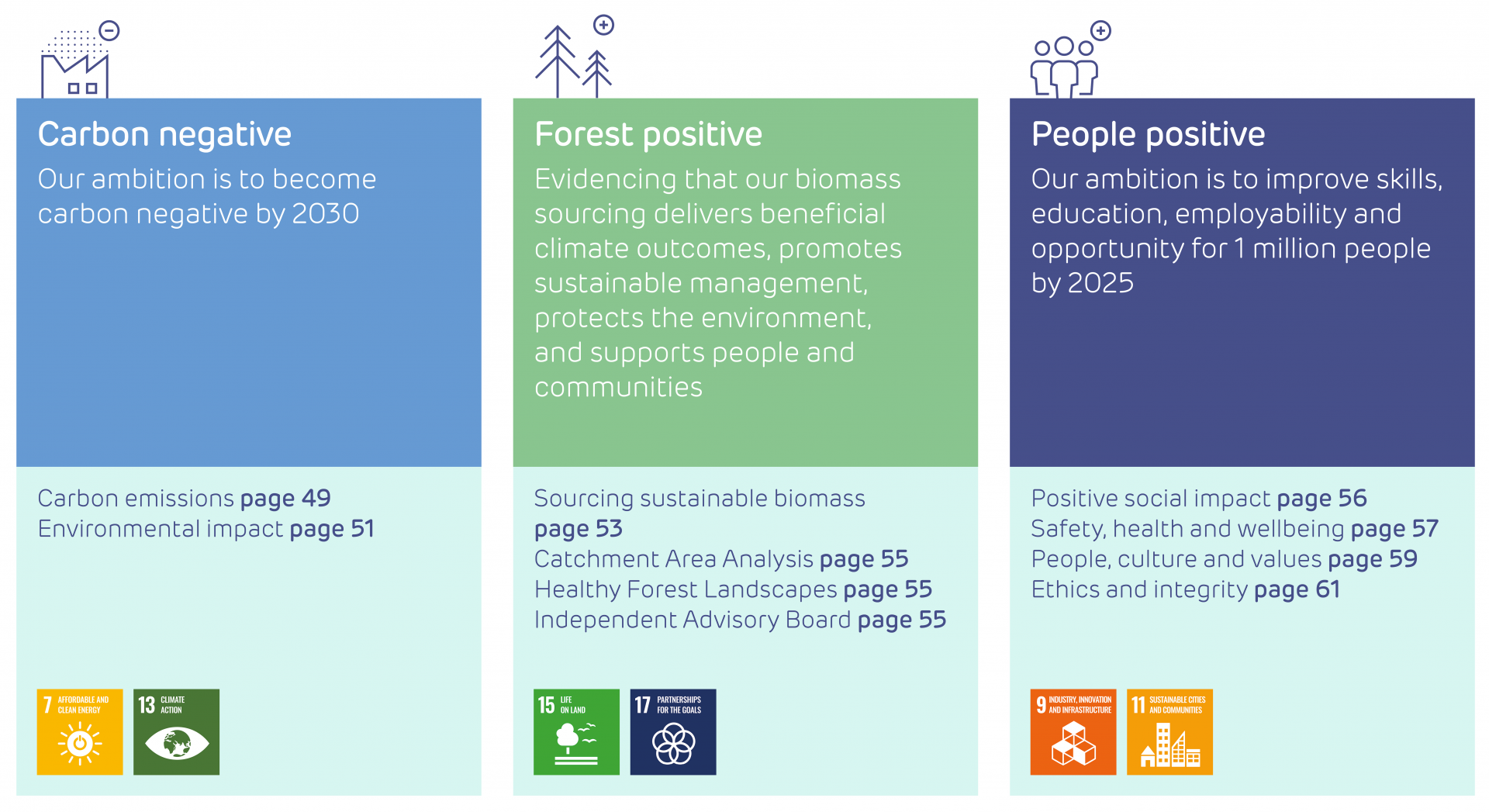
 Carbon negative
Carbon negative
Our ambition is to become carbon negative by 2030
Carbon emissions
Tackling climate change is at the heart of our purpose and we are committed to helping the UK and the wider world to achieve its climate change targets.
Our negative emissions ambition
Drax’s ambition is to become carbon negative by 2030, using technologies such as bioenergy with carbon capture and storage (BECCS) to remove more carbon from the atmosphere than we produce throughout our direct business operations. We are committed to the Science Based Targets initiative (www.sciencebasedtargets.org), to further assure that our target is aligned with climate science.
Innovating to decarbonise our business
Carbon capture, utilisation and storage is part of our business strategy. In 2020, we installed our second BECCS pilot at Drax Power Station, whilst moving our full-scale design into the next stage of detailed engineering. Drax is one of the founding members of the Zero Carbon Humber Partnership (www.zerocarbonhumber.co.uk), a consortium of energy and industrial companies working to develop the UK’s first zero carbon industrial cluster by 2040.
Taskforce on Climate-related Financial Disclosures
We are committed to the management and disclosure of our climate change risks and opportunities in line with the recommendations of the Task Force on Climate-related Financial Disclosures (TCFD). Our Climate Policy outlines our approach (www.drax.com/uk/about-us/compliance-and-policies). See our TCFD summary on page 32.
Flexible, renewable and low-carbon energy
Our Generation business operates a portfolio of flexible, renewable and low-carbon assets to support the energy system’s growing use of intermittent renewable energy. In 2020, 77% of the power generated by Drax was renewable.
Our Customers business is the largest supplier of renewable electricity to businesses by annual consumption and provides a route to market for over 2,000 renewable generators. For the first time, 100% of the electricity procured and supplied by Haven Power and Opus Energy during the 2019-2020 Ofgem reporting year was from renewable sources. Our Customers business also sold 2.8TWh of gas to customers in 2020.
Our Customers business fuel mix disclosures are available at:
www.drax.com/uk/opus-sources
www.drax.com/uk/haven-sources
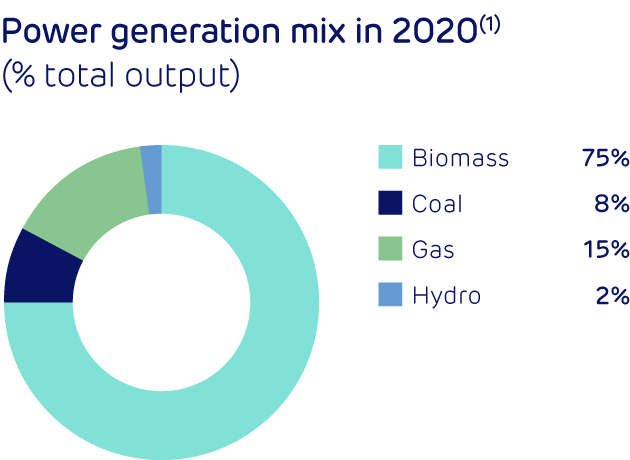
(1) Commercial generation output
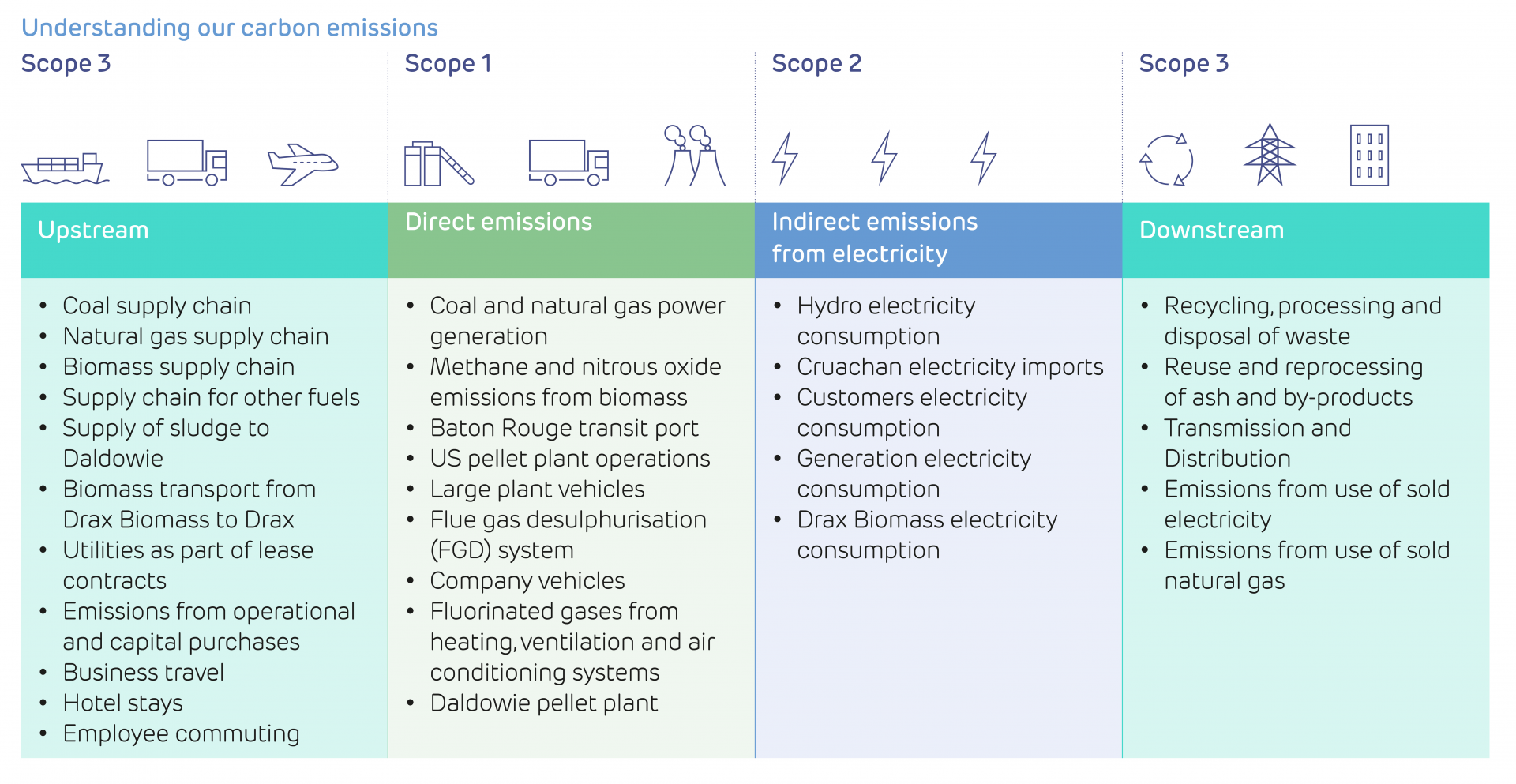
| Unit | 2020 | 2019 | 2018 | |
|---|---|---|---|---|
| Carbon Emissions | ||||
| Generation CO 2 emissions (1) | ktCO2 | 2682 | 1958 | 4139 |
| Group total scope 1 (2) | ktCO2e | 2,762* | 2049 | 4233 |
| Group total scope 2 (location-based) (3) | ktCO2e | 318* | 322 | 252 |
| Group total scope 2 (market-based)3 | ktCO2e | 318* | - | - |
| Group total scope 1 and 2 (location-based) | ktCO2e | 3,080* | 2371 | 4484 |
| Proportion of Group emissions within the UK | % | 95.3* | 93.2 | 96.5 |
| Group total scope 3 (4) | ktCO2e | 3,135* | – | – |
| Biologically sequestered carbon (5) | ktCO2e | 13273 | 12795 | 13019 |
| Total energy consumption | ||||
| Group total energy consumption | kWh | 48,253,807,865* | 46025306198 | 50269781751 |
| Group total energy consumption within the UK | kWh | 47090524296 | 43852816521 | 48075425472 |
Note: Carbon emissions are reported against a criterion of operational control. Carbon emissions are reported in units of carbon dioxide equivalent (CO2e) and include all greenhouse gases as required by the GHG Protocol. A materiality threshold of 75tCO2e/year is applied. For the basis of reporting see www.drax.com/uk/sustainability.
(1) Generation emissions covers all direct emissions from our own business operations that fall under the scope of the European Union Emissions Trading System (EU ETS)
(2) Group total scope 1 covers all direct emissions from our own business operations, across all sites
(3) Group total scope 2 covers all indirect emissions associated with our electricity and heat consumption, across all sites
(4) Group total scope 3 excludes downstream leased assets
(5) The biogenic carbon emissions resulting from generation are counted as zero in official reporting to both UK authorities and under the European Union Emissions Trading System (EU ETS) as the use of sustainable biomass is considered to be CO2 neutral at the point of combustion. This methodology originates from the United Nations Framework Convention on Climate Change
* Limited external assurance using the assurance standard ISAE 3000 and based on Drax using the Corporate Greenhouse Gas Protocol, for 2020 data as indicated. For assurance statement and basis of reporting see www.drax.com/uk/sustainability
Direct carbon emissions (scope 1 and 2)
In 2020, our absolute carbon emissions (scope 1 and 2) increased by 30% compared with 2019. This reflects an increase in coal generation in 2020, as remaining coal stocks were used ahead of the planned closure of commercial coal generation at Drax Power Station in March 2021. In addition, Shoreham Power Station was fully operational in 2020, following outage work completed in 2019.
Since 2012, our absolute carbon emissions (scope 1 and 2) have fallen more than 85%, with four of the six generating units at Drax Power Station converted to biomass from coal.
![]() For breakdown of emissions by greenhouse gas type see www.drax.com/uk/sustainability
For breakdown of emissions by greenhouse gas type see www.drax.com/uk/sustainability
Energy and carbon reduction initiatives
In 2020, we invested in significant upgrades to our turbines and associated equipment at Drax Power Station and Shoreham Power Station, which will result in lower carbon emissions and improved energy efficiency. At Cruachan Pumped Storage Power Station, work to replace four sulphur hexafluoride (SF6) circuit breakers with vacuum circuit breakers was completed in 2020, reducing the total potential for emissions from this source by up to 500 tCO2e per year.
Indirect carbon emissions (scope 3)
We recognise the impact our carbon emissions have across the value chain. In 2020, we undertook work with a third party, to better understand our scope 3 emissions in areas such as purchased goods and services, and capital expenditure. We are developing a scope 3 target that will enable us to align to the Science Based Targets initiative.
The primary contribution to our scope 3 emissions comes from our fuel and energy related activities. This includes fuel supply chains, such as biomass, natural gas and coal. The second largest contribution comes from the use of sold products. This includes the end use of gas purchased and sold by our Customers business. For further breakdown of our scope 3 emissions see www.drax.com/uk/sustainability.
Carbon intensity performance
Between 2012 and 2020, our generation carbon intensity has fallen more than 80%. This reflects the conversion of four generating units at Drax Power Station from coal to biomass, and the expansion and diversification of our generation portfolio to include hydro.
| Unit | 2020 | 2019 | 2018 | |
|---|---|---|---|---|
| Carbon intensity | ||||
| Generation (1) | TWh | 18.8 | 17.3 | 18.3 |
| Generation emissions per GWh of electricity generation | tCO2/GWh | 143* | 113 | 226 |
| Group emissions per GWh of electricity generation (2) | tCO2e/GWh | 164* | 137 | 245 |
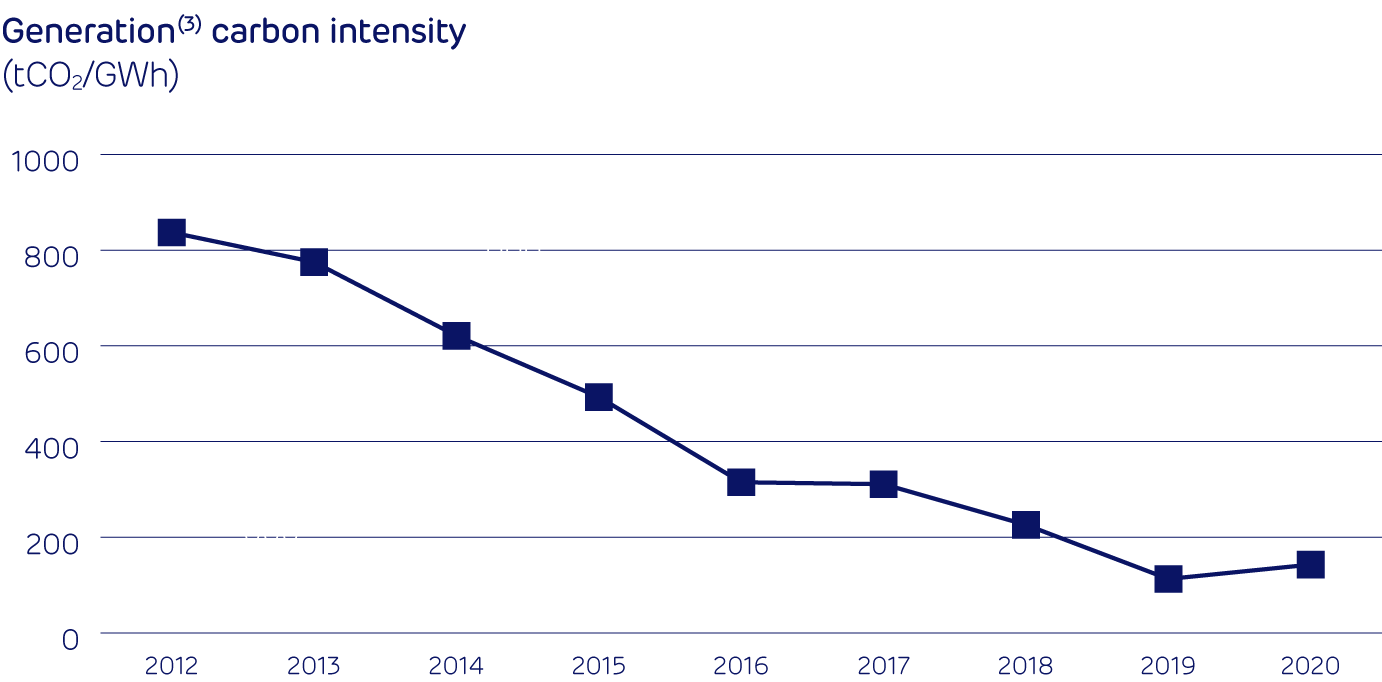
(1) Excluding Cruachan Power Station which utilises electricity import for pumping to balance the grid
(2) Group emissions are total scope 1 and 2 emissions as reported
* Limited external assurance using the assurance standard ISAE 3000 and based on Drax using the Corporate Greenhouse Gas Protocol, for 2020 data as indicated. For assurance statement and basis of reporting see www.drax.com/uk/sustainability
Environmental impact
As a major electricity producer and retailer, and producer of sustainable biomass fuels, we take our responsibilities to society and the environment seriously. We are committed to managing and monitoring our environmental impact. We seek to reduce the environmental impacts caused by our business through continual improvement of our operations, with particular focus on emissions to air, discharges to water, disposal of waste and the use of natural resources.
Each business unit reports monthly on environmental incidents and near misses, and the Board receives monthly reports. We also seek to respond to, and track actions taken from, any environmental complaints made in relation to our operations. We investigate all environmental events to ensure that root causes are established, and lessons are learned and shared across the business.
Environmental Management Systems
In the UK, our Generation assets are certified through their respective management systems to ISO 14001:2015 and are subject to regular external audits. In the US, our Pellet Production sites operate under an environmental management system that is aligned, but not certified, to the principles of ISO 14001:2015. During 2020, we established a platform to collate our environmental monitoring data for our US sites. This produces regular reports and provides alerts as environmental limits are close to being reached.
In 2020, across our UK sites, we had two confirmed minor permit breaches related to air emissions at Daldowie Fuel Plant during emissions testing. At Daldowie, we delivered sustained improvements to our odour minimisation strategy to address neighbourhood odour complaints, as required by the Scottish Environment Protection Agency (SEPA), which substantiated six complaints in 2020. In September 2020, we commissioned an additional regenerative thermal oxidiser, to further treat exhaust air before it is released to the atmosphere.
We are working to resolve an odour issue at Drax Golf Course, due to improper material being brought on site by a third party. As ultimate landowner, we are working with the Environment Agency (EA) and other stakeholders to resolve the issue.
In 2020, across our US sites, we had two notices of non-compliance issued by the authorities. One notice related to incorrect handling of wet electrostatic precipitator (WESP) material at our LaSalle site. The other notice related to exceeding VOC emissions limits at our Amite site in 2018. In 2020, the Mississippi Department of Environmental Quality (DEQ) and Drax agreed a $2.5 million settlement for the violation of VOC emissions limits, dating between 2016 and 2020. During 2020, the Board was kept informed and tracked progress in addressing corrective actions.
We established an open and direct partnership with the DEQ in the US states in which we operate to focus on settling the emissions to air actions and agreeing a path forward. We commissioned a full third-party environmental audit covering each of our US sites, with a focus on positive action plans to improve our environmental performance, and we track our actions to closure on a monthly basis.
Emissions to air
At Drax Power Station, we have focused on the new requirements of Annex V of the EU Industrial Emissions Directive and established a transition plan for compliance. We continue preparations to deliver improved performance considering the Industrial Emissions Directive. These new Best Available Techniques Reference Document (BREF) levels will become the reference point for setting permit conditions and have included tighter limits for emissions of nitrous oxides (NOx), sulphur dioxide (SO2), mercury and particulate matter (PM). Drax Power Station will operate within BREF limits from August 2021.
Thermal Generation emissions to air by fuel type
| Unit | 2020 | 2019 | |
|---|---|---|---|
| Biomass generation (1) | |||
| Nitrogen oxides | t | 6,971 | 7104 |
| Sulphur dioxide | t | 1,806 | 986 |
| Particulates | t | 419 | 415 |
| Coal generation (2) | |||
| Nitrogen oxides | t | 1,949 | 746 |
| Sulphur dioxide | t | 1,209 | 601 |
| Particulates | t | 147 | 35 |
| Gas generation (3) | |||
| Nitrogen oxides | t | 578 | 625 |
| Carbon monoxide | t | 284 | 71 |
UK Biomass Production(4) emissions to air
| Unit | 2020 | 2019 | |
|---|---|---|---|
| Nitrogen oxides | t | 3.31 | 4.76 |
| Sulphur dioxide | t | 2.24 | 1.68 |
| Carbon monoxide | t | 2.46 | 1.76 |
| Particulates | t | 0.31 | 0.04 |
US Biomass Production emissions to air
| Unit | 2020 | 2019 | |
|---|---|---|---|
| Nitrogen oxides | t | 427 | - |
| Carbon monoxide | t | 567 | - |
| VOCs | t | 2,983 | - |
| Particulates | t | 489 | - |
(1) Biomass generation covers units 1, 2, 3 and 4 at Drax Power Station
(2) Coal generation covers units 5 and 6 at Drax Power Station
(3) Gas generation covers Blackburn, Damhead Creek, Rye House and Shoreham Power Stations
(4) UK Biomass Production covers Daldowie Fuel Plant
Water use
Our thermal generation sites use water for operational and cooling processes. Losses occur through steam and ancillary processes, and the remainder is discharged to the environment. In line with our permit requirements, procedures are in place to manage water system efficiency and usage and to ensure that all discharge consent limits are met. Between 2019 and 2020, total water abstracted for thermal generation use increased. This reflects a new borehole permit at Blackburn Power Station and increased generation output at Shoreham Power Station in 2020.
In 2020, 4,289,825,847 m3 of water reported as abstracted was used for hydro generation at the Galloway and Lanark Hydro Scheme. This volume is therefore not consumed and is returned to the natural environment.
At Cruachan Pumped Storage Power Station, water is abstracted by pumping from Loch Awe into the upper reservoir, when grid generation is surplus. Water is then released back into Loch Awe when electricity generation is required. We closely monitor the arrangements for the cycling of this water and report as required to SEPA.
Thermal Generation(5) water use
| Unit | 2020 | 2019 | |
|---|---|---|---|
| Total water abstracted | m3 | 242,472,306* | 177,215,811 |
| Total water discharged | m3 | 231,039,964* | 167,953,231 |
Hydro Generation(6) water use
| Unit | 2020 | 2019 | |
|---|---|---|---|
| Total water abstracted | m3 | 4,289,825,847* | 3,370,272,574 |
Pumped Storage(7,8) water use
| Unit | 2020 | 2019 | |
|---|---|---|---|
| Total water abstracted from reservoir | m3 | 294,022,644* | 263,015,328 |
| Total water abstracted from Loch Awe | m3 | 241,452,288* | 207,277,224 |
(5) Thermal Generation covers Blackburn, Damhead Creek, Drax, Rye House and Shoreham Power Stations
(6) Hydro Generation covers Galloway and Lanark Hydro Scheme
(7) Pumped Storage covers Cruachan Power Station
(8) Excluding volume of water collected via the aqueduct system
Note: “Total water abstracted” covers water data reported to the Environment Agency (EA) and Scottish Environment Protection Agency (SEPA) as abstraction.
* Limited external assurance using the assurance standard ISAE 3000 for 2020 data as indicated. For assurance statement and basis of reporting see www.drax.com/uk/sustainability
 Forest positive
Forest positive
Evidencing that our sourcing delivers beneficial climate outcomes, promotes sustainable management, protects the environment, and supports people and communities
At Drax we use wood pellets sourced from sustainably managed working forests and residues from forest industries to generate low-carbon, renewable electricity. Our forest positive approach to sourcing sustainable biomass is made up of the following elements:
- Sourcing sustainable biomass
- Catchment Area Analysis
- Healthy Forest Landscapes
- Independent Advisory Board
Sourcing sustainable biomass
We ensure our biomass is sustainable and compliant with relevant legislation through Sustainable Biomass Program (SBP) certification, alongside proactive supplier engagement, other third-party certification schemes and our own audits and checks.
Our Group Sustainability Policy outlines our requirements, and it is evidenced and included in biomass supplier contracts. Details of our due diligence process are available at www.drax.com/uk/sustainability.
Our Responsible Sourcing Policy for Biomass outlines our forest biomass sustainability commitments. This is to provide further assurance that the sustainable biomass we source makes a net positive contribution to climate change, protects and enhances biodiversity and has a positive social impact on local communities.
99% Woody biomass sourced by Drax in 2020 that was SBP compliant
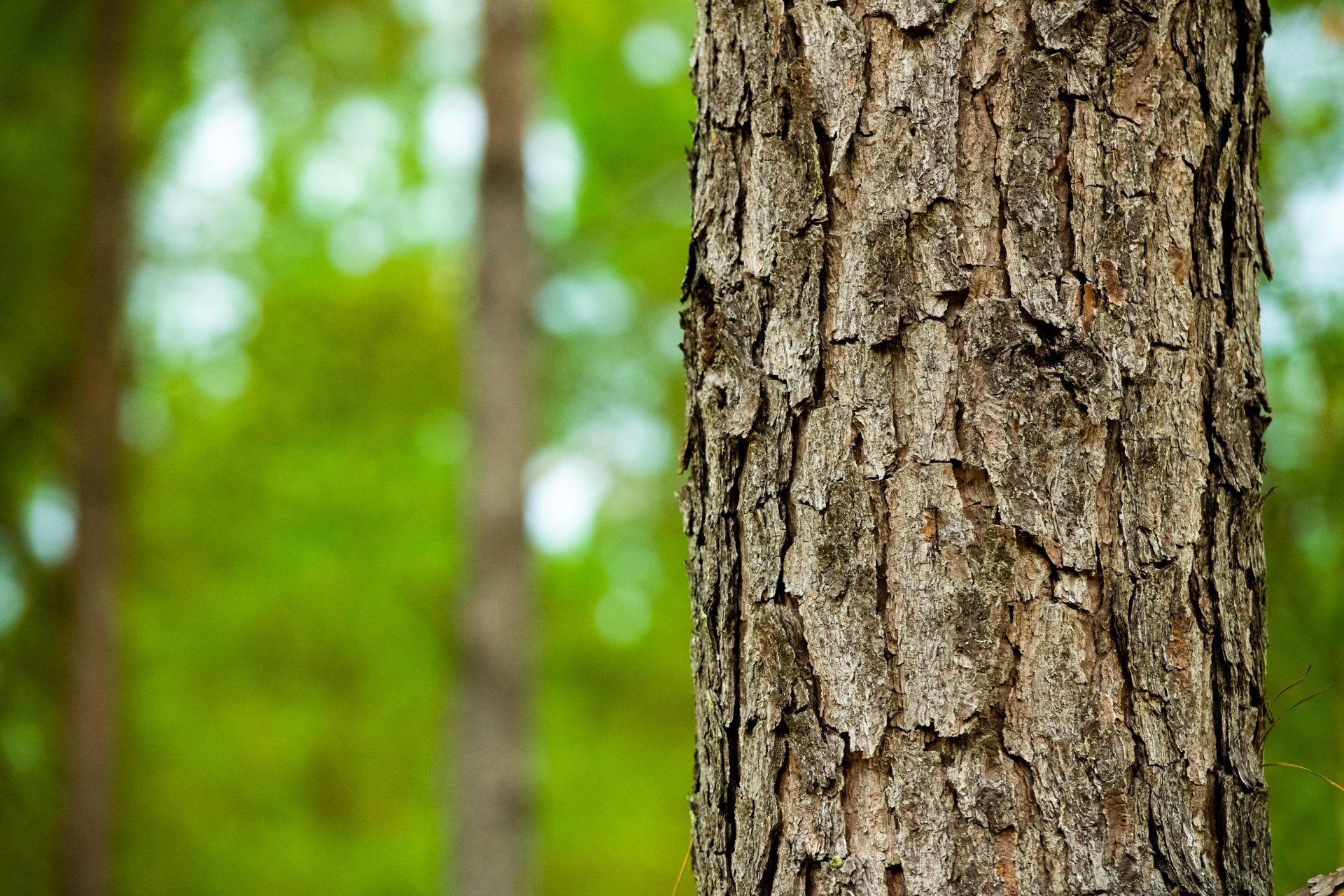
Pine trees in Mississippi working forest
Our forest biomass sustainability commitments
-
We will reduce carbon dioxide emissions
We are committed to ensuring our use of biomass makes a positive contribution to tackling climate change and fulfilling the UK’s net zero by 2050 target.
-
We will protect the natural environment
We recognise our duty to keep forests thriving and to respect the many benefits they bring, including carbon storage, protection of soil and water quality, supporting biodiversity and provision of habitat.
-
We will support people and communities
From state-owned forests to smallholdings, and from the US southeast to the Baltic states, forest owners, forest workers and communities in our sourcing areas are bound by their common reliance on forests for employment, wellbeing and quality of life.
-
We will invest in research, outreach and intervention
The strength of our collaboration with others will improve the sourcing choices we make. We are committed to working with governments, non-governmental organisations, academia and other stakeholders to continually improve biomass sourcing and develop best practice.
![]() Responsible Sourcing: A policy for biomass from sustainable forests is available at www.drax.com/uk/sustainability/responsible-sourcing
Responsible Sourcing: A policy for biomass from sustainable forests is available at www.drax.com/uk/sustainability/responsible-sourcing
Supplier compliance with our policies and appropriate legislation is evidenced by Sustainable Biomass Program (SBP) certification, a certification system for woody biomass, or by our own checks and third-party audits. We require suppliers to progress from our own checks and third-party audits commissioned by Drax, towards SBP certification. In 2020, 99% of the woody biomass we sourced was SBP compliant.
No concerns regarding biomass supplier sustainability compliance were raised or escalated to the Group Ethics and Business Conduct Committee or the Executive Committee in 2020.
Biomass supply chain emissions
Biomass can only be considered a low carbon, renewable energy solution when it can be evidenced that greenhouse gas (GHG) emissions savings are delivered on a lifecycle basis, compared to alternatives such as fossil fuel generation. We therefore collect fuel and energy data for each step in the supply chain, enabling us to calculate lifecycle GHG emissions for our biomass and to demonstrate compliance with our regulatory requirements.
The UK Government has set a limit on biomass supply chain GHG emissions, which must be met by generators to be eligible for support under the Renewables Obligation and Contract for Difference schemes. The current limit is 200 kgCO2e/MWh of electricity. In 2020, our average biomass supply chain GHG emissions amounted to 109 kgCO2e/MWh of electricity.
109 kgCO2e/MWh Drax Power Station average biomass supply chain GHG emissions, 2020
Drax Power Station average biomass supply chain GHG emissions
| Unit | 2020 | 2019 | 2018 | 2017 | 2016 | |
|---|---|---|---|---|---|---|
| Average biomass supply chain GHG emissions | kgCO2 e/MWh | 109* | 124 | 131 | 130 | 122 |
* Limited external assurance by Bureau Veritas using the assurance standard ISAE 3000. For assurance statement see www.drax.com/uk/sustainability.
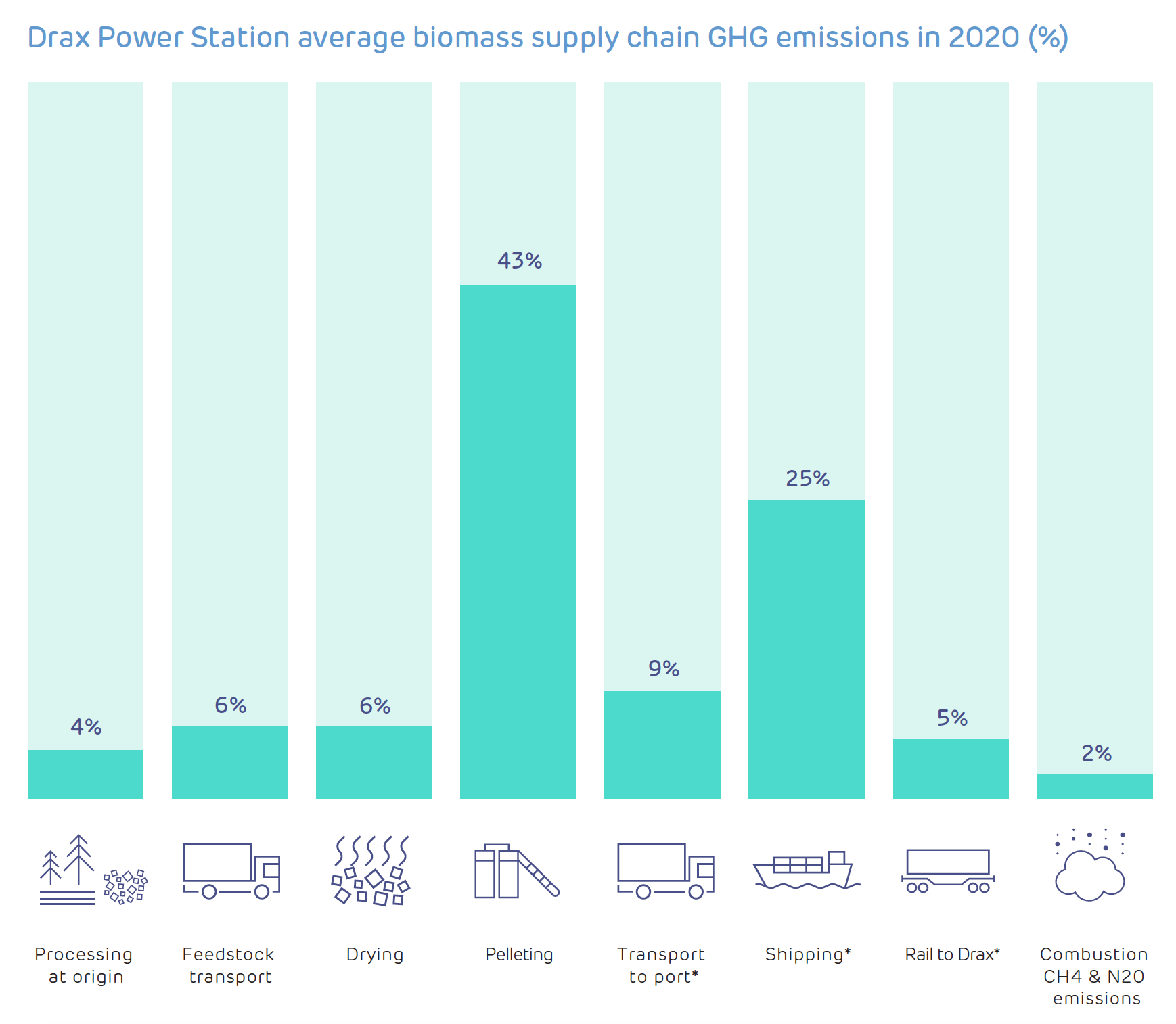
Note: includes the biomass supply chain emissions associated with both Drax’s direct operations (Pellet Production business) and third parties.
* These categories are aggregated in our Biomass Carbon Calculator and the proportion of emissions assigned to transport to port, shipping and rail to Drax has been estimated
In 2020, we launched our Biomass Carbon Calculator, a GHG lifecycle emission tool designed to improve the accuracy and transparency of reporting emissions for wood pellet supply chains. The calculator has been externally verified against UK and EU regulations. It includes all material sources of GHG emissions, including categories absent from other UK reporting tools, such as methane and nitrous oxide emissions arising from fuel combustion.
Drax is committed to taking a leading role in the lifecycle emissions reporting of biomass, and we are providing the calculator for open use to facilitate improved reporting standards across the industry. For more information see www.drax.com/uk/sustainability/the-biomass-carbon-calculator
Biomass sources
Biomass supply chain transparency is a key element of our forest positive approach. In addition to our annual reporting, we provide detailed supply chain information at Drax ForestScope (www.forestscope.info). We respond annually to the CDP Forests questionnaire and achieved a rating of B in 2020. In 2020 our biomass was sourced from established, responsibly managed working forests in the US South, Europe, Canada, Brazil and Russia.
Drax Power Station biomass pellet feedstock sources in 2020
| Country | Sawmill and other wood industry residues (t) | Branches and tops (t) | Thinnings (t) | Low grade roundwood (t) | Arboricultural residues (t) | Agricultural residues (t) | Country total (t) |
|---|---|---|---|---|---|---|---|
| USA | 1,675,929 | 92,934 | 1,117,795 | 1,768,873 | – | 2,4871 | 4,680,402 |
| Canada | 1,021,444 | 99,233 | 1,3163 | 95,267 | – | – | 1,229,107 |
| Latvia | 206,468 | – | 7,922 | 453,621 | – | – | 668,011 |
| Portugal | 1,2830 | 4,672 | 31,530 | 99,015 | 470 | – | 148,516 |
| Brazil | – | – | – | 141274 | – | – | 141,274 |
| Belarus | 10,6734 | – | – | 2223 | – | – | 108,957 |
| Russia | 592 | – | – | – | – | 8,5301 | 85,893 |
| Estonia | 2,9997 | – | 10,203 | 45200 | – | – | 85,399 |
| Lithuania | 6,7161 | – | 1,019 | 14952 | – | – | 83,132 |
| UK | – | – | – | – | – | 70,086 | 70,086 |
| Other European | 1,6357 | – | – | 738 | – | 5,6424 | 73,520 |
| Total | 313,7511 | 196,839 | 118,1631 | 262,1163 | 470 | 236,682 | 7,374,296 |

Catchment Area Analysis
We are committed to sourcing sustainable biomass that contributes to the long-term maintenance of growing forest carbon stock and productivity and that helps to improve the health and quality of forests. In addition to our due diligence processes, we monitor a range of data about the forests from which we source, to determine whether biomass demand is having an impact on regional forest industries. This allows us to make informed sourcing decisions.
We have completed eight Catchment Area Analyses covering Latvia, Estonia, part of central British Columbia, the catchment around three mills in the Chesapeake region in Virginia, seven pellet mills in south east Georgia, and around Drax’s own pellet mills – LaSalle, Morehouse, and Amite. These catchment areas provide around two thirds of Drax’s supplies. The analysis evaluates the trends occurring in the forestry sector around the plant to determine what impact the pellet demand may have had in influencing those trends, positively or negatively. This includes the impact on harvesting levels, carbon stock, growth rate, wood prices, forest management practices and the production of all wood products.
In the geographies examined so far, data collected through our Catchment Area Analyses provides robust evidence that we are meeting our Forest Biomass Sustainability Commitments. For key findings and our Catchment Area Analysis reports, see www.drax.com/uk/sustainability/catchment-area-analyses. Our intention is to complete Catchment Area Analyses for the remaining supply areas within the next two years.
Healthy Forest Landscapes
Drax is jointly pioneering the Healthy Forest Landscapes (HFL) approach with Earthworm Foundation. Earthworm is a non-profit organisation that focuses on responsible sourcing and is experienced in working with companies to develop landscape-scale approaches in commodity supply chains.
HFL aims to provide an evidence-based approach to measure and evaluate the ecological, social and economic impacts in our supply catchment areas.
The HFL approach measures changes in the forest landscape using empirical evidence such as big data from government statistics and input from remote sensing technologies, such as earth observation from satellites. HFL also uses an Earthworm-developed socio-economic evaluation methodology to assess community wellbeing.
The HFL approach assesses four key metrics – forest cover, carbon stock, biodiversity and community wellbeing – which will be used across all our sourcing areas.
Healthy Forest Landscapes metrics
Forest cover
All other forest landscape attributes depend upon forest cover, so particular attention is paid to trends in forest cover change.
Carbon stock
Carbon sequestration and storage in forests is critical to mitigating climate change, and therefore crucial to track. Measurement of forest carbon stock also provides a useful picture of forests’ continuing productivity.
Biodiversity
Landscape scale biodiversity is an important indicator of healthy forest ecosystem functioning, and is of concern to both local and international stakeholders
Community wellbeing
Forests have many impacts on people who live and work within the landscape. This metric addresses social aspects of forest landscape health, prioritising respect for the rights of Indigenous Peoples, and includes socio-economic and community health, encompassing industry workers’ rights.
The HFL approach enables Drax to actively identify opportunities to make positive interventions which support healthy forests, communities, or biodiversity.
In 2020, we trialled several methodologies to assess the strengths and weaknesses of each of the four key metrics. We completed analysis around our own plants at Amite and Morehouse and commenced analysis in the Chesapeake catchment in Virginia.
Over the next four years, we aim to roll out the HFL approach across all our wood source catchment areas. Ultimately, this will allow Drax to track and report our specific and aggregate impact on the four key metrics of forest landscape health in a timely and transparent manner.
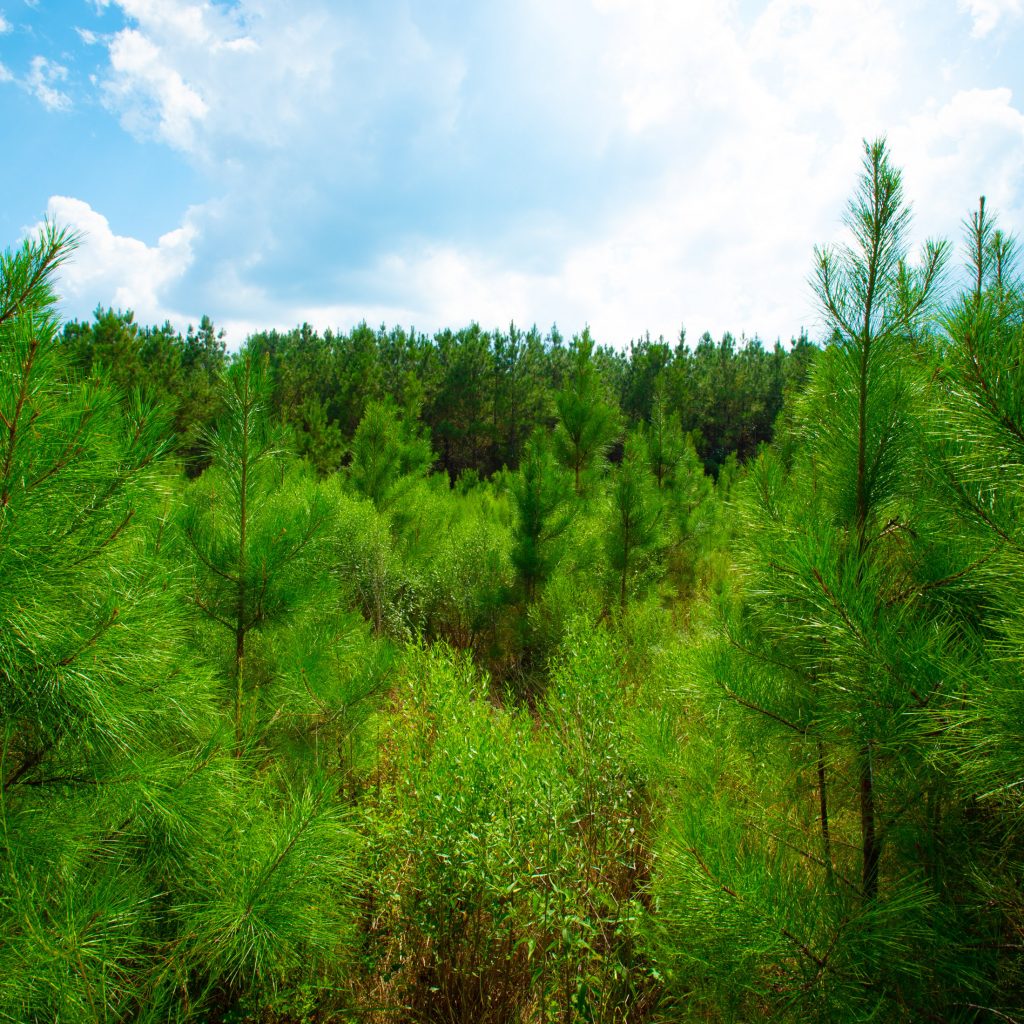
Independent Advisory Board
Our Independent Advisory Board (IAB) of scientists, academics and forestry experts is led by Professor Sir John Beddington, former Chief Scientific Adviser to the UK Government. The IAB provides independent advice on feedstock options, forest science, optimisation of carbon impacts, and the role of biomass in supporting the transition to a net zero energy system. The advice and scrutiny from the IAB means our stakeholders can be assured that Drax will keep our Sustainability and Responsible Sourcing policies under review and that the biomass we use follows the latest scientific research and best practice.
In 2020, the IAB had five meetings and discussed topics including Drax’s carbon negative ambition, the scalability and feasibility of BECCS, and our forest Catchment Area Analyses. The IAB commissioned two independent pieces of work to inform them – a literature review on the impacts of bioenergy on biodiversity, and a literature review on global carbon accounting methodologies, which were discussed during the year. We publish the IAB’s recommendations to Drax on our website.
![]() For more information see www.drax.com/sustainability/independent-advisory-board-on-sustainable-biomass
For more information see www.drax.com/sustainability/independent-advisory-board-on-sustainable-biomass

People positive
Our ambition is to improve skills, education, employability and opportunity for 1 million people by 2025
Positive social impact
The UK’s emerging green economy and businesses like Drax will play an important role in supporting levelling-up and closing regional economic and productivity gaps across the UK.
New skills are required as we look to develop new technologies, including BECCS. It is also important we ensure people local to our operations are equipped with the skills to take advantage of these opportunities. At the heart of this, our Mobilising a Million initiative aims to improve skills, education, employability and opportunity for 1 million people by 2025.
Drax is working with trade unions and businesses in the North to galvanise support for enhanced jobs and skills for the region. Analysis by Vivid Economics estimates tens of thousands of jobs could be created and supported in the Humber if BECCS, as well as hydrogen and other carbon removal technologies, are deployed to decarbonise industry. With UK Government backing, these new jobs could begin to be created as early as 2024.
57 Apprentices started or in continued development at Drax in 2020
117,000 Students engaged in virtual experience of work with Drax and Oak National Academy in 2020
93% Of graduates recruited in 2018 completed the programme in 2020
853 Laptops donated to schools and colleges in 2020, to enable continued learning during Covid-19
![]() See our Covid-19 community response, page 34 of the full report PDF.
See our Covid-19 community response, page 34 of the full report PDF.
* Figure includes cash donations, management cost, in-kind and employee time contributions.
Building the skills of the future
To drive forward our aims, in 2020 we established a five-year partnership with Selby College. We committed £180,000 to deliver community education programmes and retraining, to support people in our communities to develop new skills needed for jobs in the green economy. Our continued partnership with Teach First has enabled the recruitment and training of nine Science, Technology, Engineering and Mathematics (STEM) teachers in 2020, supporting the STEM education of 1,125 students.
Apprentices and graduates
We are a signatory to the UK cross-party Social Mobility Pledge, which is committed to accessing and progressing talent from all backgrounds. During the year, we focused on apprenticeships and use of the Apprenticeship Levy to recruit new talent and develop our colleagues. The number of Degree Apprenticeships undertaken by colleagues has increased, from five Degree Apprenticeships commenced in 2019 to 12 commenced in 2020, with a specific focus on MBAs, Data Science and Finance qualifications.
Of the 15 graduates we recruited in 2018, retention during the programme was 93% and all of those completing the programme in 2020 secured permanent roles at Drax. In 2020, despite the challenges of Covid-19, we continued development programmes for graduates recruited in 2019, and we took on an additional three graduates and seven Year in Industry students.
In 2021, Drax plans to launch a virtual work experience programme, and to create further apprenticeships in a diverse range of career paths, to support the delivery of our business strategy.
Community and charity
We deliver charitable and employee volunteering initiatives in the communities where we operate. In 2020, Drax’s total social contribution was £1 million*, including donations through employee match funding, payroll giving, our community fund, community partnerships and fundraising days.
In February 2020, we donated £25,000 to Snaith Priory to help local recovery efforts, following flooding in villages nearby to Drax Power Station. We donated $30,000 to help families and businesses in the parishes around our pellet mills in Louisiana and Mississippi in the US, impacted by both the Covid-19 crisis and tornadoes. Following Hurricane Laura, we also donated $20,000 to the Food Banks of Northeast and Central Louisiana.
Prior to Covid-19, our power stations at Drax in England and Cruachan in Scotland welcomed students for free educational tours. During the Covid-19 crisis, we have expanded our online offering – creating virtual tours and educational content, delivering webinars to university students, and provided a virtual experience of work in partnership with the Oak National Academy – to ensure students were able to continue learning.
Safety, health and wellbeing
The safety, health and wellbeing of our employees and contractors is a priority for Drax and vital to our continued success.
Safety Management Systems
We have safety management systems (SMS) in place to ensure safe workplaces for all our people. At Drax Power Station, the SMS is certified to OHSAS 18001 and will transfer to ISO 45001 in 2021. Our hydro generation assets, and the gas generation assets subsequently sold in 2021, have an integrated management system covering safety, environment and quality, and the safety component transitioned to ISO 45001 in 2020.
Our Pellet Production sites in the US meet the requirements of OSHA 1910 and the SMS is aligned to OHSAS 18001. We undertook an OSHA-10 and OSHA-30 training programme to strengthen the safety leadership and skills of our US colleagues, achieving 98% completion in 2020. Delivered by registered in-house trainers, the training covers risk identification and incident handling, set in the context of our industry. We have also upgraded our approach to tracking compliance and corrective actions identified from audits or investigations, using one consolidated online tool.
Our Customers and Corporate sites in the UK continue to implement an SMS, with a focus on continuous improvement in our health and safety culture and promoting both physical and mental wellbeing.
Health and safety performance
Each business unit reports monthly on Key Performance Indicators (KPIs), including Total Recordable Incident Rate (TRIR) and Lost Time Incident Rate (LTIR). Business units also report Reporting of Injuries, Diseases and Dangerous Occurrences Regulations (RIDDORs) to regulators in the UK. The Board receives monthly reports as part of the CEO report, which includes information on any incidents and tracks trends. We investigate all injury events, with particular focus on those with high potential, to ensure that root causes are established and lessons are learned and shared across the organisation.
In 2020, our TRIR was 0.29 per 100,000 hours worked (against a target of 0.21) (2019: 0.22 per 100,000 hours worked). This reflects an increase in the number of minor hand injuries, which have a short period of lost time associated. As a result, we have implemented a campaign to improve risk assessment, raise awareness and ensure the right type of personal protective equipment is used. Our LTIR in 2020 was 0.08 per 100,000 hours worked (2019: 0.08 per 100,000 hours worked).
Drax Group health and safety
| 2020 | 2019 | 2018 | |
|---|---|---|---|
| LTIR (1) | 0.08 | 0.08 | 0.09 |
| TRIR (2) | 0.29* | 0.22 | 0.22 |
| RIDDOR (3) | 6 | 5 | 9 |
| Fatalities | 0 | 0 | 0 |
Note: data include both employees and contractors.
(1) LTIR is the total fatalities and lost time injuries per 100,000 hours worked.
(2) TRIR is the total fatalities, lost time injuries and medical treatment injuries per 100,000 hours worked.
(3) RIDDOR is the number of incidents in the UK that were reported to the Health and Safety Executive in compliance with the Reporting of Injuries, Diseases and Dangerous Occurrences Regulations 2013.
* Limited external assurance using the assurance standard ISAE 3000 for 2020 data as indicated. For assurance statement and basis of reporting see www.drax.com/uk/sustainability
A combined approach to health, safety, environment and wellbeing
In 2020, we appointed an HSE Director with Group responsibility to drive HSE improvements via a coordinated strategy across all our businesses. We are establishing plans for 2021 that align all the businesses on our key focus areas to drive improvement in our HSE performance, whilst building upon the 2019 One Safe Drax vision and aligning with our Safe People, Safe Systems & Process, and Safety Assurance approach.
HSE performance is reported monthly to the Board and reviewed regularly by each local management team, and the Group HSE performance is reviewed by the Executive Committee. Incidents and findings are shared across the business via safety bulletins, focusing on preventative action to be taken to mitigate the risk of future occurrences.
The Safety, Health, Environment and Welfare Leadership Executive Committee (SHEWLEC) is chaired by the UK Portfolio Generation Director and meets quarterly to receive reports regarding significant safety, health, environmental and welfare aspects. The Committee establishes standards for relevant health, safety, environmental and welfare issues. It oversees the implementation of relevant policies and principles across the business, reflecting Group philosophy, best practice and regulatory and statutory requirements. It also oversees HSE governance arrangements across the business. We have identified developments for our Group HSE governance for implementation in 2021. This includes changes to the HSE Committee structure within the business, introducing a Group HSE Committee in place of the SHEWLEC.
Key risks and mitigations associated with health, safety, environment, and welfare are routinely reported to the SHEWLEC. The Committee receives a summary of results of internal and external audits, where the scope falls within the remit of the Committee, and receives and considers potential implications for Drax regarding any significant changes in regulation or legislation.
Key issues raised at the SHEWLEC in 2020 include management of emissions and dust at relevant locations, tracking of findings from third-party audits, actions to address changes in legislation (particularly of relevance to our power generation fleet in the UK), and delivery of a Group-wide approach to safety Golden Rules.
In 2020, consultants at the specialist health and safety firm DNV-GL were engaged to provide a risk-based approach to HSE audits, focusing on key processes, organisational risks and continual improvement. A baseline for this Group-wide HSE audit, including benchmarking, will be reported in Q1 2021. Actions arising from the 2019 Internal Audit report undertaken by Turner & Townsend have been tracked to ensure implementation of the recommendations.
Process safety
We recognise that ongoing process safety management is essential for identifying and managing process risk to reduce the likelihood of a major accident. In 2020, we started work to establish the key principles of process safety across the Generation fleet and these will be rolled out Group-wide in 2021. These principles are in line with industry best practice and focused on controls of plant, process and people. A consistent approach to process safety policy and procedures across the Generation business will be delivered in 2021, starting with the gap analysis conducted in 2020. Improvements and standardisation of the management of change process, including delivery of training and awareness sessions amongst the workforce, will be a key deliverable. Process safety key performance indicators are reported monthly to the Executive Committee.
In 2020, all process safety incidents with high potential were fully investigated to establish root causes and enable corrective actions to be focused on preventing reoccurrence. Lessons learned are shared across the Group.
Wellbeing
We continue to build on our holistic wellbeing programme that is overseen by our Wellbeing Steering Committee, which reported to the SHEWLEC. In 2021, we will focus on four key areas: my physical health, my mental health, my social health and my financial health.
In 2020 we focused on resilience, supporting colleagues to adapt in times of challenge and change. We provided leaders and colleagues with training and tools to understand key drivers and techniques to provide support. We partnered with Mental Health First Aid England to provide one-hour live webinars, eLearning and materials for managers, to raise awareness on how to support colleagues with mental health issues. During the summer, the entire leadership team joined a series of online workshop sessions on personal, team and organisational resilience, facilitated by external experts. Interactive personal resilience eLearning was made available to all colleagues. We will continue these programmes and track completion in 2021.
In 2020, we completed coverage for UK colleagues of a single private medical insurance and reward programme. In addition, all colleagues across the Group have access to an Employee Assistance Programme.

People, culture and values
At Drax, our values are driven by our culture, fundamental to which is acting with integrity – and what we call “doing the right thing”. These values are driven by our people and permeate through all levels of the organisation.
In 2020, we asked our colleagues to articulate our culture and values, and what it was that they felt amounted to the Drax experience. They responded with five key themes:
-
We care about what matters
Link to purpose and strategy
We aim to be a sustainable business with profitable growth that has a positive economic, social and environmental impact.
We are committed to enabling a zero carbon future, starting with our direct operations and our ambition to become carbon negative by 2030.
What we did in 2020
The safety and wellbeing of our people and communities is the backbone of what we do – and has been particularly important in our response to the Covid-19 pandemic. We did not furlough any employees and we introduced a new policy to enable flexible working. We launched a new online benefits platform and provided mental health and resilience training, to support colleagues with their wellbeing.
We developed our Management Excellence, apprenticeship and graduate programmes, reflecting our ongoing commitment to training, personal development and supporting career progression.
The Board approved our new Climate policy, employee Code of Conduct and Supplier Code of Conduct (see pages 49 and 61).
-
We are a can-do kind of place
Link to purpose and strategy
We have a diverse, inclusive culture where the continual exchange of ideas and perspectives leads to great things.
The conversion of our coal-fired power plant to biomass and the development of our Electric Vehicles service was due to the ingenuity of our people.
What we did in 2020
In our response to Covid-19, we made fundamental changes in working practices, building new home-working processes at speed, to support our customers, colleague welfare and our communities (see page 34).
Our IT team responded quickly to the new requirements of working from home as a result of Covid-19. This required a new way of supporting colleagues, dispatching laptops configured to the appropriate working requirements, and providing guidance on potential threats to our cyber security, as well as colleagues’ own arrangements for use of online devices, to reduce risk from phishing attacks and fake websites.
Our internal Modern Slavery Working Group brings together colleagues from diverse business functions to deliver a rolling programme of activity.
-
We see things differently
Link to purpose and strategy
We look at the world and see possibilities in how we can help to solve the climate crisis.
We seek new ways of doing things. We repurpose existing assets (such as the coal to biomass conversion), use our expertise and new technologies to innovate (such as BECCS or alternative fuels), and embrace opportunities to learn so we can become even better.
What we did in 2020
We revised our diversity and inclusion strategy and improved colleagues’ experience and exposure to diversity and inclusion in the workplace. For example, we ensured that diversity and inclusion is woven through all our development programmes, and we introduced unconscious bias training to managers. We set up panel interviews for key positions, seeking to make those panels more diverse. We also increased the number of questions on diversity and inclusion in our annual colleague engagement survey and utilised the MyVoice Forum representatives to feed into the action plans arising.
We installed our second BECCS pilot at Drax Power Station and we are working with the Zero Carbon Humber Partnership to enable the decarbonisation of the region.
-
We listen carefully
Link to purpose and strategy
We listen to our colleagues, communities, customers and other stakeholders, working with them to better understand their needs, and deliver the best possible outcomes.
What we did in 2020
We responded to the needs of those stakeholders affected by Covid-19 – offering support to colleagues, care homes, customers and local schools. We continued to run our MyVoice Forums remotely, enabling exchange of information and an additional channel for colleagues to feedback on our Covid-19 response.
We received improved engagement scores (vs 2019) in our latest MyVoice survey results, and changed our approach to survey action planning using a “bottom up” approach.
We extended our Speak Up (whistleblowing) facility to third parties. It is available in multiple languages and promoted in our Supplier Code of Conduct.
-
We do what we say we’ll do
Link to purpose and strategy
We are delivering on our purpose to enable a zero carbon, lower cost energy future, creating robust plans and making the investments necessary to help us achieve our aims.
What we did in 2020
We played a central role in the Coalition for Negative Emissions and are at the forefront of bringing both opportunities and growth to Yorkshire and the Humber, whilst tackling climate change and creating the green jobs of the future.
We are investing £50 million to expand pellet production capacity at our existing US sites, by 350,000 tonnes over the next two years, and the first 100,000 tonnes has now been commissioned.
At Drax, our values are driven by our culture, fundamental to which is acting with integrity – and what we call “doing the right thing”.
“We are proud of our culture at Drax. The Board and I seek to set a positive tone from the top and monitor culture across the Group. Our colleagues from across the business have articulated what they think is the essence of Drax and what we believe sets us apart.”
Phil Cox, CBE Chair
![]() For more information on Board oversight of culture, see Corporate Governance Report, page 87 of the full report PDF.
For more information on Board oversight of culture, see Corporate Governance Report, page 87 of the full report PDF.
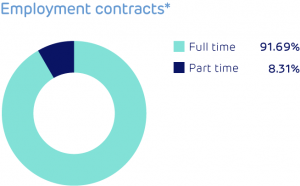
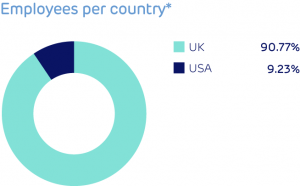
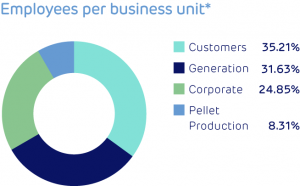
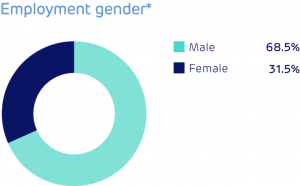
Note: headcount as at 31 December 2020
* Limited external assurance using the assurance standard ISAE 3000 for 2020 data as indicated. For assurance statement and basis of reporting see www.drax.com/uk/sustainability
£285 Average spend per employee on training and development in 2020
(excluding compliance and safety training, Apprentice Levy spend and formal supported academic qualifications)
![]() See Apprentices and Graduates, page 56 of the full report PDF.
See Apprentices and Graduates, page 56 of the full report PDF.
Our people strategy
We work to maintain consistently high standards in our employment practices and all colleagues benefit from policies to support them in the workplace. Our five-year People Strategy focuses on three key areas.
- HR foundations in place that will enable the organisation to be fit for the future – through data, simplified and consistent frameworks and processes, and enabling people to contribute to our values.
- Enabling organisational capability and empowerment – supporting the positive evolution of our culture, alignment of goals throughout the organisation, and talent pipelines.
- Continuous improvement and best in class leadership – a strategic focus, and a more empowered and agile workforce.
The last year has been a year of change for all, and we have seen a significant growth in the culture, focus and passion of our organisation. In our response to the Covid-19 crisis, we demonstrated these changes through our culture and brand values, to shape the way we all work.
Development and training
We invest in the development of our colleagues to help them make the most of their talents, meet their career aspirations and enhance business performance. Our Performance, Potential and Succession processes enable managers to identify colleagues’ development needs and those with the skills and capabilities for succession into critical roles. In 2020, we delivered over 16 hours of training per person, utilising both face-to-face, instructor-led training and online learning.
Our Future Creators programme is designed to support the development, retention and growth of our future leadership pipeline. In 2019, 22 high-potential colleagues attended the programme. In 2020, 41% of these individuals received at least one upward career move and 27% moved into more complex roles, with a 100% retention rate. A further 12 high-potential colleagues have been identified for the next intake. The programme has been deferred to May 2021 due to Covid-19 and each colleague is currently receiving remote personal development planning support.
In September 2020 we launched our Management Excellence programme. The programme is designed to support our line managers with key people skills and was adapted for online delivery to enable continued development despite Covid-19. Since launch we have had over 100 managers on the programme.
Diversity and inclusion
We are committed to a supportive, diverse and inclusive working environment, where you can be yourself and your contribution matters. We aim to support everyone and to design ways of working that are inclusive and flexible, enabling equality of opportunity for all.
Our Diversity and Inclusion Steering Group meets monthly to consider and recommend plans to improve diversity and inclusion across Drax. The Steering Group is chaired and sponsored by the Director of Corporate Affairs and supported by the UK Portfolio Generation Director, both of whom are members of the Executive Committee.
In 2020, we launched a new Diversity and Inclusion policy and plan that will continue to support our ambitions. Our Executive Committee participated in a diversity and inclusion workshop to understand the role of leadership and our leadership team participated in a workshop focused on inclusive leadership. We published a series of colleagues’ personal diversity stories on the intranet, to share the breadth of diversity across Drax.
Our diversity and inclusion strategy has been broadened out beyond gender, focused on building a supportive, diverse and inclusive working environment, where every colleague feels that they belong and can contribute. In 2021, our diversity and inclusion plan will focus on:
- Collating data and using insight to support us in taking meaningful action.
- Educating and inspiring our colleagues on diversity and inclusion.
- Through our actions, making careers at Drax more attractive to talented people from all backgrounds and ensuring a fair and equitable recruitment process.
![]() Further information on diversity is available in the Corporate Governance Report, page 87 of the full report PDF.
Further information on diversity is available in the Corporate Governance Report, page 87 of the full report PDF.
3,022 Total number of Group employees, as at 31 December 2020
82% Employee engagement score in 2020
11% Total employee turnover rate in 2020
Colleague representation and engagement
At Drax, 21% of our workforce is covered by collective bargaining and we have employee representative consultation and information arrangements in place for employees with individual employment contracts.
We communicate with our workforce through channels including our intranet, our quarterly magazine, newsletters, and open forum meetings. During the year, colleagues asked our CEO over 1,300 questions through our online Q&A portal, with the CEO and experts’ responses shared weekly across the Group.
Each business unit has a MyVoice Forum with up to 12 colleague representatives, enabling an exchange of information and views on strategic decisions affecting the way we work. Forum chairs are supported by an Executive sponsor and meet quarterly with our CEO and Chair of the Board of Directors to provide feedback on topics raised by colleagues. In 2020, topics covered included: our annual results, a remuneration update, data protection, our Covid-19 response, future ways of working, wellbeing and recognition. For more information see Focus on Workforce Engagement, Corporate Governance Report, page 92.
We track colleague engagement through our annual survey. In 2020 this was completed by 71% of colleagues, a 6% increase from 2019. Our score for effective engagement of 82% in 2020 is 4% above the Energy and Utilities sector benchmark. We have seen an improvement in nine out of 10 question areas, with wellbeing growing as the key driver for effective engagement. The main theme highlighted for improvement was colleague careers.
Responding to feedback raised in our 2019 survey, we introduced our Management Excellence Programme to equip line managers with key management skills. We improved our communications on change in the business, surveyed colleagues to monitor wellbeing and connectedness in the context of Covid-19 and, as a result, adjusted working arrangements. We also expanded our wellbeing offering and community support activity (see page 34).
Ethics and integrity
At Drax, we are committed to conducting business ethically, with honesty and integrity, and in compliance with all relevant laws and regulations. We do not tolerate any form of bribery, corruption, human rights abuse, or other unethical business conduct.
Our business ethics compliance framework consists of principles, policies, and guidance. The principles are set out in our Drax Code, which identifies the behaviours expected from permanent and non-permanent workers on a broad range of topics. The Drax Code principles form part of our terms of employment and include a series of training videos which can be referenced by colleagues.
Our business ethics policies and guidance documents provide further instruction. These include our Anti-Bribery and Corruption (including conflicts of interest), Human Rights, Fair Competition, Financial Crime, Privacy and Speak Up (whistleblowing) policies and our Gifts and Hospitality, Conflicts of Interest, Due Diligence, Fair Competition, Privacy and Speak Up guides. In 2020, a Group policy project was progressed, to review, update and harmonise policies across Drax, as required, to support the Drax Code.
In 2020, we deployed new annual refresher eLearning across Drax, for data protection and anti-bribery and corruption, for all relevant colleagues. A dedicated business ethics eLearning module was also provided to and completed by all members of the Board and Executive Committee.
Drax Code of Conduct
In September 2020, a new Code of Conduct (Drax Code) was approved by the Board. In October, the Drax Code was deployed as a mandatory read and completed by all permanent and relevant non-permanent workers. We have also built the Code into our new starter induction processes.
The Drax Code expands on those topics previously covered in our “Doing the right thing” handbook, to include other areas such as Health and Safety, Environment, Diversity and Inclusion, Dignity at Work, and Treating Customers Fairly.
Having a Code helps us to aim for and maintain consistently high standards in everything we do. The Code outlines what we expect from all those covered by it and supports the positive development of our culture. The Code also provides our external stakeholders with confidence that we are committed to doing business ethically and that we only wish to work with those who do the same.
Responsibility for ethics and business conduct
Governance of our business ethics framework is overseen by the Drax Ethics and Business Conduct Committee (EBCC), a sub-committee of the Executive Committee. The EBCC comprises senior leaders, meets quarterly, and is chaired by the CFO. A formal report on the work of the EBCC is provided annually to the Audit Committee. Management across Drax is responsible for demonstrating leadership on ethical matters and supporting teams to apply our ethical principles, set out in our Drax Code, and business ethics policies.
Our Business Ethics team manages our business ethics programmes, taking steps to understand our risk profile, developing and maintaining policies and procedures, raising awareness and training, as well as investigating any potential breaches of policy, and supporting our internal and external Speak Up (whistleblowing) channels. Our Internal Audit function provides assurance on the robustness of our business ethics programmes and any recommendations for improvement are duly considered and, as appropriate, implemented.
The Business Ethics team conducts annual risk assessments of each of its programmes, covering anti-bribery and corruption (including conflicts of interest), fair competition, financial crime, privacy, Speak Up (whistleblowing), and supply chain human rights. This is to ensure policies and procedures remain fit for purpose and to recommend any further mitigation measures. Our annual review timetable includes a review of Drax gifts and hospitality records and a colleague business ethics declaration, which was completed by 100% of colleagues in 2021 (covering 2020).
Results of annual reviews, details of investigations conducted, Speak Up (whistleblowing) reports, and audit outcomes are reported regularly to both the EBCC and the Audit Committee. The Board now receives an update on Speak Up (whistleblowing) reports at each meeting.
Working with others
We are a signatory to the UN Global Compact (UNGC) and maintained our representation on their Modern Slavery Working Group in 2020. This enables us to benchmark our compliance programmes and exchange experience with peers, with a particular focus on our response to the UK Modern Slavery Act.
We seek to work with third parties whose standards are consistent with our own. Relevant third parties are subject to our precontract due diligence checks and regular monitoring throughout the term of the contract, via our third-party due diligence system. In cases where a red flag is raised, we follow an EBCC-approved escalation protocol. Depending on the nature of the flagged issue, we may decide not to engage with a new third party, to engage on a conditional basis, to collaborate on remedial action or to end an existing business relationship.
Our Supplier Code of Conduct (Supplier Code) was approved by the Board in October 2020. The Supplier Code sets out the commitments and standards we expect of our third parties and, going forward, will replace the Corporate Responsibility statement used in our contracts. A working group has been formed to agree the implementation plan to deploy the Supplier Code, as appropriate, to our suppliers in 2021.
Anti-bribery and corruption
Our internal processes ensure consistency with our zero-tolerance approach to bribery and corruption. Geographic risk is factored into our third-party due diligence process and system. Conducting business in certain higher risk countries must receive prior approval from the EBCC.
Third parties in higher risk countries receive a higher level of initial due diligence and ongoing monitoring. We also screen the affiliates (directors and shareholders) of third parties identified as potentially higher risk, and refresh their information on a more frequent basis compared to other suppliers. Ongoing monitoring is performed with new information provided to the EBCC, as appropriate.
In 2020, we combined our anti-bribery and corruption and conflicts of interest programmes and strengthened our approach to the reporting of supplier conflicts of interest. We also separated the content of our Corporate Crime policy to form separate Anti-Bribery and Corruption (including conflicts of interest), Human Rights and Financial Crime policies. We developed a Conflicts of Interest Quick Reference guide and provided training to US based managers.
Fair competition
We are committed to conducting our business in accordance with all applicable fair competition law and we do not tolerate any anti-competitive and anti-trust behaviour or activity.
Our dedicated fair competition compliance programme includes a Fair Competition policy and guide and covers both UK competition law and US anti-trust law. We provide eLearning for those that need to know more and targeted learning for our ‘at higher risk’ teams. In 2020, a video on this topic was included in the new Drax Code, which sets out the baseline knowledge that we expect all our people to have with regard to fair competition. In addition, we reviewed our policy and guidance and completed our second annual risk assessment and risk register, which was reviewed by the EBCC.
Data privacy and security
We take seriously the privacy and security of the personal data we control. We are committed to maintaining effective privacy and security programmes to ensure that our people, customers and the third parties with which we engage have confidence in our data handling practices.
Our maturing privacy programme is managed by the Data Protection team and overseen by the EBCC. It is implemented through policies, guides, privacy notices, third party due diligence questionnaires and contractual terms. During 2020 we issued eLearning training to UK colleagues and invested in privacy designed compliance software to support our work in areas such as individual rights requests and personal data breaches. Internal Audit completed a positive audit of our privacy programme in 2020. Our privacy programme supported our Covid-19 response, with particular reference to handling additional health data, temperature checks and home working guidance. We benchmarked ourselves against the new accountability tracker published by the Information Commissioner’s Office and have incorporated relevant aspects into our work plans for 2021.
Our security framework matured through 2020, embedding security risk management controls into our business change activities, improving cyber technical capabilities and expanding security controls and architecture into our operational technology systems through our NIS Directive compliance programme. We mobilised quickly in response to Covid-19 to provide secure working from home solutions with minimal impact on our control environment or risk profile. An independent maturity review was undertaken against a security best practice framework in 2020, which noted that Drax has a “well-structured and capable security function that has matured significantly” since establishment.
We maintain a risk-based security controls framework aligned to industry standards, to protect our business, colleague and customer data and meet our regulatory requirements. In addition to traditional IT security measures, we use cyber technologies to detect, respond to and resolve cyber threats and attacks. We are conscious that such threats continue to change and our security programme seeks to evolve our controls and response to cyber threats.
Labour and human rights
Our commitment to the protection of human rights includes not tolerating the use of underage workers or forced labour. This is set out in our Human Rights policy, Drax Code and Supplier Code.
Our Supplier Code outlines the standard of ethical business conduct we expect from our suppliers. Businesses in our supply chain should offer a safe workplace for their employees that is free from harm, intimidation, harassment and fear. The Supplier Code emphasises our requirement for our suppliers to challenge unethical behaviour and promote a “speak up” culture and provides the details of our available Speak Up channels for their use in multiple languages.
Policies are available at www.drax.com/uk/about-us/compliance-and-policies
Supply chain human rights (modern slavery)
Our Modern Slavery Working Group, chaired by a member of the Business Ethics team, oversees a three-year rolling programme, and reports quarterly to the EBCC.
In 2020, we published our fourth Board-approved Modern Slavery Statement in accordance with the UK Modern Slavery Act (www.drax.com/uk/modern-slavery-act/). It describes the steps we are taking to reduce the risk of modern slavery in our supply chain. We responded to the UK Government’s consultation on Transparency in Supply Chains and are positioned to meet the new requirements.
We keep our programme and statement under review to ensure it reflects our activities, global presence and wider evolving practice.
Speak Up (whistleblowing)
As part of our commitment to transparency, openness and continuous improvement, we actively encourage those working for or on behalf of Drax to raise genuine concerns about practices which could breach laws, regulations or our own ethical standards. Drax has a zero tolerance of retaliation and we have processes in place to apply appropriate consequences, should an individual victimise or retaliate in any way against someone who has raised a genuine concern. During 2020, we issued specific guidance on treating concerns respectfully.
In 2020, we launched our new Speak Up (whistleblowing) programme (see Corporate Governance Report, page 87). During the year, nine concerns were reported across both our internal and external channels. This is an increase from eight reports in the previous year and reflects our continued efforts to promote an open and approachable culture of “speaking up” across Drax.
Non-financial information statement
We have summarised our policies and disclosures in relation to non-financial matters, in line with the Non-Financial Reporting (NFR) requirements of the Companies Act 2006. This report forms our UN Global Compact (UNGC) Communication on Progress and we have mapped the NFR requirements to the four issue areas of the Ten Principles of the UNGC.
Except where indicated as an internal policy, all policies and codes are available on our website using the address at the top of the page.
| UN Global Compact | Non-Financial Reporting requirement | Policies, due diligence processes and outcomes | Page reference |
|---|---|---|---|
| Environment | Environmental matters | Group Environmental policy statement | |
| Sustainability policy | Page 53 | ||
| Responsible Sourcing policy | Page 53 | ||
| Carbon emissions | Page 49 | ||
| Environmental impact | Page 51 | ||
| Sourcing sustainable biomass | Page 53 | ||
| Labour | Employees | Code of Conduct | Page 61 |
| Supplier Code of Conduct | Page 62 | ||
| Group Health and Safety policy statement | |||
| Human Rights policy (internal policy) | |||
| Gender Pay Reporting | |||
| Safety, health and wellbeing | Page 57 | ||
| People, culture and values | Page 59 | ||
| Social matters | Community and Charity policy (internal policy) | ||
| Positive social impact | Page 56 | ||
| Human rights | Respect for human rights | Supplier Code of Conduct | |
| Human Rights policy (internal policy) | |||
| Modern Slavery Act statement | Page 63 | ||
| Ethics and integrity | Page 61 | ||
| Anti-corruption | Anti-corruption and anti bribery matters | Code of Conduct | |
| Anti-bribery and Corruption policy (internal policy) | |||
| Ethics and integrity | Page 61 | ||
| A description of the Company’s business model | Business model | Page 04 | |
| A description of the principal risks | Principal risks and uncertainties | Page 66 | |
| A description of the non financial key | Key performance indicators | Page 18 | |
| performance indicators | Remuneration committee report | Page 108 |
Chapter 9:
Viability statement & principal risks and uncertainties
In accordance with the UK Corporate Governance Code 2018, the Directors have assessed the prospects of the Group over a period significantly longer than the 12 months required by the going concern provision.
The assessment of viability was led by the CEO and CFO in conjunction with divisional and functional management teams and presented to the Board as part of the annual planning process. In reviewing this assessment, the Board has considered the principal risks faced by the Group, relevant financial forecasts and sensitivities, the availability of adequate funding and the strength of the Group’s control environment.
Assessment period
The Board conducted this assessment over a period of three years (2019: three years), selected for the following reasons:
- The Group’s Business Plan (the Plan) which is prepared annually, updated three times during the year and also used for strategic decision-making, includes a range of financial forecasts and associated sensitivity analysis. This Plan covers a three-year period in detail, before extending into the medium term.
- Within the three-year period, liquid commodity market curves and established contract positions are used in the forecasts. Liquid curves typically cover a one to two-year window and contracts cover periods between one and ten years. In particular, the Group benefits from the stable and material earnings stream available from the CfD until 2027. Selecting a three-year period balances short-term market liquidity against longer-term contractual positions.
- There is limited certainty around the Group’s markets and regulatory regimes. However, in selecting a three-year period the Board has assumed no material changes to the medium-term regulatory environment and associated support regimes beyond those already announced at the date of this report.
The business considers longer term forecasts for other purposes, including value in use analyses and estimates of useful economic lives in respect of its businesses and fixed assets, as set out in the notes to the financial statements.
Review of principal risks
The Group’s principal risks and uncertainties, set out in detail on pages 66 to 77, have been considered over the period.
The principal risks with the potential to exert significant influence on viability are: commodity price changes, political and regulatory changes, and plant operating failures. A significant adverse change to the status of each risk has the potential to place material financial stress on the Group.
The risks were evaluated, where possible, to assess the potential impact of each on the viability of the Group, should that risk arise in its unmitigated form. The potential inputs were included, where appropriate, as sensitivities to the Plan and considered by the Board as part of the approval process, in January 2021, before the Plan was adopted by the Group. In addition, reasonable scenarios that included a combination of unforeseen plant outages, increases in commodity prices and reductions in subsidy income were also considered. The outcomes of this analysis, which did not reflect the potential benefit of available mitigating actions, indicated that the Group would be able to absorb the impact of such scenarios without significant impact upon its ability to meet liabilities as they fall due.
As part of its review of principal risks and uncertainties, the Group considered emerging risks related to Covid-19, the end of the Brexit transition period and climate change. This review concluded that such matters remained low risk to the Group from a viability perspective. The Board’s response to Covid-19 during 2020 is described in further detail on page 88.
The Group has a proven track record of rapidly adapting to changes to its environment and deploying innovative solutions to protect its financial performance. Previous adverse events have arisen and provided challenges which tested the ability of the Group to deliver on its targets but, on each occasion, it has been able to respond positively and manage the impact. This provides the Board with further confidence that risks can be sufficiently mitigated, and viability can be maintained during the assessment period.
Review of financial forecasts
The Plan considers the Group’s financial position, performance, cash flows, credit metrics and other key financial ratios and was most recently updated to reflect current market and external environment conditions in December 2020, including assumptions related to the ongoing impact of Covid-19. It is built by business and segment and includes growth assumptions appropriate to the markets each business serves.
The Plan includes certain assumptions, the most material of which relate to commodity market price curves and levels of subsidy support available to the Group through the generation of biomass-fuelled renewable power. It is underpinned by the stable revenues available through the generation of CfD-backed electricity and contracted sales from the Customers business.
The Plan is subject to stress testing, which involves the construction of reasonably foreseeable scenarios, including those aligned to the principal risks (described above) which test the robustness of the Plan when key variables are flexed both individually and in unison. Where such a scenario suggests a risk to viability, the availability and quantum of mitigating actions is considered.
As part of stress-testing the Plan, a “reasonable worst case” scenario was also constructed and assessed. Rather than a single event, the Board considers the most significant scenario that could reasonably arise in the assessment period, and materially impact viability, to be an aggregation of multiple incidents either in a short timeframe or repeatedly during the period. For the purpose of creating the scenario, the severity of these incidents (for example, the duration of an unexpected outage) was based on experience of actual historical events or reasonably foreseeable future downside scenarios.
The reasonable worst case considered the impact on earnings, cash flow and net leverage as a result of a series of incidents including unexpected generation outages, pellet production outages, a reasonable reduction in Customers gross margin, increases in commodity prices and a loss of ROC income during the period. Whilst the outcomes from this scenario were severe, they indicated that the Group would continue to operate within the restrictions of its financing arrangements and would have sufficient cash to meet its liabilities as they fall due once likely mitigating actions were taken into account. Such mitigating actions included potentially reducing levels of capital expenditure and dividend payments if required. The impact would also be partially mitigated through the earnings stability provided by the CfD, the Group’s proven ability to trade effectively in volatile markets, use of existing committed and undrawn facilities and reductions in other discretionary expenditure. Based on its review, the Board is satisfied the viability of the Group would be preserved in a range of scenarios, with various mitigating actions available, sufficient to manage the risk, including significant deterioration of commodity market prices.
Availability of adequate funding
The sources of funding available to the Group are set out in note 4.3 to the financial statements (page 184). The Board expects these sources, along with stable cash flows generated by the Group from its normal operations, to provide adequate levels of funding to support the execution of the Group’s Plan.
During 2020, the Group issued €250 million of loan notes and entered into a new infrastructure term loan facilities agreement with committed funds in both Sterling (£45.0 million) and Euro (€126.5 million), with an option to increase by up to a further £75.0 million. At the year end, the loan notes were drawn in full and a further €31.5 million and £53.0 million drawn under the infrastructure facilities. The proceeds of these issuances were, along with existing cash flows, used to redeem the Group’s £350 million 2022 sterling bond and the £125 million ESG term loan facility.
These arrangements both extended the maturity profile of the Group’s debt and reduced the overall cost of debt, further strengthening the balance sheet. No significant repayments of debt fall due within the assessment period.
In addition, the Group completed the refinancing of its revolving credit facility. The new £300 million facility matures in 2025 with an option to extend by one year. This replaces the previous RCF, which was due to mature in 2021, and provides increased liquidity with the full facility now able to be drawn as cash (the previous facility restricted cash drawn to support liquidity to £165 million).
At 31 December 2020 the Group had total cash and committed facilities of £682 million. The Plan demonstrates that the Group expects to operate within its current committed facilities for the duration of the three-year viability period.
The Board is confident that the Group has access to a range of options to maintain a diverse and well-balanced capital structure.
Expectations
The Directors have considered a range of factors in their assessment of viability over the next three years, including the latest Plan, scenario analysis, levels of funding, the control environment and the principal risks and uncertainties facing the Group. The Directors have also considered the availability of actions within their control in the event of plausible negative scenarios occurring. Based on this, the Directors have a reasonable expectation that the Group will be able to continue in operation and meet its liabilities as they fall due over the three-year period of their assessment.
Principal risks and uncertainties
The effective management of risk supports the delivery of our strategy
Identifying, assessing and managing risks across the Group is an integral part of the delivery of our strategy. We manage the commercial and operational risks faced by the Group in accordance with policies and processes approved by the Board.
The Board is responsible for determining risk appetite and ensuring the effectiveness of risk management and internal controls across the Group. The Group has a comprehensive system of governance controls to manage all key risks.
Group approach to risk management
The risk appetite is the level of risk that the Group is prepared to tolerate, and which might arise in the day-to-day conduct of our business and seeking to realise our strategic objectives. Risk appetite can vary depending on the nature of the risk and expected returns. Risk appetite also informs the expected behaviours from our employees, contractors and business partners, and the investment required to support risk management activities. We consider a range of risk categories including environment, people, health and safety, political and regulatory, strategic, operational, financial, and climate change. The Board determines the risk appetite of the Group and seeks to ensure that emerging and existing risks are identified and managed to increase the likelihood that the Group’s business objectives will be achieved. The Group has a Risk Management Policy, approved by the Board, which defines its approach to risk management. The key elements of the policy are to:
- Identify risks that have the potential to threaten the achievement of our strategic objectives and assess the likelihood of the risk occurring using a risk scoringmethodology which ensures a consistent approach when assessing all risks.
- Consider the possible impact to the business in the event of any risks arising and put in place appropriate mitigating controls intended to manage identified risks to an acceptable level.
- Assign responsibility and define accountabilities for the identification, assessment and management of risk and provide resources to enable appropriate measures to be taken.
- Provide a framework to enable the escalation and reporting on potential and emerging risks and the effectiveness of the mitigations and controls to support management decision making.
- Regularly monitor changes in the internal and external environment of our business, review the Group’s principal risks against such changes to ensure our analysis remains accurate and relevant and review the effectiveness of mitigation strategies and the application of the risk framework employed.
The risk management approach manages, rather than eliminates, the risk of failure to achieve strategic and business objectives, and provides reasonable, but not absolute, assurance against material misstatement or loss.
Risk management governance
The risk management governance structure includes the Executive Committee (from which are identified the owners accountable for each principal risk) and our risk management committees whose shared responsibilities include:
- Ensuring that risks including new, potential and emerging risks are identified, assessed and managed effectively within defined risk appetites and limits.
- Ensuring that risks associated with the Group’s principal risk categories are identified, analysed and managed appropriately.
- Ensuring that changes in the internal business and external macro environment that affect the principal risks are kept under review and responded to appropriately.
- Driving completion of the actions required to reduce risk exposure and improve risk mitigation.
- Driving an appropriate risk management culture that promotes and creates balanced risk-taking behaviour and clear accountability.
- Demonstrating robust governance of risk management by reviewing and challenging risk management across the Group.
In line with good governance the risk management committees undertake regular reviews of business unit and financial risks and receive reports from business units and risk owners reflecting their specialist areas and technical knowledge. The Executive Committee also undertake deep dive reviews of all the principal risks through the course of the year and receive reports from the risk management committees and principal risk owners.
In addition, the Audit Committee and Board review the suitability and effectiveness of risk management processes and controls on behalf of the Board and receive updates from management at each meeting. The Board also receives updates on the risk management framework.
Internal control
The Group has a well-defined internal control system supported by policies and procedures, documented levels of authority which support decision-making and accountability for management across the Group.
The Board has adopted a schedule of matters which are required to be brought to it for a decision, below which authority is delegated through the Executive Committee to a combination of sub-committees and management enabling them to make decisions on behalf of the Group and its businesses on a day-to-day basis. The most recent review of the schedule of matters by the Board was in December 2020. The internal control system is designed to ensure that the directors and executive maintain effective oversight and direction for all material strategic, operational, financial and organisational issues.
Under authority delegated by the Board, the Audit Committee, approves and implements a programme of internal audits covering various aspects of the Group’s activities for the next financial year. The programme evolves based on an assessment of the key risks of the Group, the existing assurance and controls in place to manage the risks, the core financial control framework and observations arising from management’s review, discussion and challenge by the Audit Committee including responses to findings from the observations arising from the work of the Internal Audit function and support of other specialist advisers. The programme is reviewed quarterly and refreshed to reflect developments within the Group as well as changes in wider practices, informed by the experience of internal and external personnel.
During 2020 internal audits were performed either by team members of the Group’s internal audit function or with effect from July 2020 by KPMG who was formerly the Group’s co-source internal audit function provider. The internal audit function reports to the CFO and the appointment of KPMG was considered and approved by the Audit Committee. The findings and recommendations from each internal audit are documented in a report for internal distribution and action. A full copy of the report is distributed to the Executive Committee and the Audit Committee. Each report includes the status of management responses to the findings and recommendations and details of the actions that management propose to take. Each meeting of the Executive Committee considers the status of closing recommended actions. In addition, the Audit Committee receives a full internal audit and quarterly internal controls update report at each meeting.
Based on the assessments undertaken by each of the Executive Committee and the Audit Committee during 2020 and considered at the meeting of the Board held in finalising the Annual report and accounts, the Board determined that it was not aware of any significant deficiency or material weakness in the system of internal control. For further information on the work of the Audit Committee see page 98.
Overall risk assessment
The Board has assessed the principal risk categories including assessing continued emerging risks arising from the unexpected events of the Covid-19 pandemic and the ongoing uncertainty experienced during the year concerned with Brexit. As an immediate response to the pandemic, the Group deployed its disaster recovery arrangements which facilitated assessment of the potential impact and subsequent monitoring of mitigation measures. As the appreciation of key issues and challenges matured, the initial crisis threat was de-escalated, and actions were monitored through established teams.
Throughout the year particular attention was given to ensure the Group remained as materially unaffected by possible Brexit outcomes including a no deal exit from the EU. Any additional change in managing these and other new and emerging risks has not materially affected the categorisation of the Group’s principal risks. Therefore the nine principal risk categories disclosed on pages 69 to 77 remain unchanged from 2019, when climate change was added as a principal risk reflecting the increasing medium to longer term focus on such risks, and their importance to the Group’s strategy and the nature of the Group’s sector and operations.
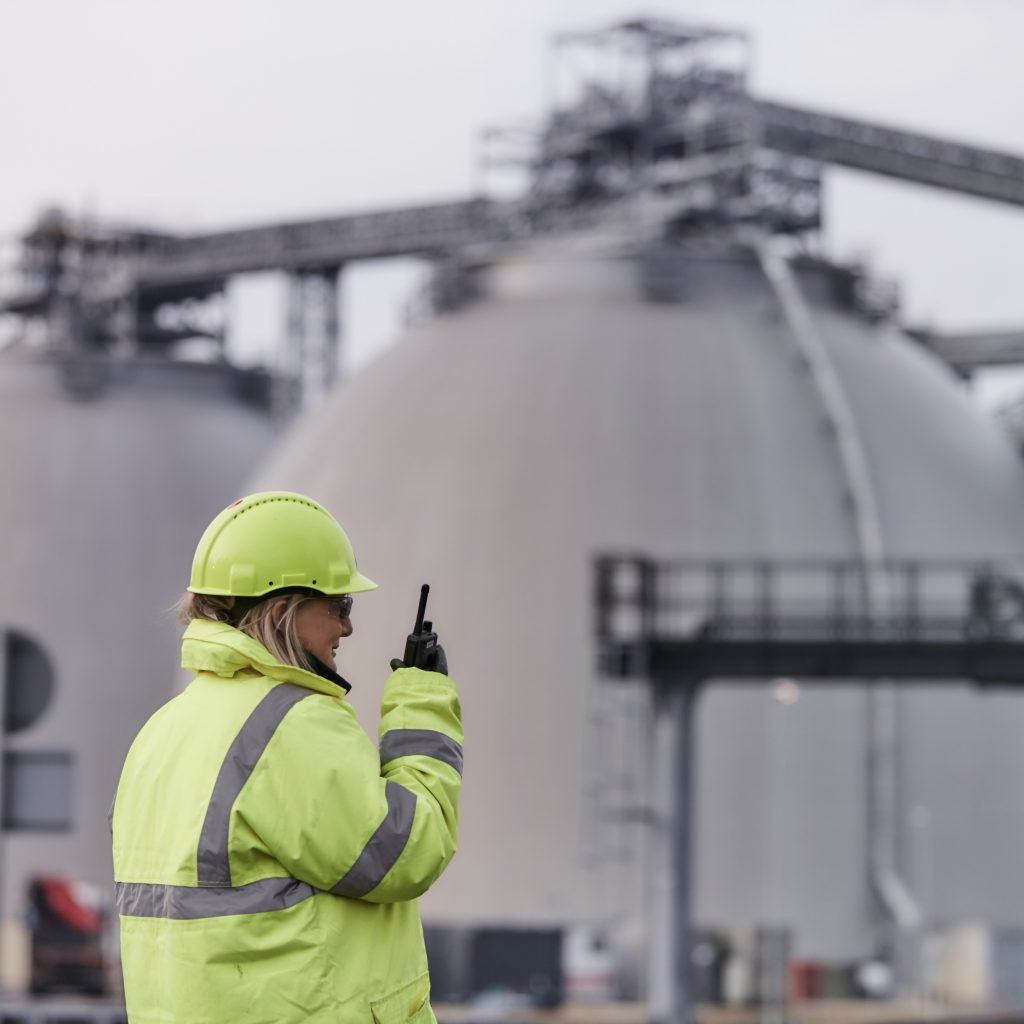
Risk impact of Covid-19
The ongoing Covid-19 pandemic has had and is expected to continue to have an impact on the global economy, our customers, suppliers and the health, safety and wellbeing of our employees and contractors. The Group prioritises health, safety and wellbeing and has put in place a number of actions and additional measures to safeguard all those who are still required to attend the Group’s operational sites. This includes the Group ensuring it remains cognisant of any continual changing guidelines issued by the UK Government and US authorities. All of the actions implemented enabled the Group to meet its obligations as part of the UK’s critical national infrastructure, generating power and supporting the UK’s energy market and our business customers while protecting our employees.
The Group has an incident crisis management process enabling timely response to events when they occur which comprises of strategic (led by the Executive Committee), in addition to tactical and operational level teams (led by management). In response to Covid-19 these teams developed and implemented additional policies and procedures around health, safety, IT systems, remote working practices, wellbeing communications and engagement. In response to the continual changing environment created by the pandemic constant monitoring of these plans and their effectiveness is being undertaken.
Since the start of the pandemic and as it has evolved, the Board has received regular reports from management and supported critical decisions connected with the Group’s response to the events and activities as outlined above. This has included for example, how the Group has adjusted its working practices across all of its operation sites, its communication strategy with and on safeguarding its employees, implementing new IT infrastructure to support changes in working practices away from offices, and being able to continue to accurately track its financial and non-financial business performance. The Board also received reports on how Covid-19 might impact risks in the medium to longer term enabling them to reassess the future impact on all of the Group’s principal risks. Further details on how the Group responded to the pandemic is detailed in the section “Our Covid-19 response’” on pages 34 and 35.
The impact of Covid-19 on each principal risk and the mitigating actions adopted in response to the risk are detailed on pages 69 to 77 and the changes arising from Covid-19 are denoted by the Covid-19 symbol.
The Group has kept under review its financial forecasts and its best estimates of the financial impact of the associated risks which were initially disclosed in the trading update issued in April 2020 and thereafter in the Half Year results. The initial analysis has remained broadly unchanged in terms of the impact on the Group for the 2020 financial year and is fully reflected in its viability statement (see page 64). Additional information on the commercial and financial impact for the Group of Covid-19 during the 2020 financial year can be found on pages 20 to 27.
The Board recognise that going forward the effects of the Covid-19 pandemic continues to carry inherent uncertainties and future impacts may well continue to evolve even when events have returned to relative normality. These impacts could lead to further change in UK Government policy, macroeconomic policy and the behaviours of people and markets that may impact some of the Group’s risks. The Board continues to have regular engagement with management on the Group’s response to any of these risks in order to assess, monitor and promptly respond to any evolving impact of Covid-19 on our operations and business, including impacts for all our stakeholders.
Risk impact of Brexit
Throughout 2020 the Group continued to monitor and prepare for the UK’s customs exit from the EU including managing for a no deal Brexit. An internal working group consisting of relevant management chaired by a member of the Executive Committee, regularly reviewed developments in negotiations and possible effects on the Group’s activities. This included updating the Executive Committee and Board on Brexit risks and initiatives to mitigate the impact from a range of possible negotiation outcomes that continually changed during the transition period while operating under the withdrawal agreement until the 24 December 2020 when the UK/European Union Free Trade Agreement (FTA) was officially announced. Throughout the EU exit process, Drax held Chairmanship of the Energy UK trade association Brexit Working Group which undertook regular meetings attended by various UK Government organisations. Post the transition period management directly, and through its association with Energy UK have continued to monitor closely the release and interpretation of further details relating to the FTA in order that we can look to clarify fully the potential impacts on our trading operations, supply chain and regulatory requirements. The Group’s ongoing focus will be to ensure that our business mitigates any adverse effects to its operations from the FTA and it has put in place a number of actions and measures to manage risks it identified around a number of key areas. These included:
- Considering the Finance and Commodity Trading risks from potential restrictions in access to financial, carbon, renewable energy Guarantee of Origin certificates, (GoOs) and commodity markets. The Group developed contingency plans to respond to the revised approach to carbon trading post 1 January 2021 to allow it to effectively meet the Group’s regulatory requirements relating to carbon. There were also preparations to ensure the Group’s ability to secure and continue to trade renewable energy GoOs, as well as operations to manage its other financial and commodity exposures, such as FX, effectively from 1 January 2021. The Group is adapting to the post FTA environment, particularly with close monitoring of the detailed implementation of UK Allowances, including possible linkage to the EU Emissions Trading Scheme (ETS).
- Considering the people risks from potential constraints in free movement of people and access to talent. Further consideration and planning have been placed on Group-wide recruitment and retention, talent management and succession planning.
- Considering the risks from potential import constraints and tariffs on the Group’s fuel and critical commodity supply. An operational review considered alternative port arrangements, a review of goods at risk of shortage and planning for key plant operations supplies. This included engaging with supply chain partners to ensure their Brexit readiness and managing for increased supply lead times. Other potential import risks associated with UK Government policy arose as a result of Covid-19, where the need to give priority to the importing of other products such as medicines and the closing of French ports to UK import and export freight, increased the potential to add further congestion and delays to the import of critical spares and commodities.
- Considering potential changes to regulation and policy and the risks from loss of engagement with European-based stakeholders to discuss emerging policy and understand potential divergence of compliance requirements and/or market rules. The Group continues to promote the benefits of biomass and is engaged with government, regulators, and other interest groups, both in the UK and internationally. This is to ensure our views and positions on current and forthcoming legislation, regulations, energy and environmental policy issues, that may have implications for our business, are represented and that we are able to listen to and consider the views of others in helping to reach consensus on the future for biomass.
Generally, the overall financial and non-financial risk impact to the Group of Brexit to date has been minimal. However, the above key risk areas still remain a focus of the Group. While the UK Government continues to develop plans to manage the longer-term economic effects of Covid-19 there is additionally future uncertainty about any additional economic effects which may result from the implementation of the FTA on our customers, suppliers and other stakeholders. For these reasons, the Group will continue to monitor any potential change to Brexit risks during 2021 as the full interpretation and implementation of the FTA takes place and where necessary expects to update its mitigating actions to minimise any effects on business operations.
Principal risk categories
The Group has identified nine principal risk categories that it considers having material operational impact and probability to its business. These and other key risks are considered within an established programme by which management, executive and the Board consider how risk and our ability to respond to risks evolves. Set out below are the principal risks reflecting that assessment:
- Environment, Health and Safety
- Political and Regulatory
- Strategic
- Biomass Acceptability
- Plant Operations
- Trading and Commodity
- Information Systems and Security
- Climate Change
- People
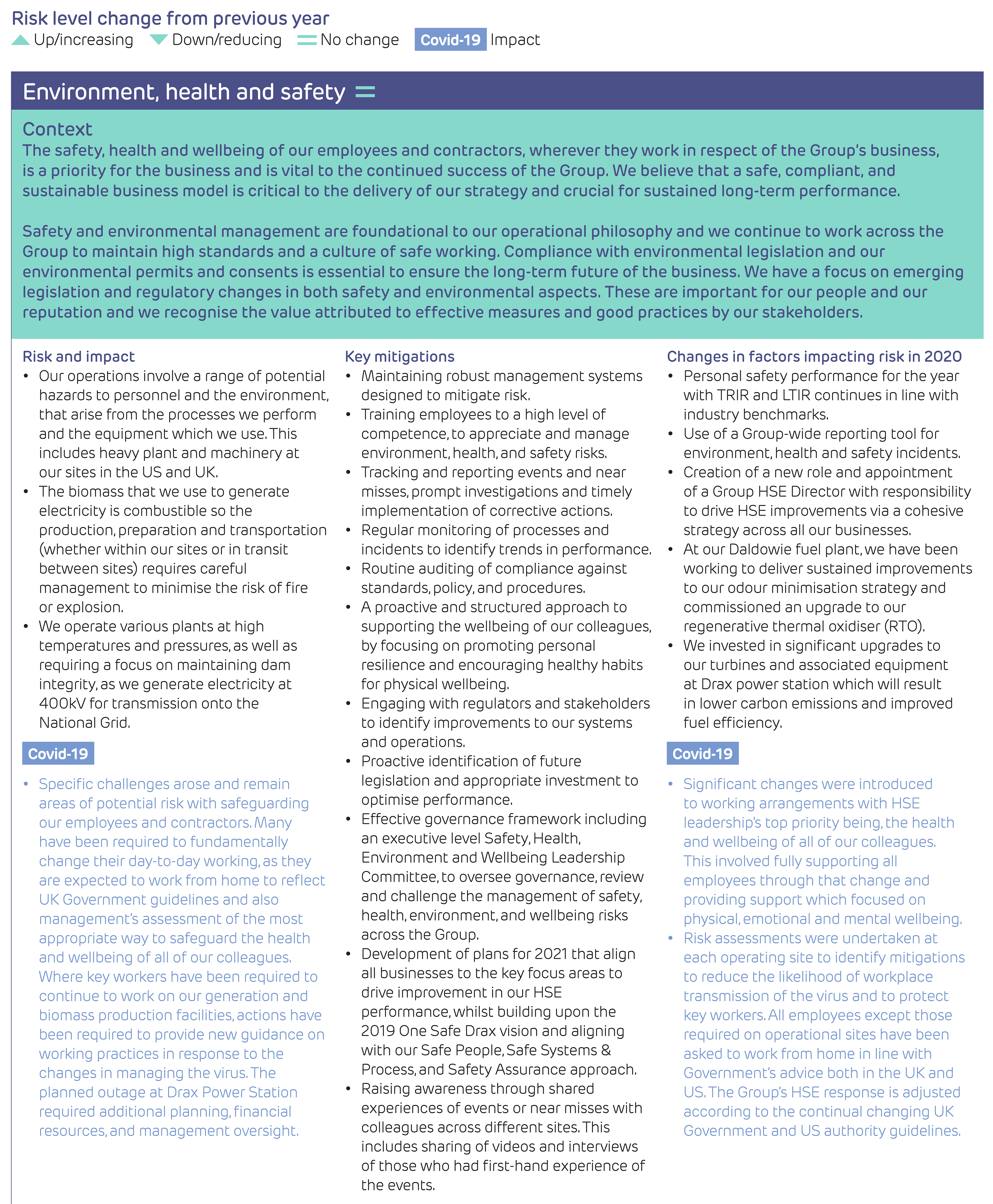
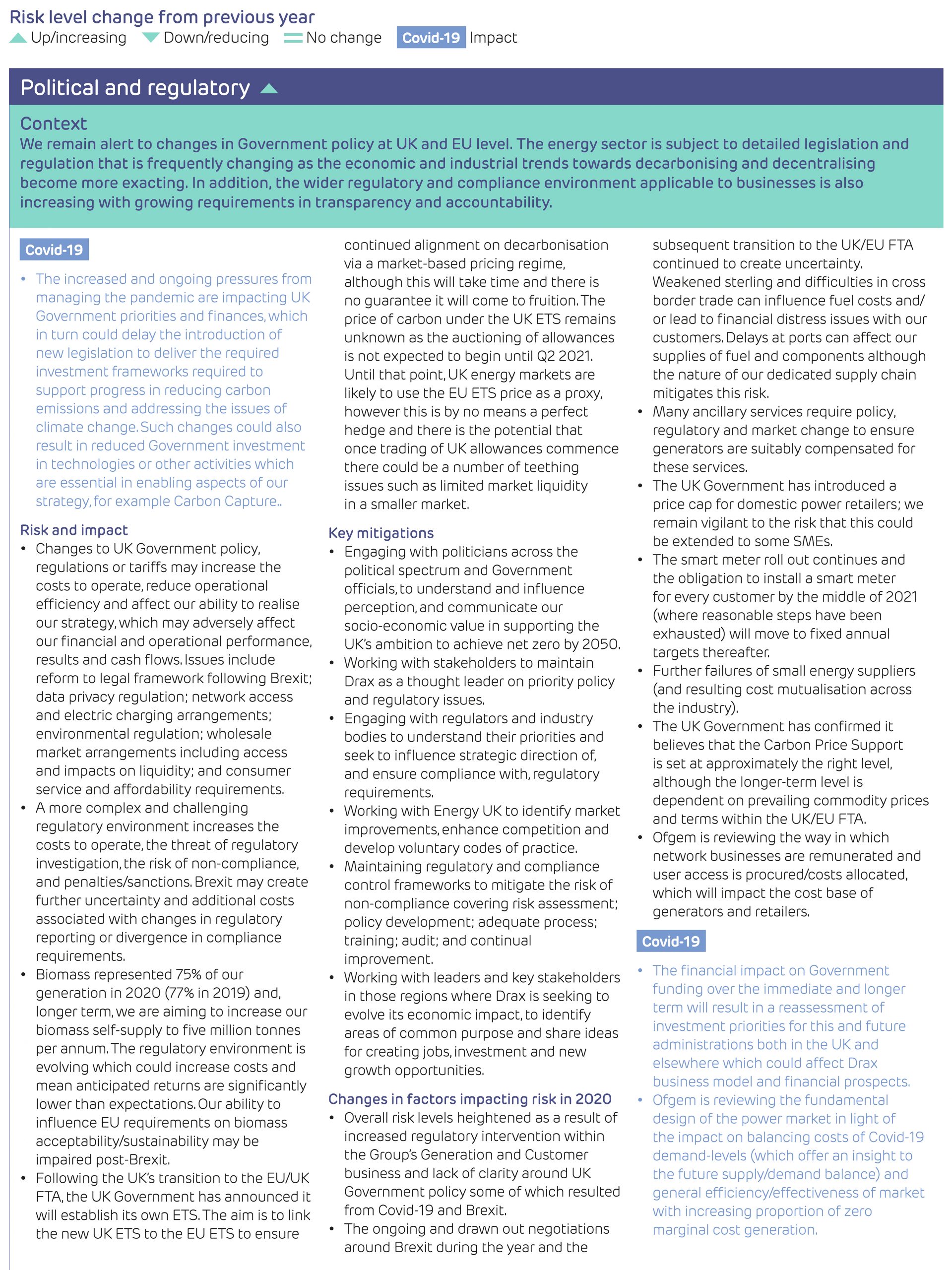
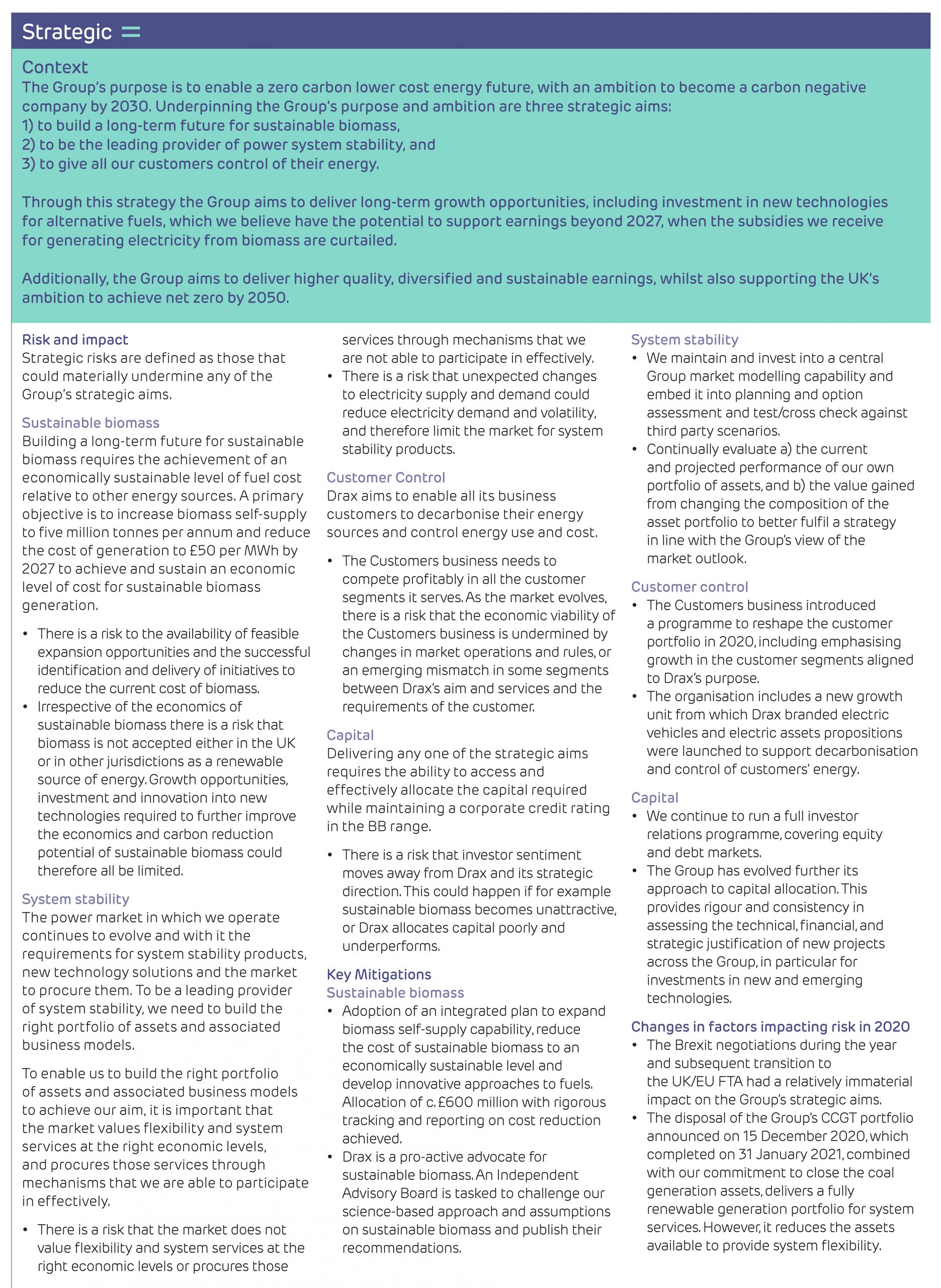
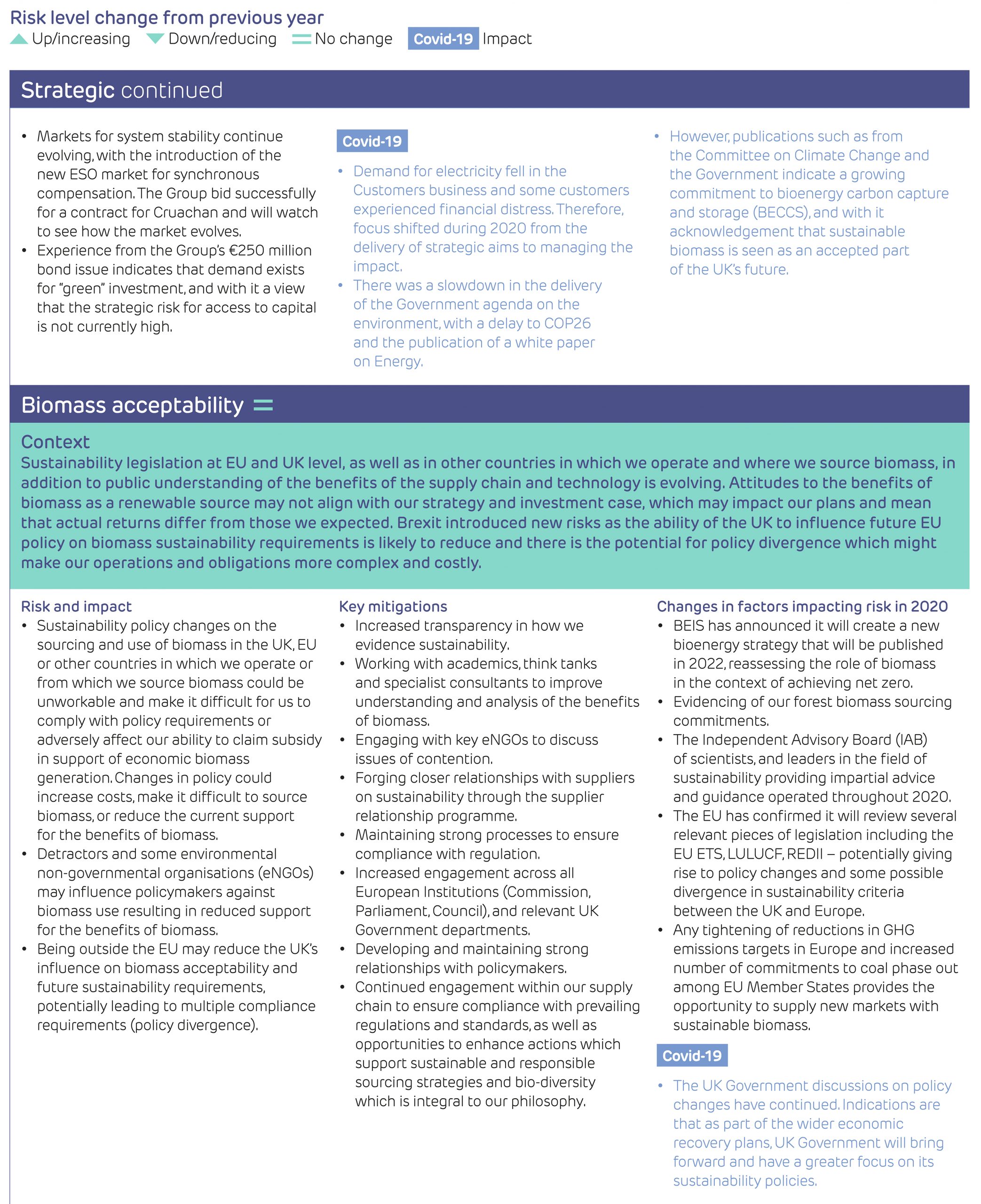
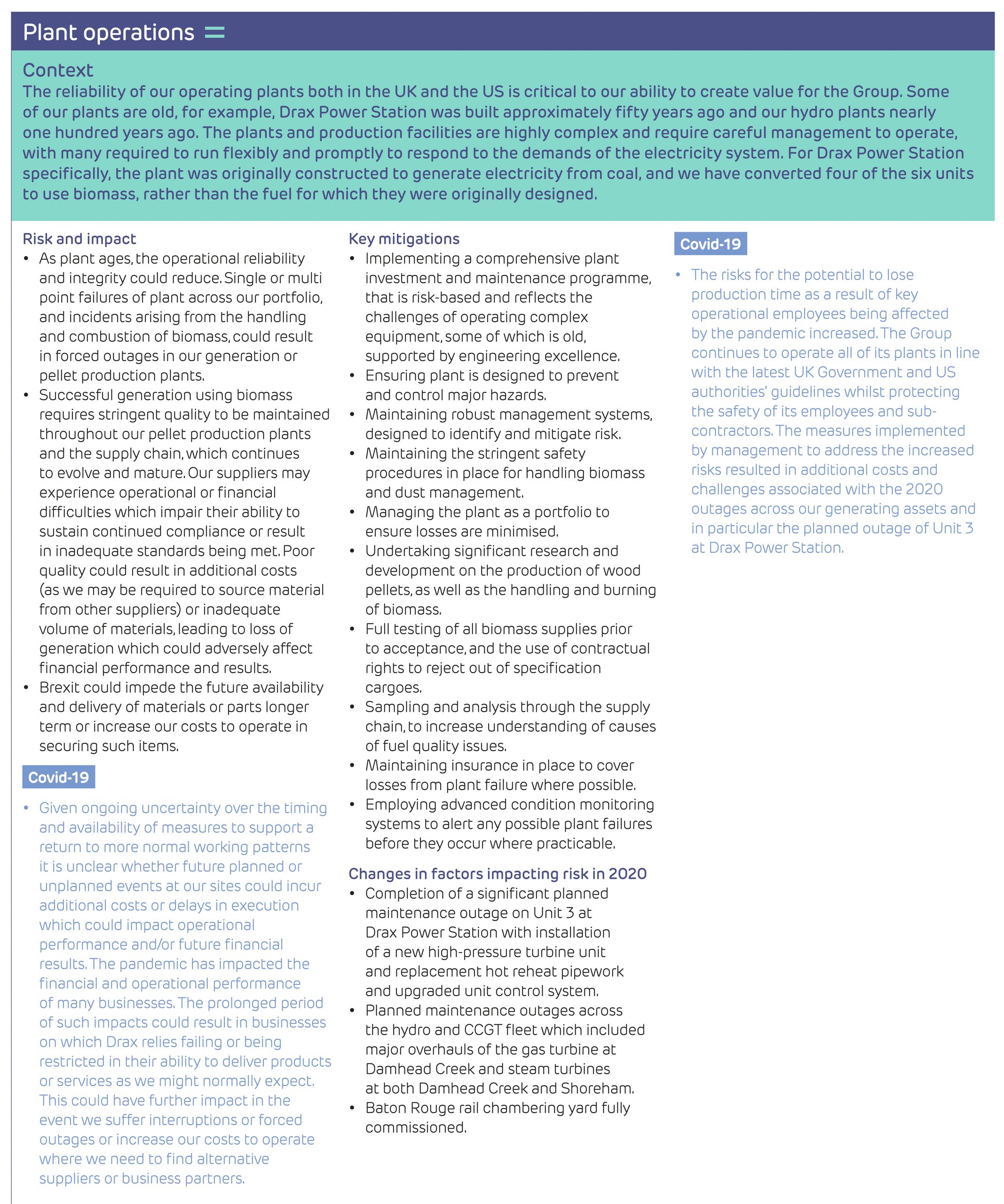
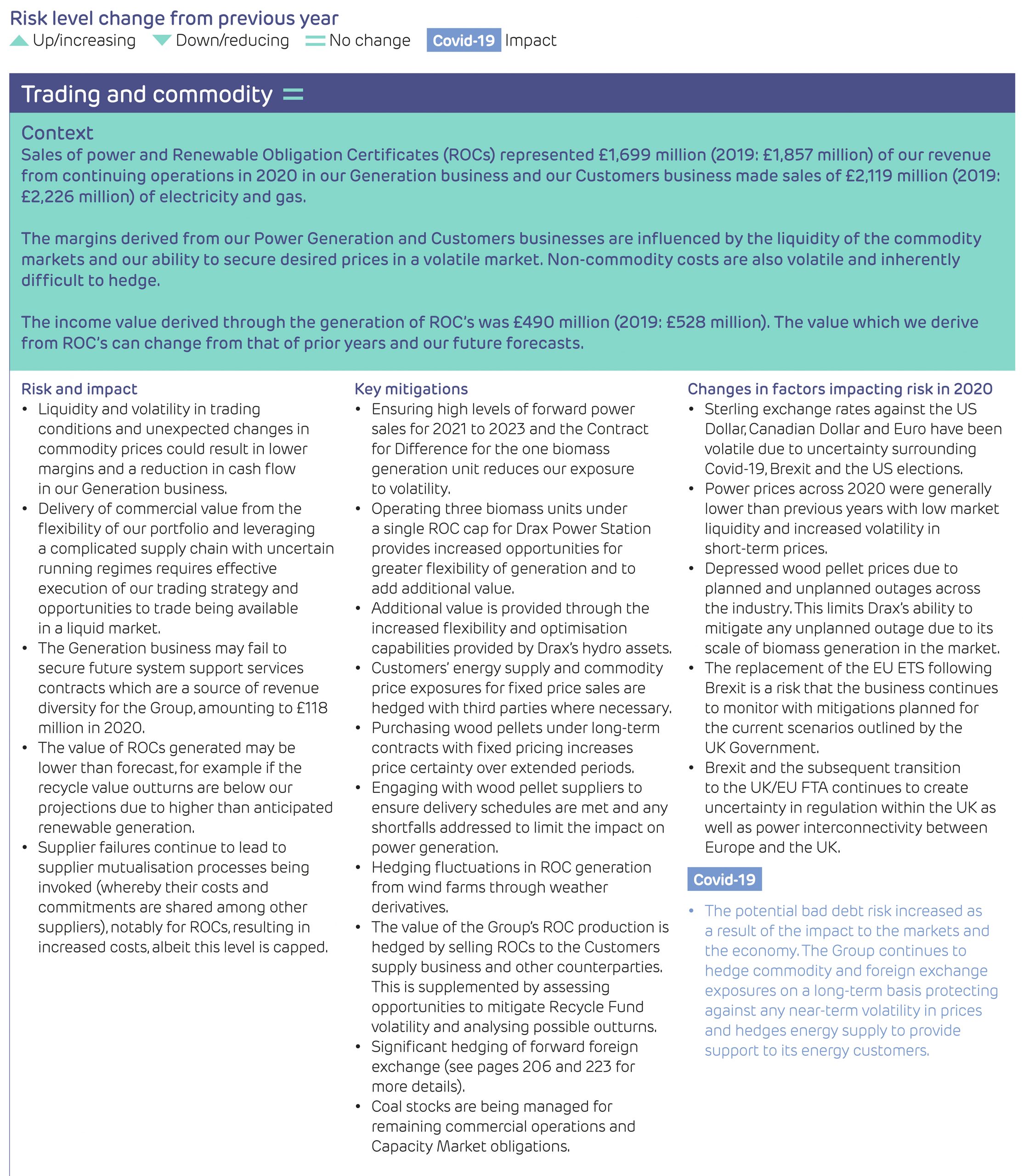
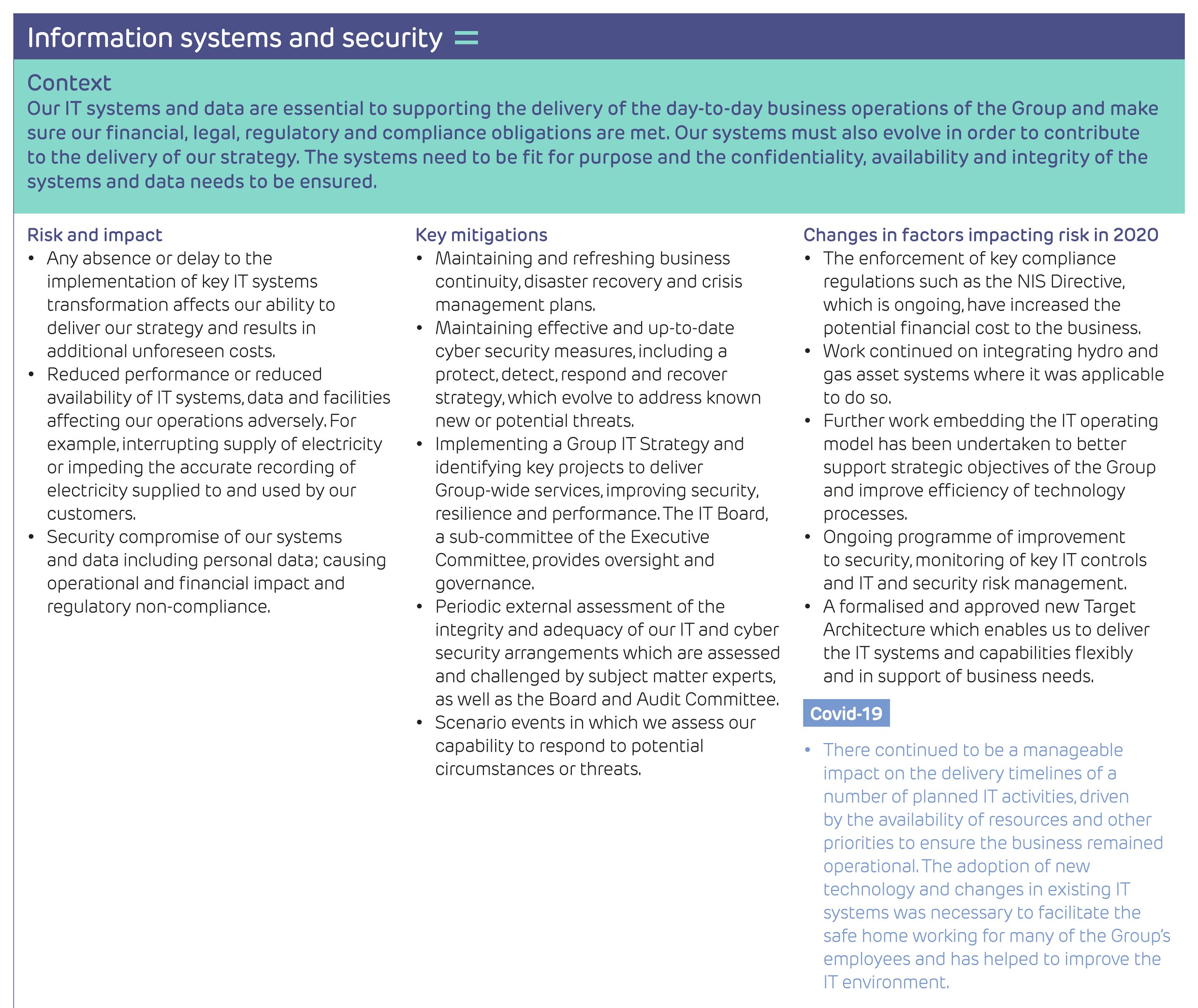
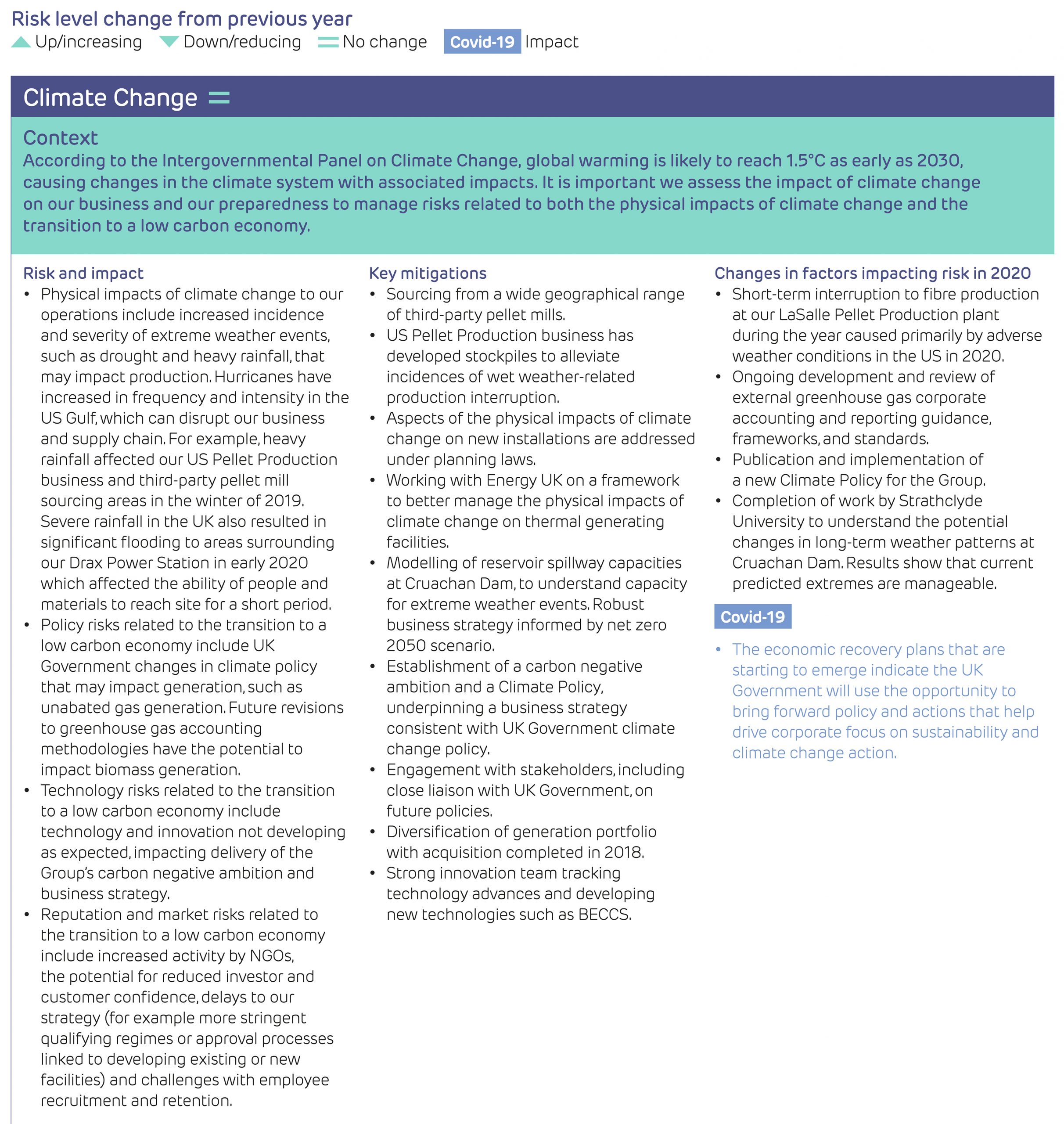
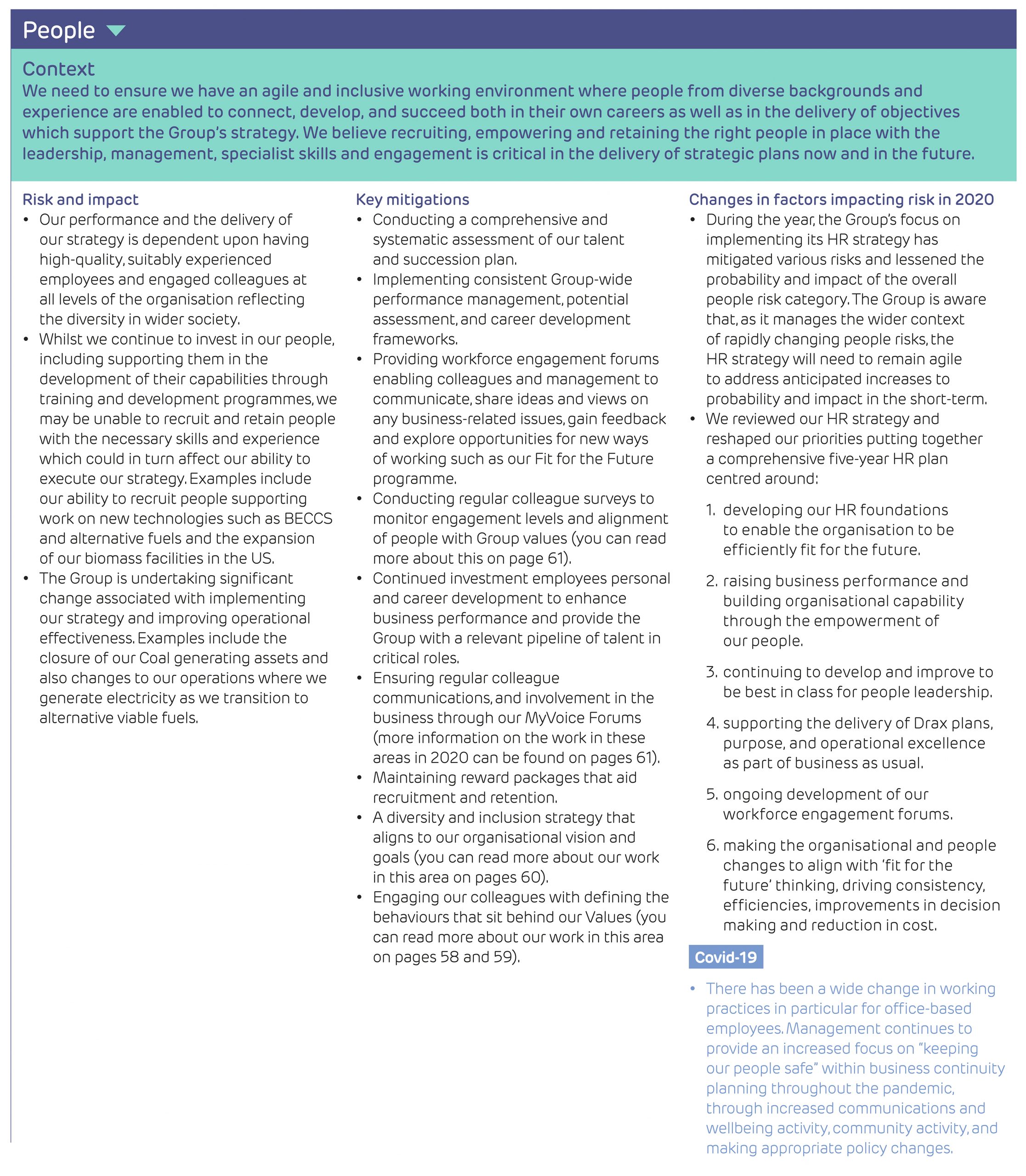
This webpage presents the Strategic Report section. View the full Drax Group plc Annual Report and Accounts PDF.







